Youth Exchange Reports
Preparatory trip in Israel-Palestine in March 22
After arriving at Ben Gourion Airport shortly after 9am, passport control was now much easier and faster than on our previous trips to 2019, thanks to machine readers for passports and issuance of blue visa cards on entry and exit, as well as the elimination of nonsensical and lengthy questioning by security officers. The PCR test at Tel Aviv airport was also done very quickly, so we were able to meet our minibus driver Husam without much delay, who – due to the lack of tourism – still drives a cab for the time being and was available to us throughout our stay whenever we needed him.
We first drove to Jerusalem to the Birgittine Convent on the Mount of Olives, where we were warmly welcomed by the 6 remaining sisters, who once again thanked us profusely for our donations of over €20,000, which they used to repair their heating and air conditioning systems and help their second convent in Bethlehem.
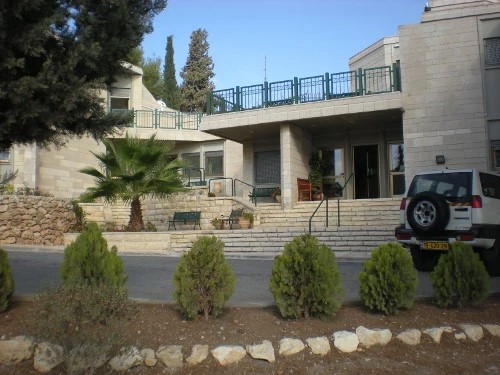
Birgittine Convent on the Mount of Olives
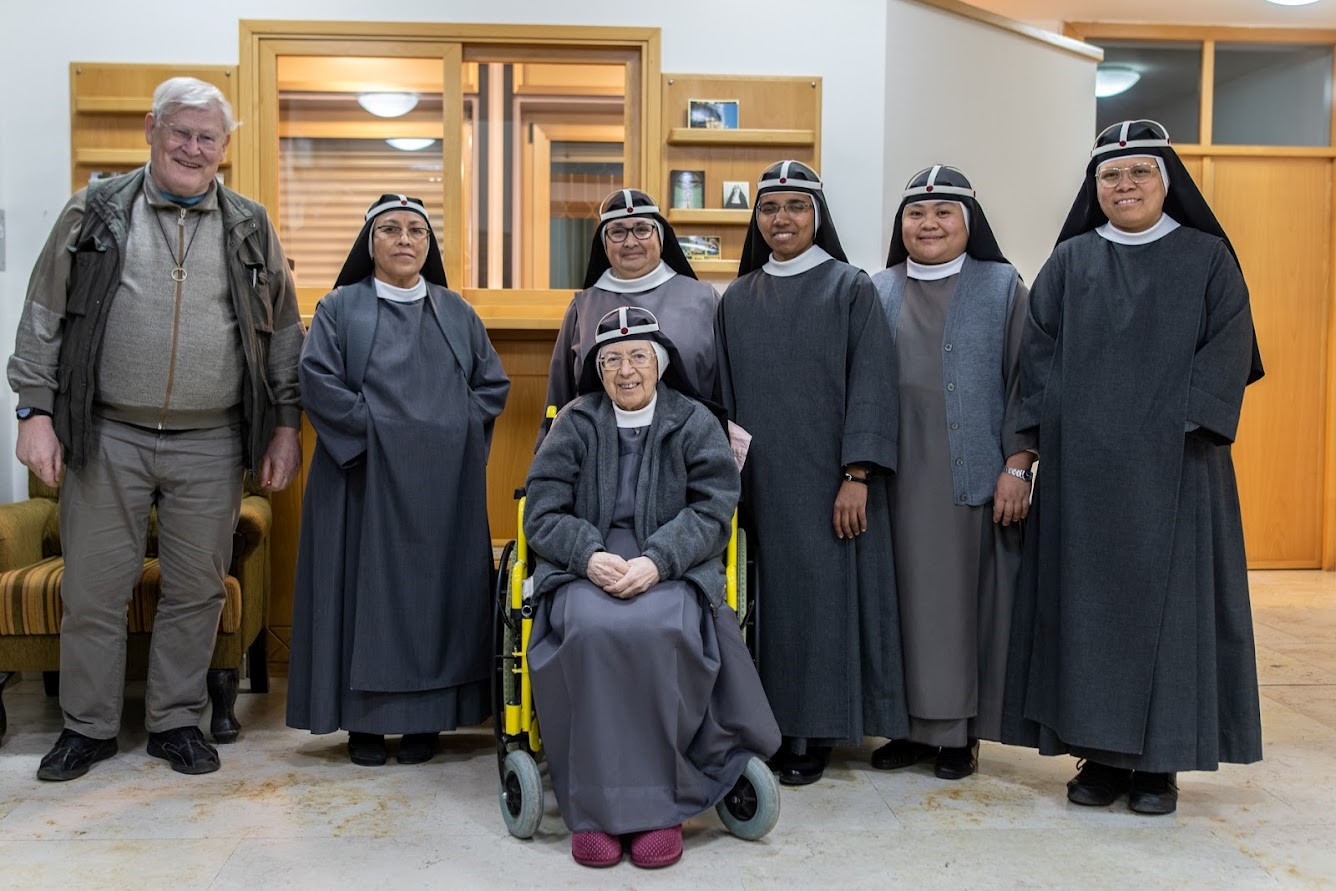
The Birgittines (in front in wheelchair: former Superior Teresa)
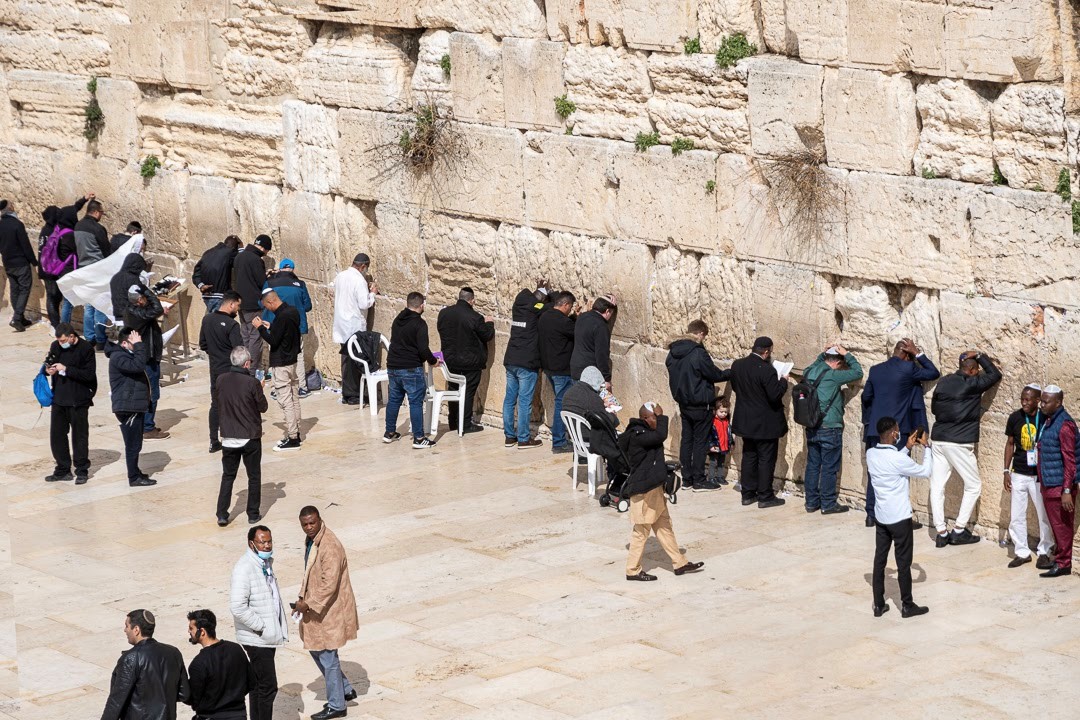
Jerusalem: Western-Wall
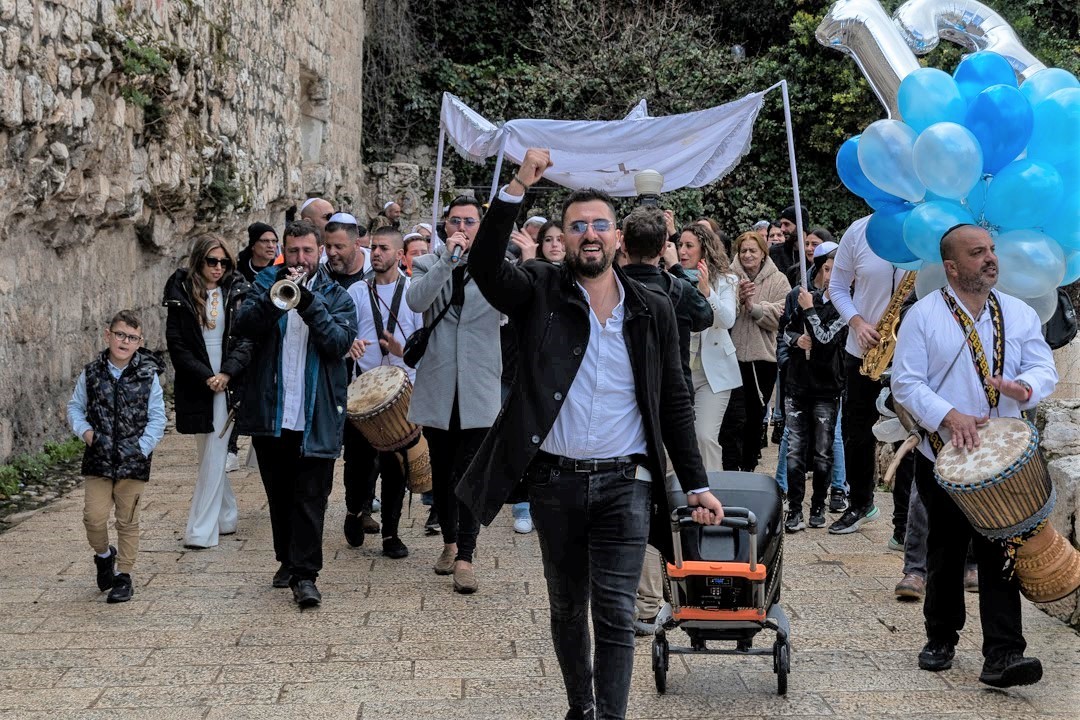
On the way to the Western-Wall for Bar Mitzvah celebration
After checking in, I showed Roland some of the central sights of the Old City that have been very familiar to me for many years (Souk, Temple Mount, Wailing Wall, Lions Gate, Damascus Gate, Via Dolorosa, Austrian Hospice – an elevated oasis of tranquility with gastronomy in a wonderful garden surrounded by palm trees and cacti -, Church of the Holy Sepulchre and the Redeemer, Cenacle, David’s Tomb, the tomb of Oskar Schindler, etc.). Before the conversation with Father Simeon in the Dormitio Abbey, we wanted to visit the church with the crypt. However, since these (as well as the cafeteria and souvenir store) were closed for renovation, we literally stood in the rain for a while due to the cold and wet weather, until Father Simeon welcomed us very warmly (during the entire trip it was quite cool and only partly sunny. But in October during our exchange it is always very warm and dry).
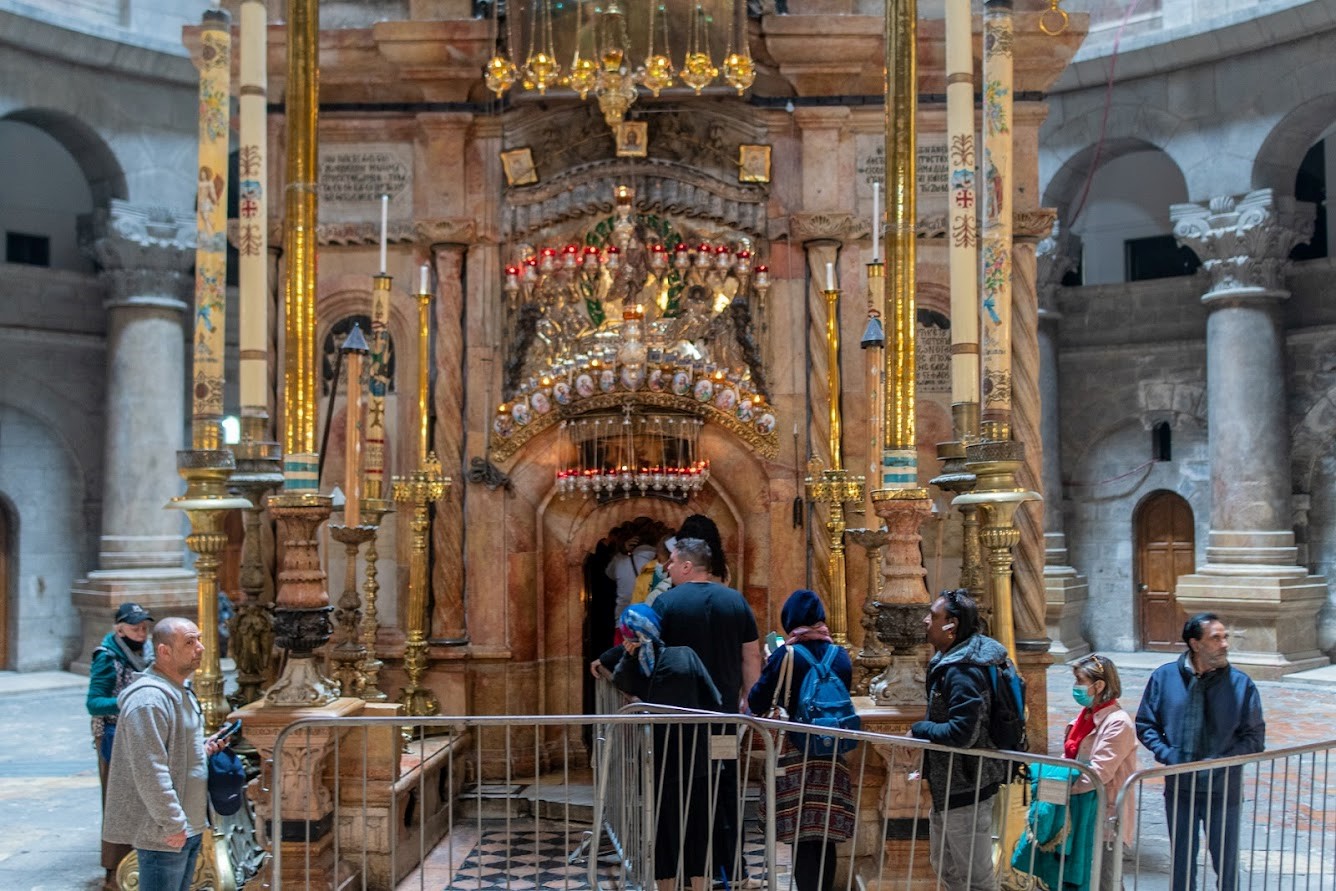
Church of the Holy Sepulchre in the Old City: Entrance to Jesus’ Tomb
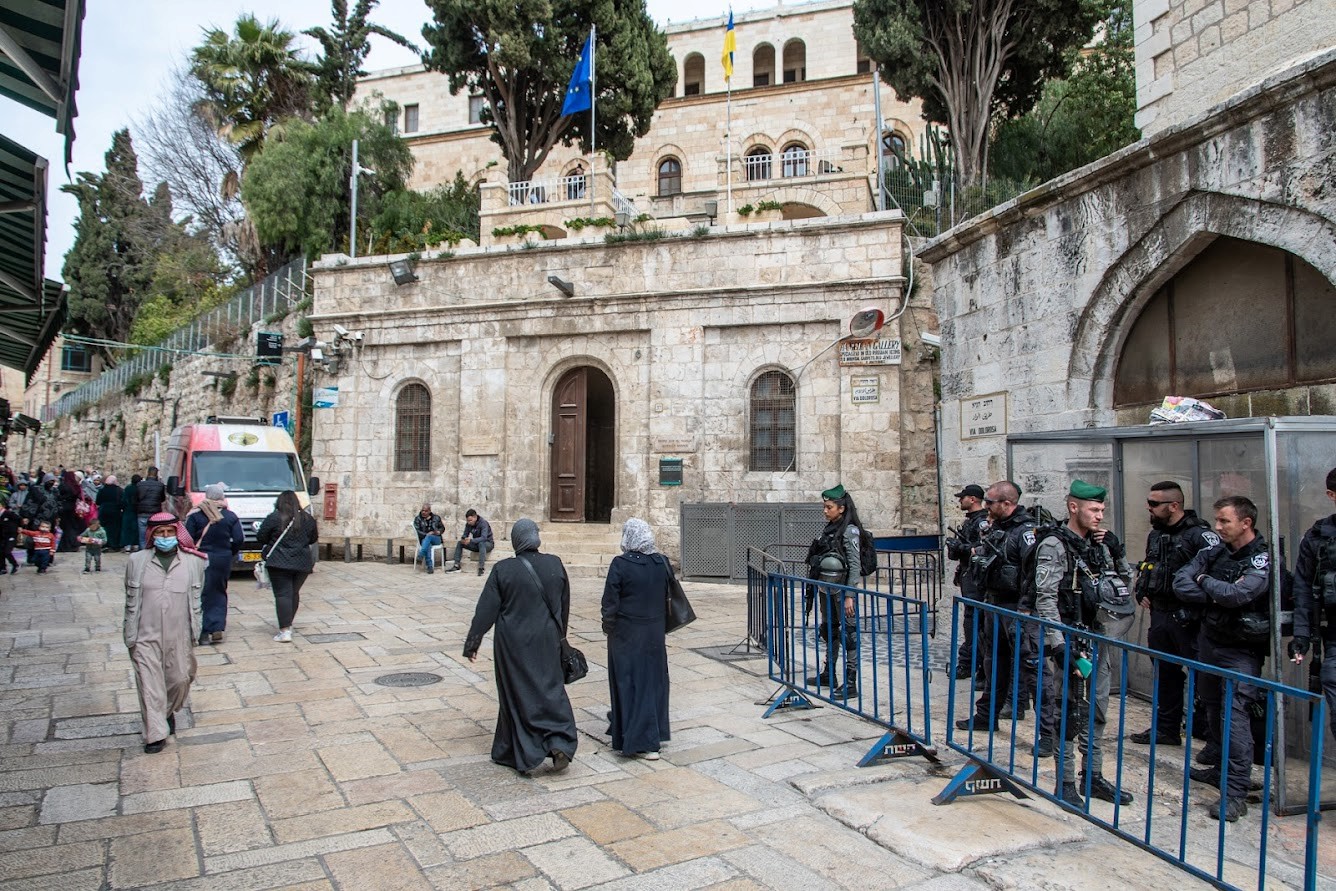
Via Dolorosa: View of Austrian Hospice
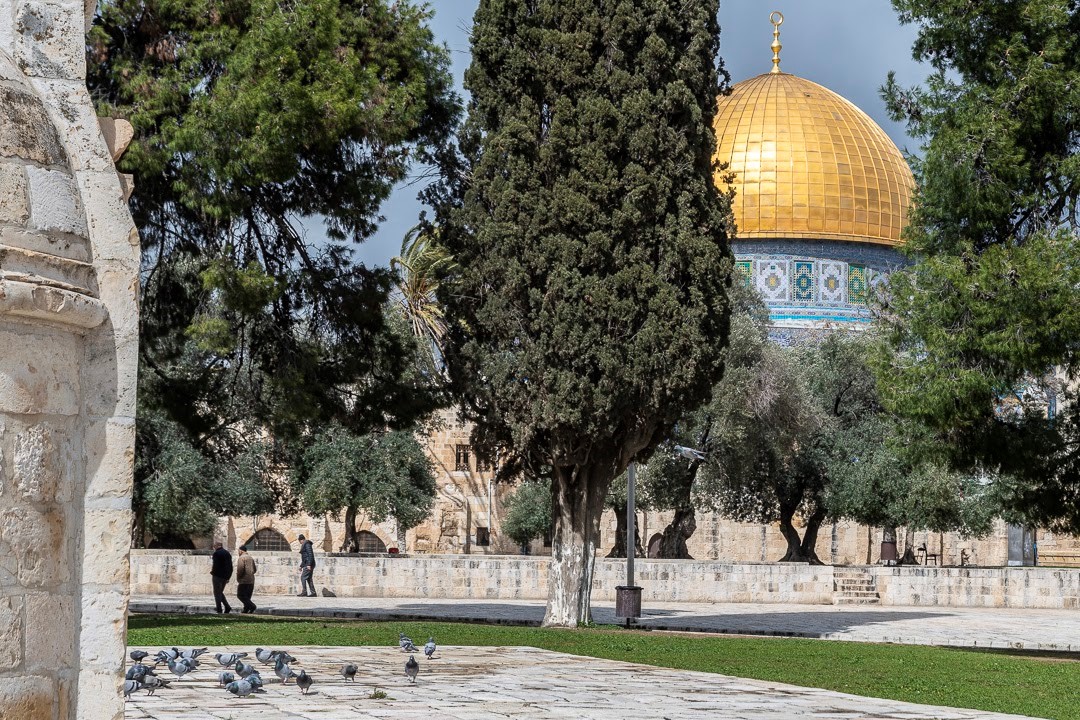
Jerusalem Temple Mount with Dome of the Rock
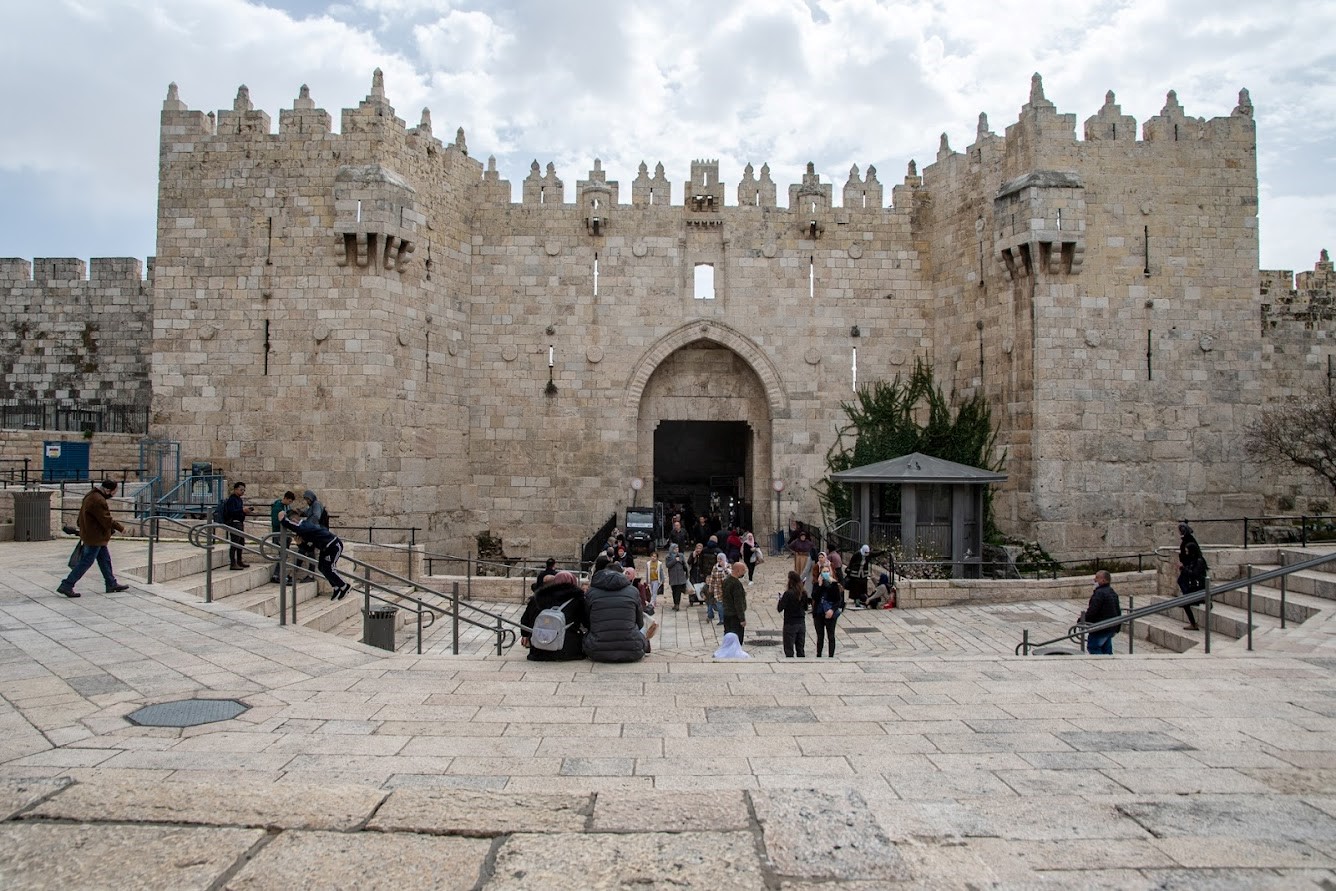
Damascus Gate: Entrance to the Muslim Quarter
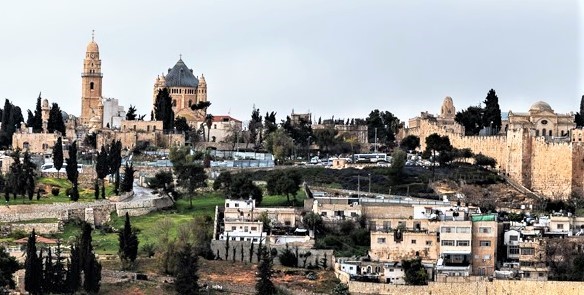
View of the old town and Dormitio Abbey (far back)
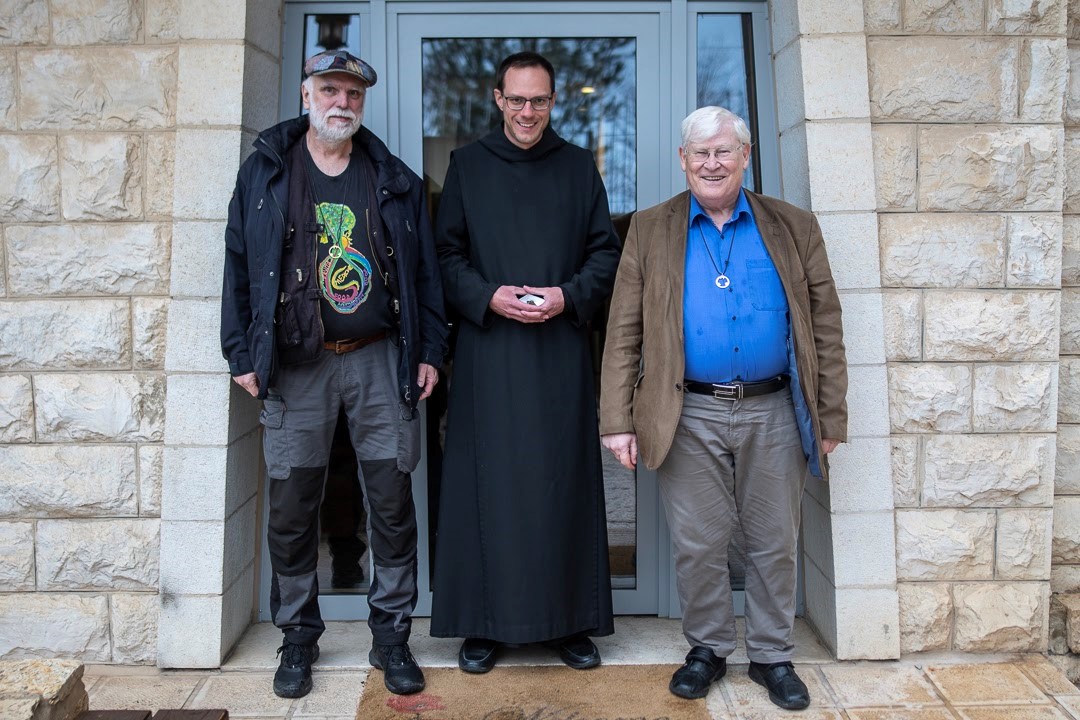
Roland, Father Simeon and I in front of the Abbey
In the evening we went to Abraham’s House in East Jerusalem (with a great view of the Old City and the Mount of Olives), a former Benedictine monastery, which is now run as a pilgrimage hotel by the French Caritas and Dominican nuns, where we had dinner with Husam and Angela Goldstein (British Jew who has lived in Israel for a long time and works with her organization against the destruction of houses and the expulsion of Palestinians and Bedouins, www.jahalin.org ) and talked about our projects, activities and plans. Afterwards we went back to the Birgittine Convent, where we spent the night.
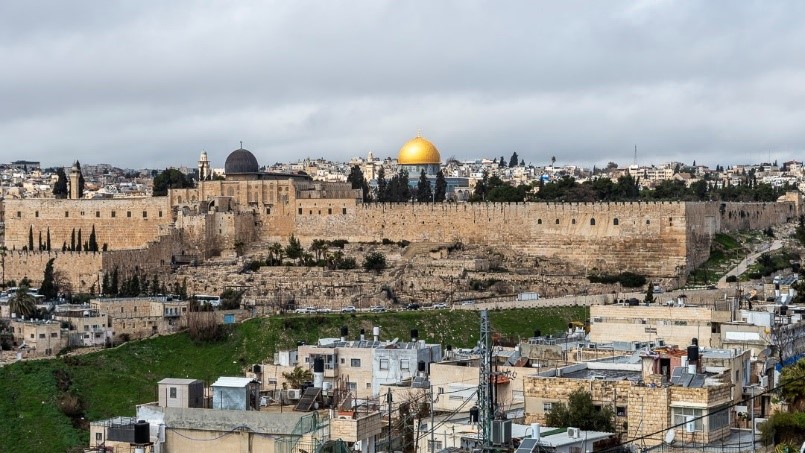
View of old town from Abraham’s house
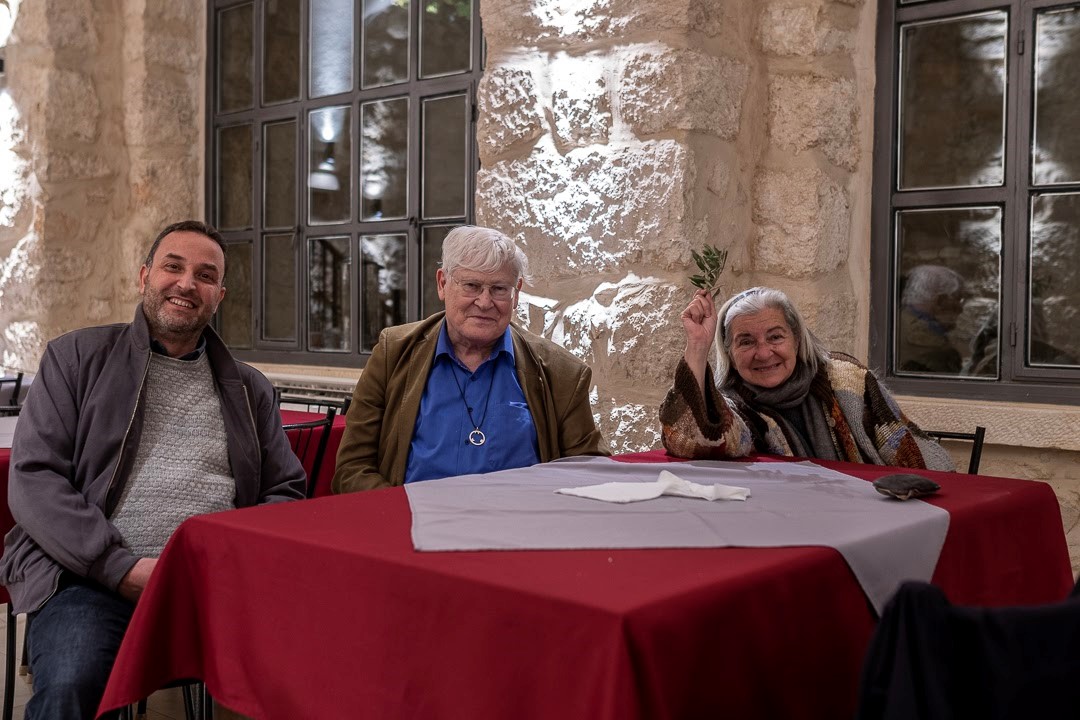
Our driver Husam and Angela Goldstein
The next day, in the morning, we first visited the Catholic University in Bethlehem, where we were again welcomed by Amjaad, the press officer I know well. 75% each of the students are female and Muslim, respectively. During the Corona period, no German volunteers could come. However, on our trip in October we will again meet a new German volunteer. After a brief tour of the main building, church and grounds, we met some students who told us about themselves, their studies and their career aspirations.
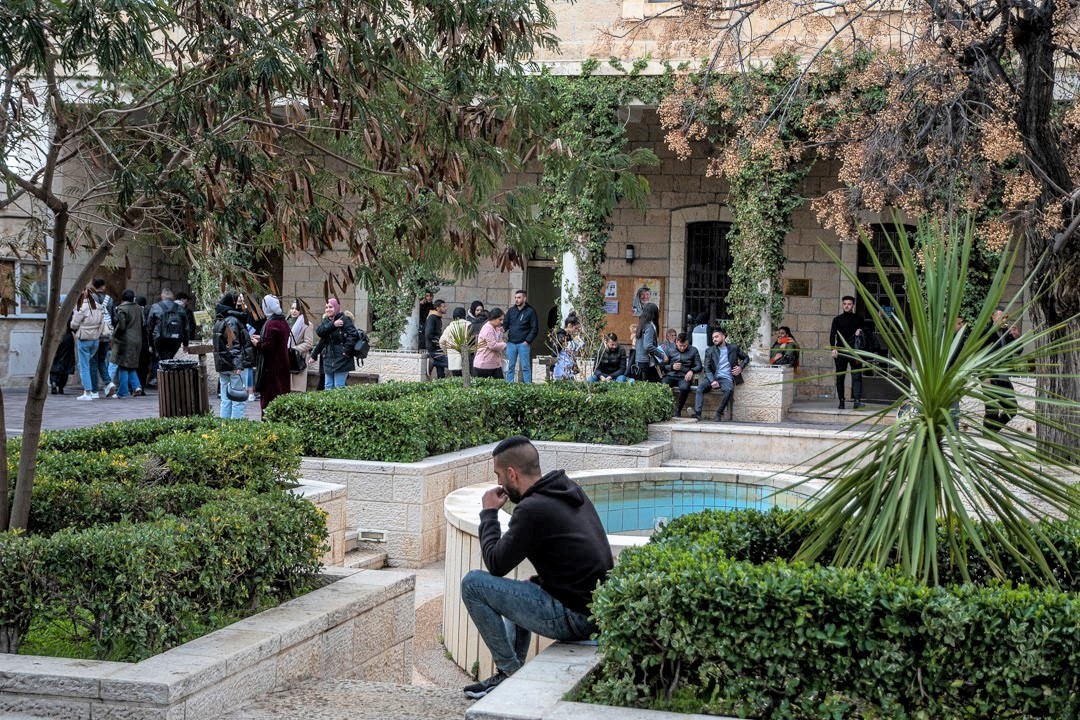
Bethlehem University: Exterior
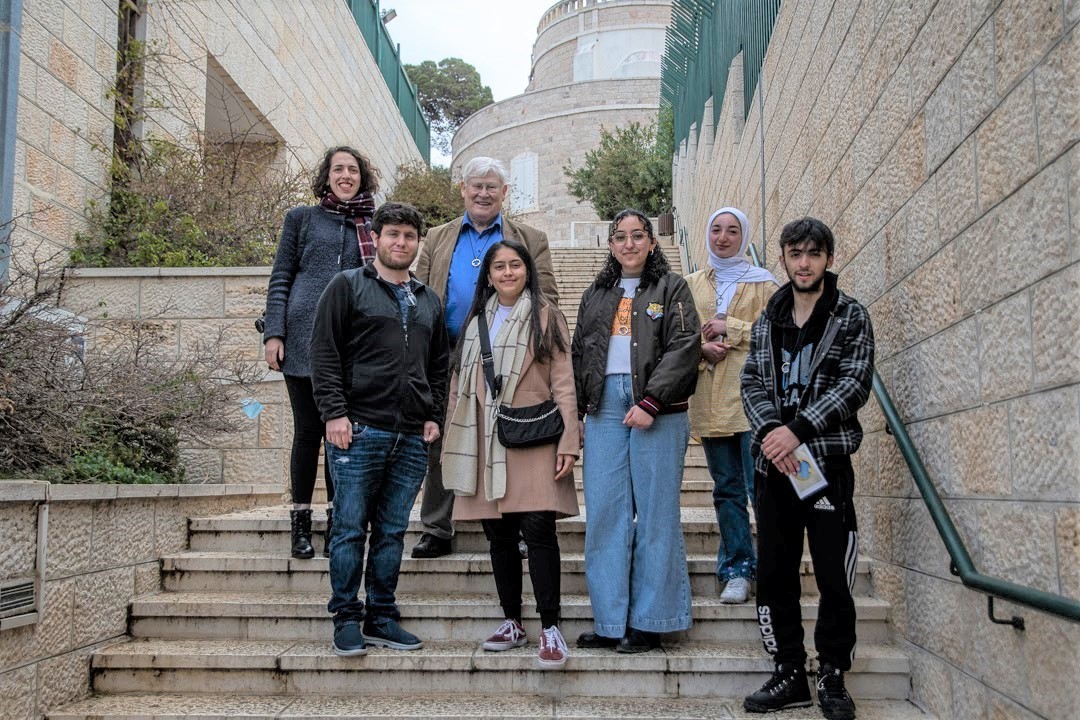
Amjaad and students of the university
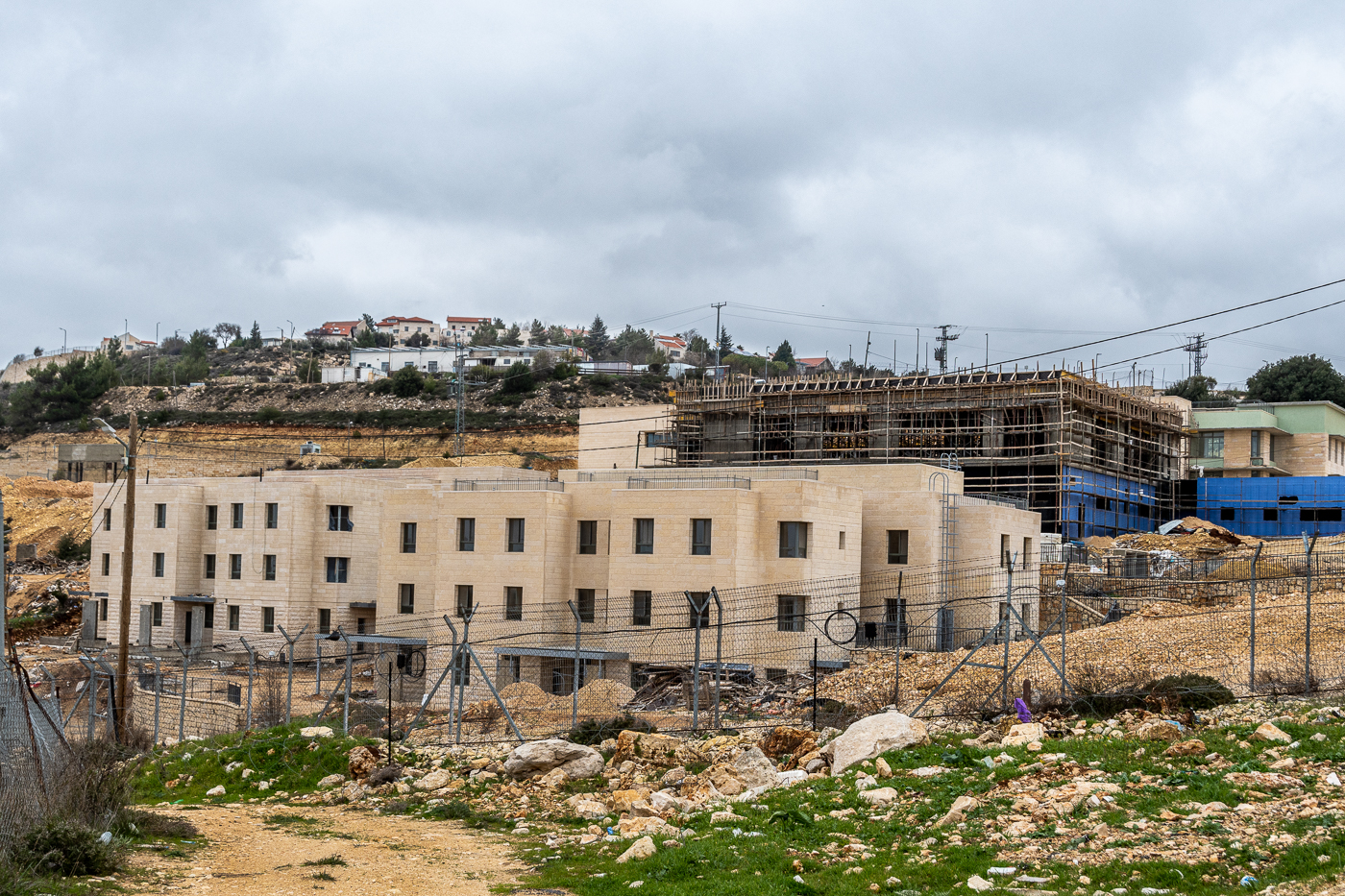
Torah school in front of ToN, settlement Neve Daniel (background)
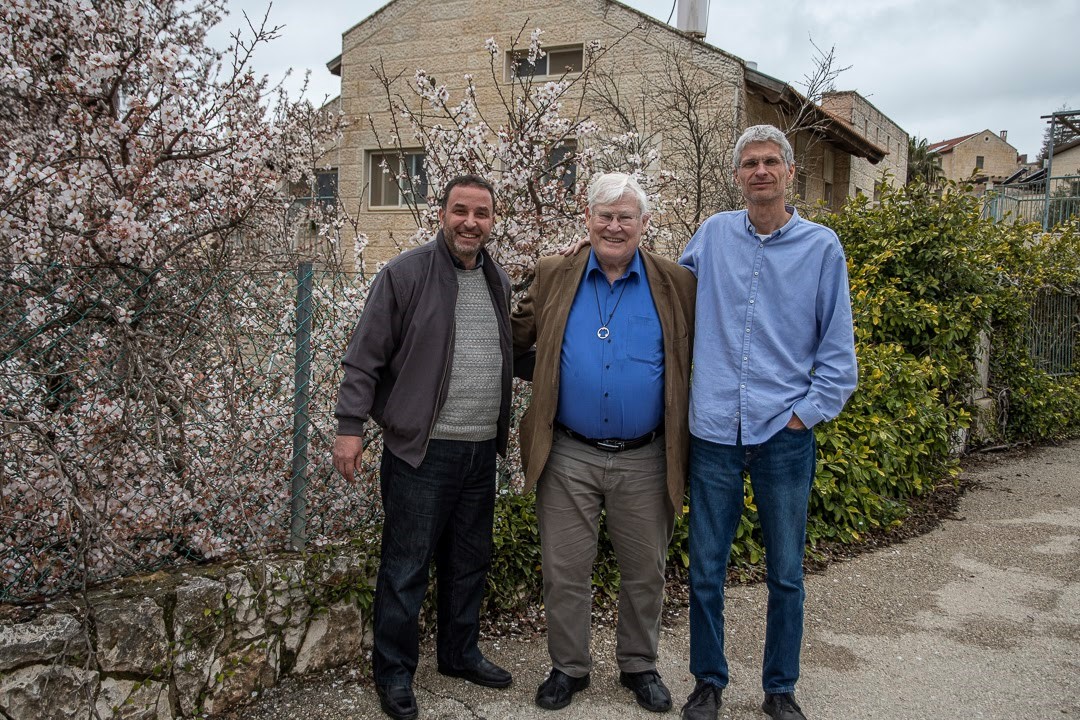
Husam + Nethanel in front of his house in Neve Daniel
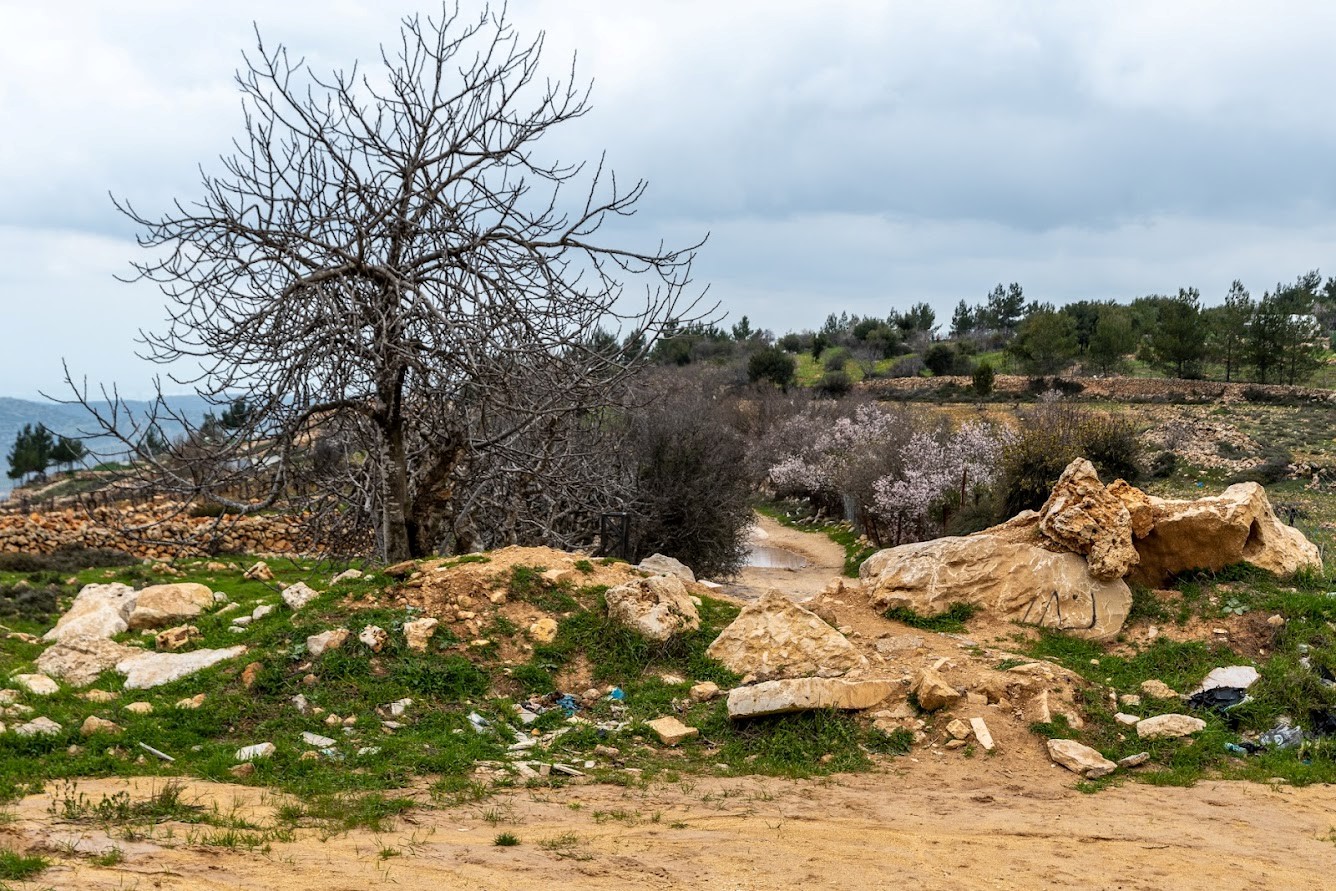
Roadblock: ToN only accessible on foot from here
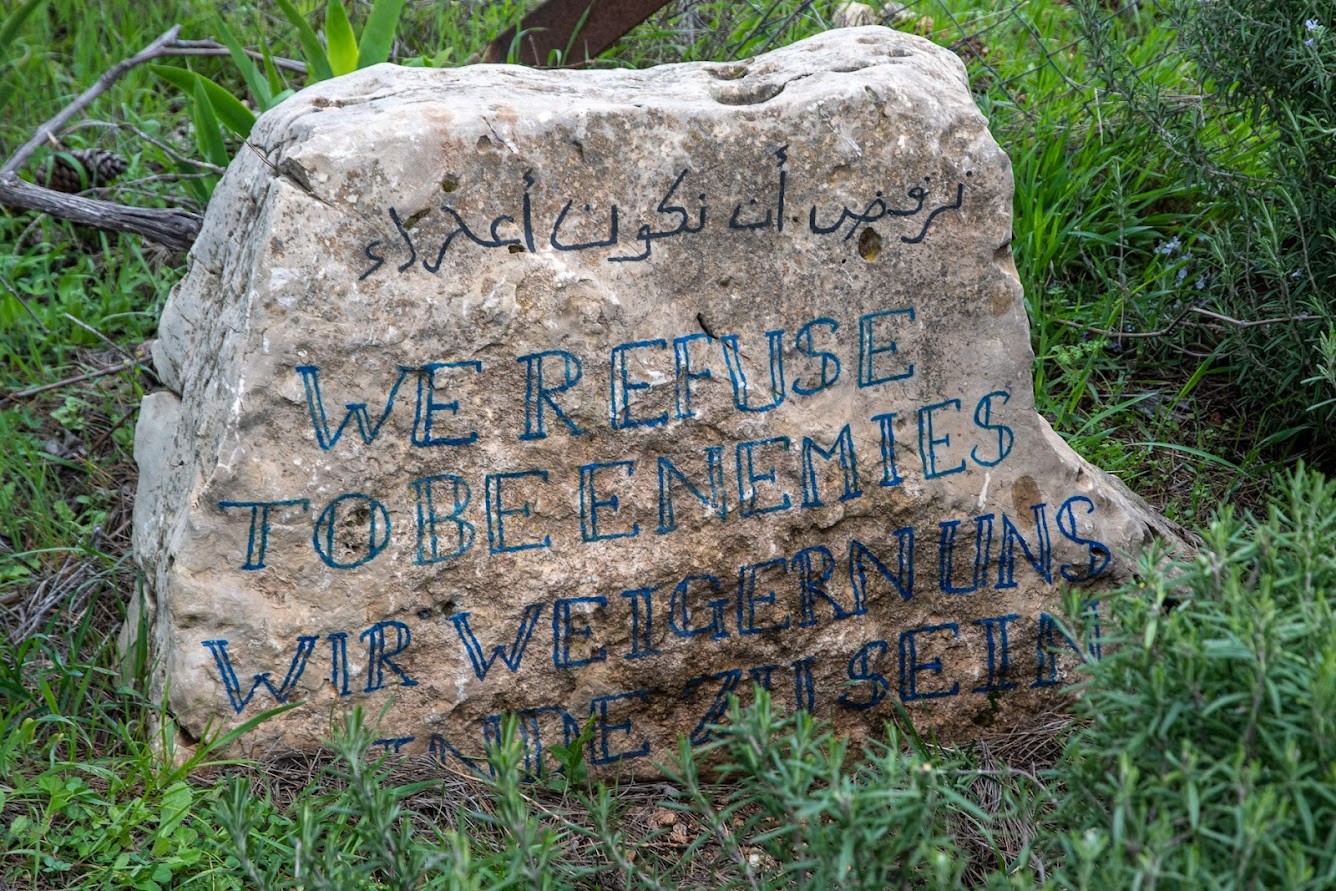
ToN motto: We refuse to be enemies
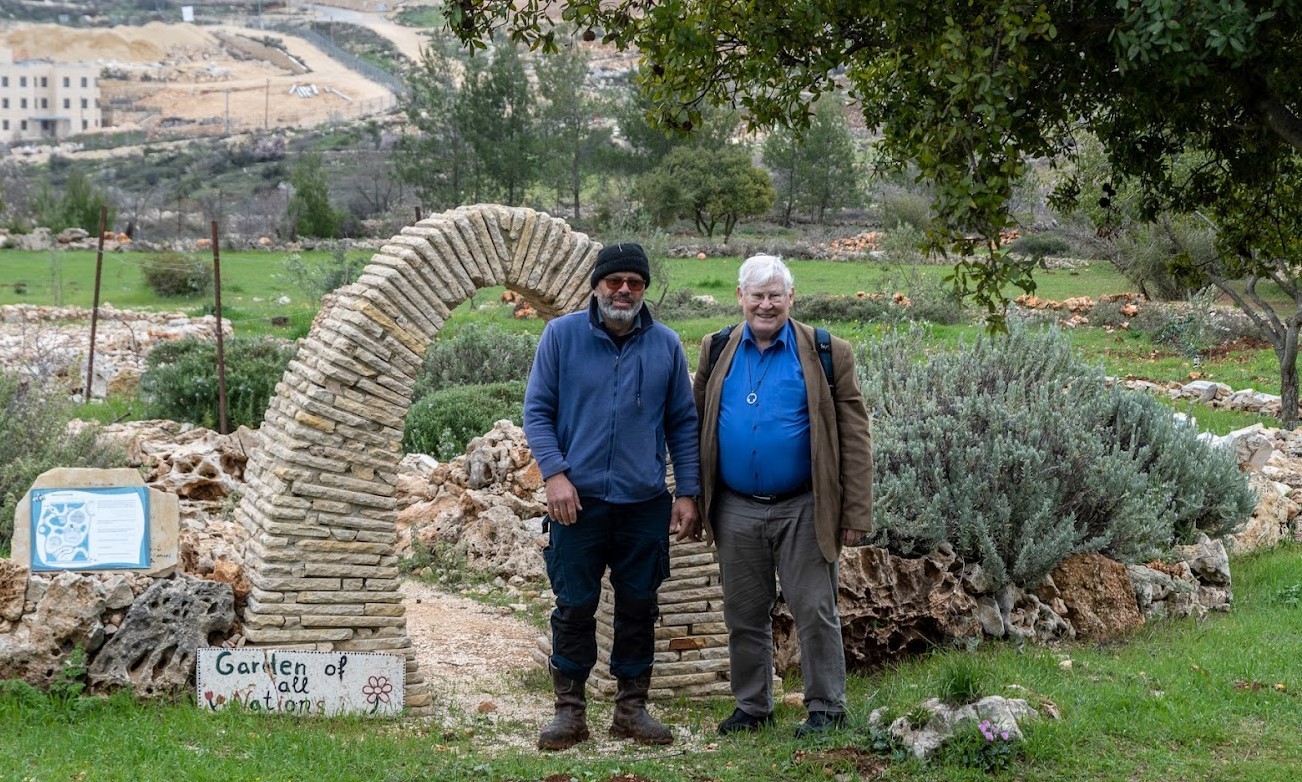
With Daoud Nassar on the ToN
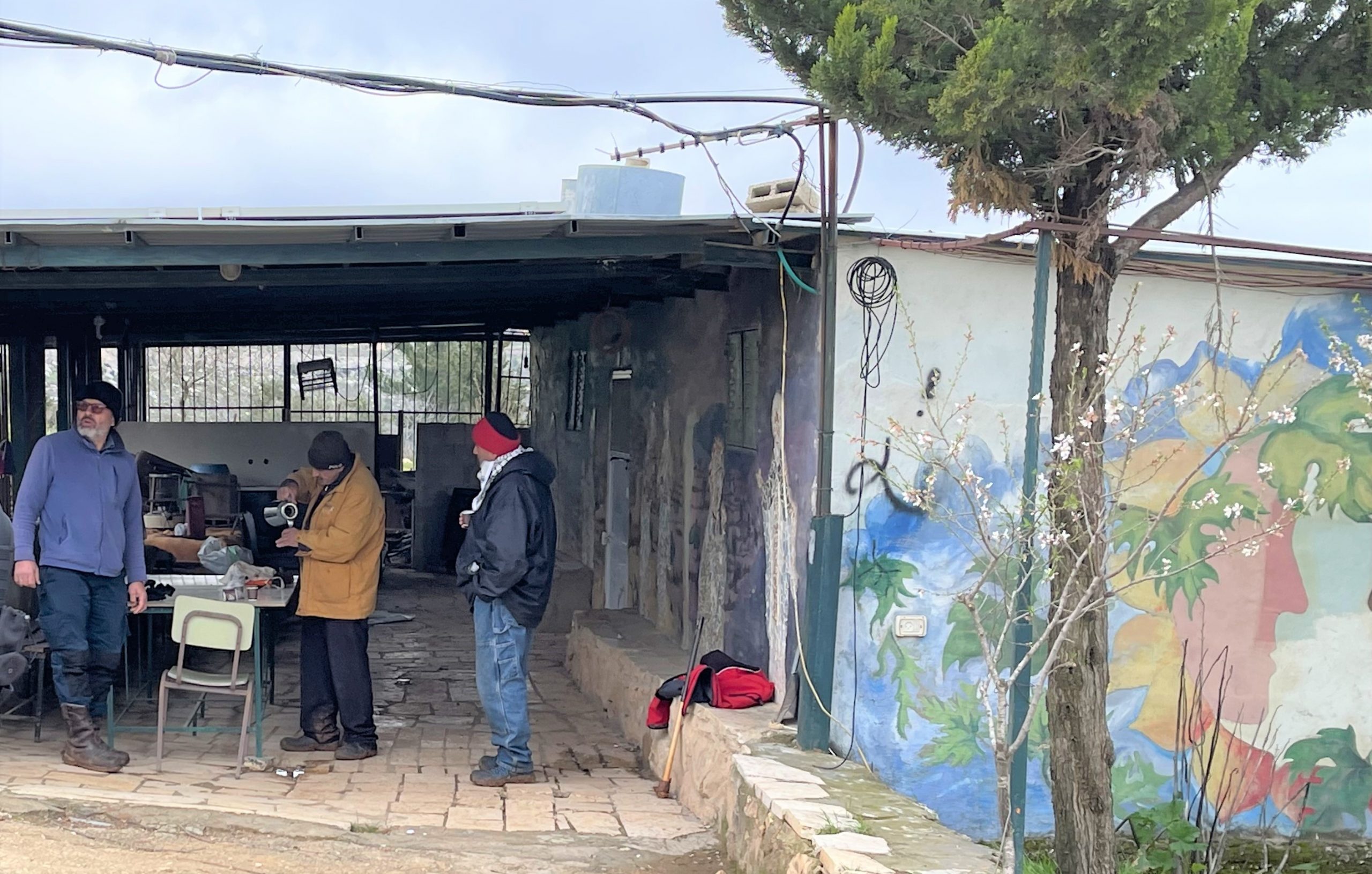
Daoud with his brothers Daher and George
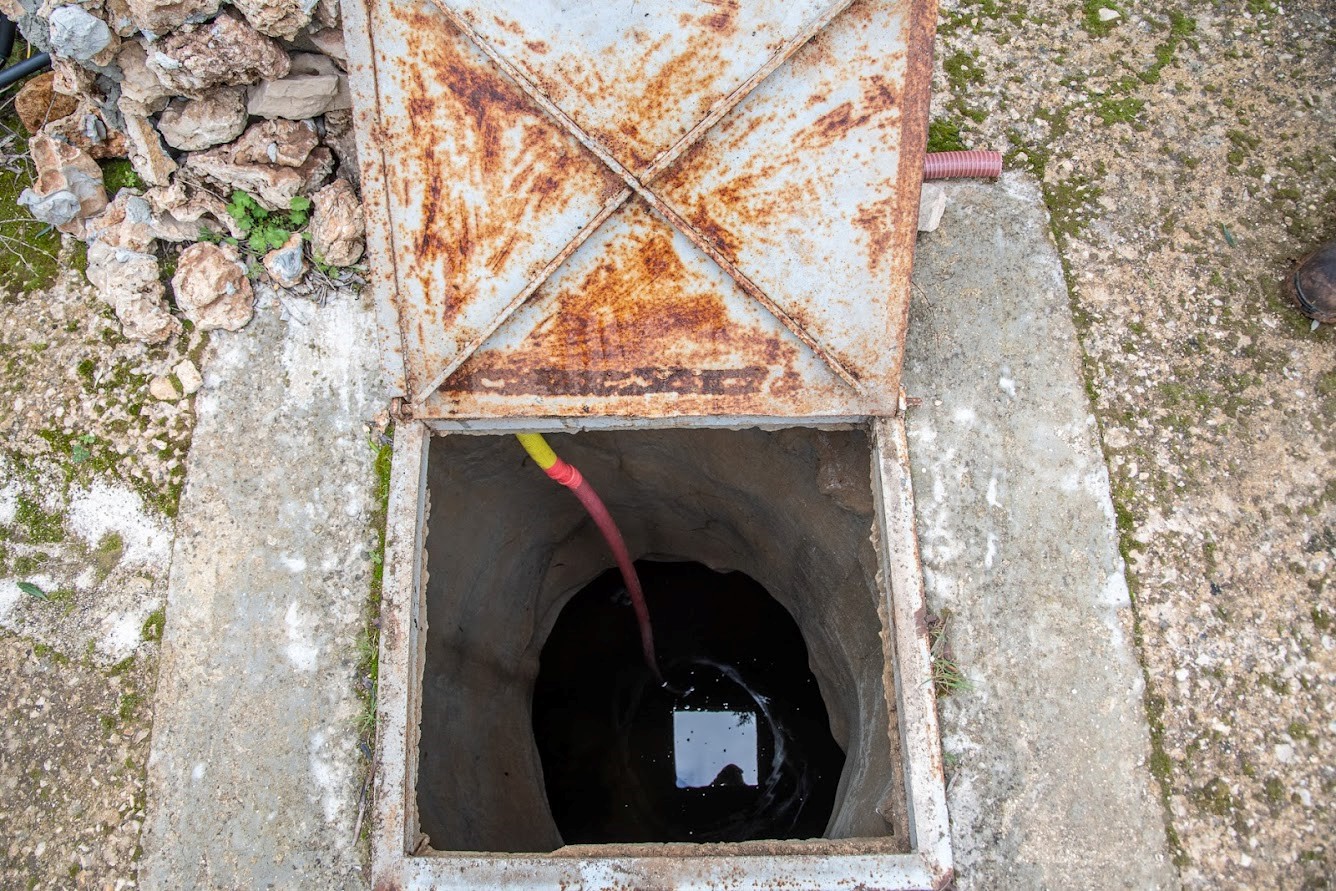
One of the many cisterns (total 500,000 liters)
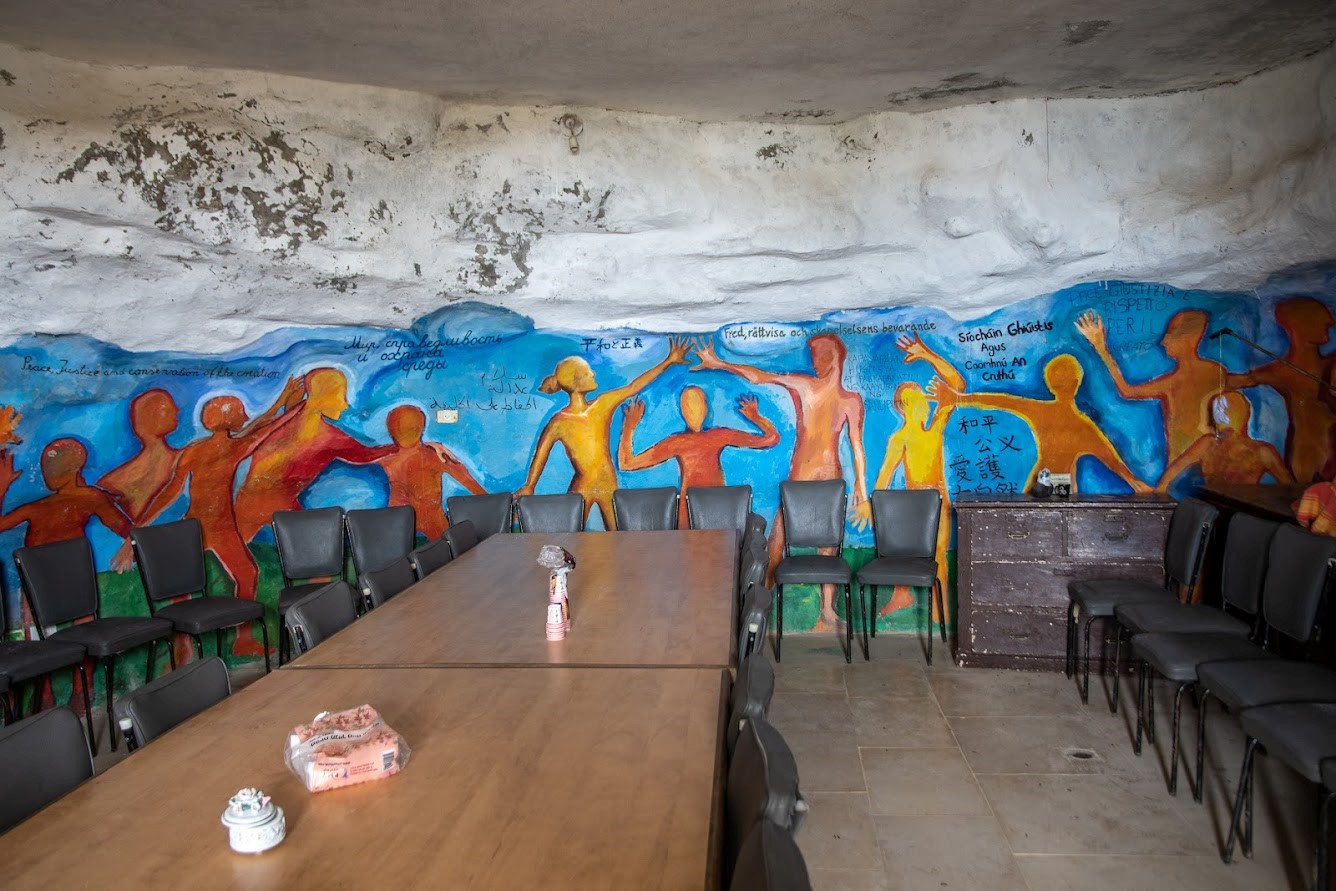
underground meeting room of the ToN
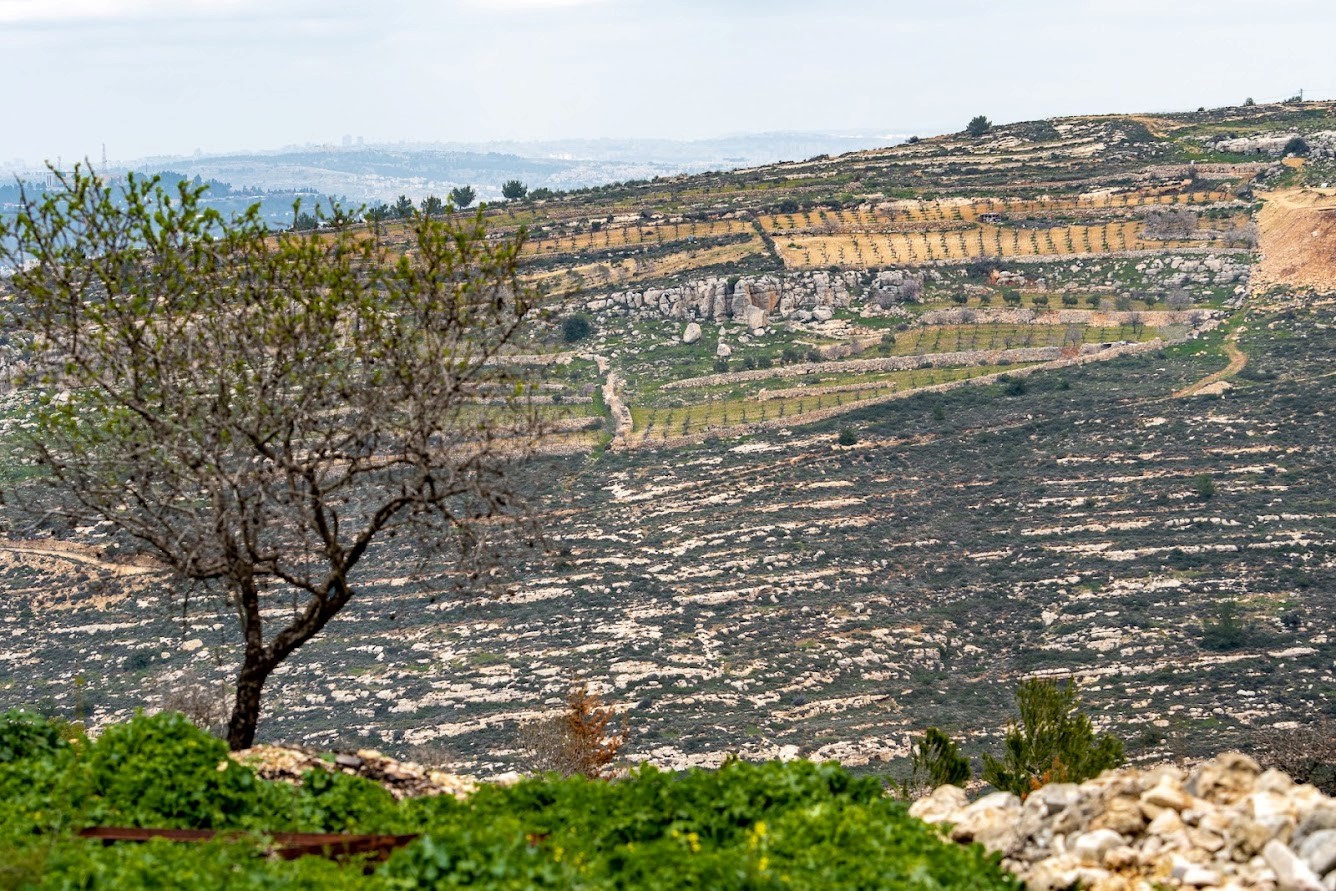
ToN: View of the thousands of burned trees
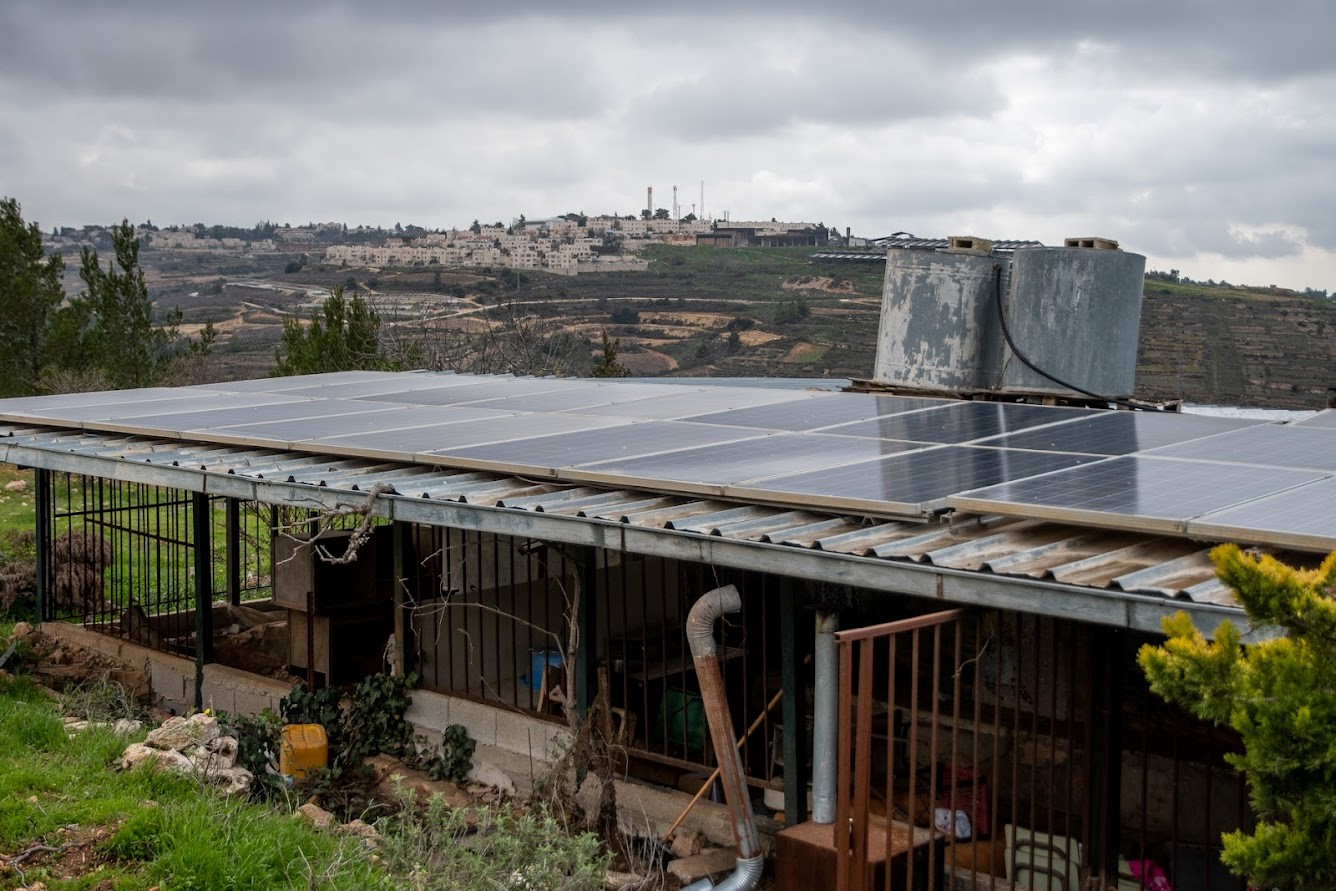
Solar panels on the ToN
Afterwards we drove to Hebron to the Abraham’s Mosque, of which we could only visit the smaller Jewish part, which was strictly sealed off by the military. The Israeli military let us also up to the Muslim entrance of the mosque, but a Muslim guard did not let us in because of the Muslim Friday (Sometimes you are allowed to enter the very beautifully painted mosque also on Fridays outside the prayer times, sometimes and this time just not). We visited afterwards still the likewise military controlled Souk (electrical revolving doors with control by Israeli military), which left as always a very depressing impression, since again – due to lack of tourism also already before Corona – over 90% of the stores were closed. Many houses are shot up or dilapidated. More and more Palestinians are therefore leaving their apartments, mostly on the upper floors, and Israeli families are gradually moving in. In this way, there are now already many newly renovated houses, over which the Israeli flag then proudly flies.
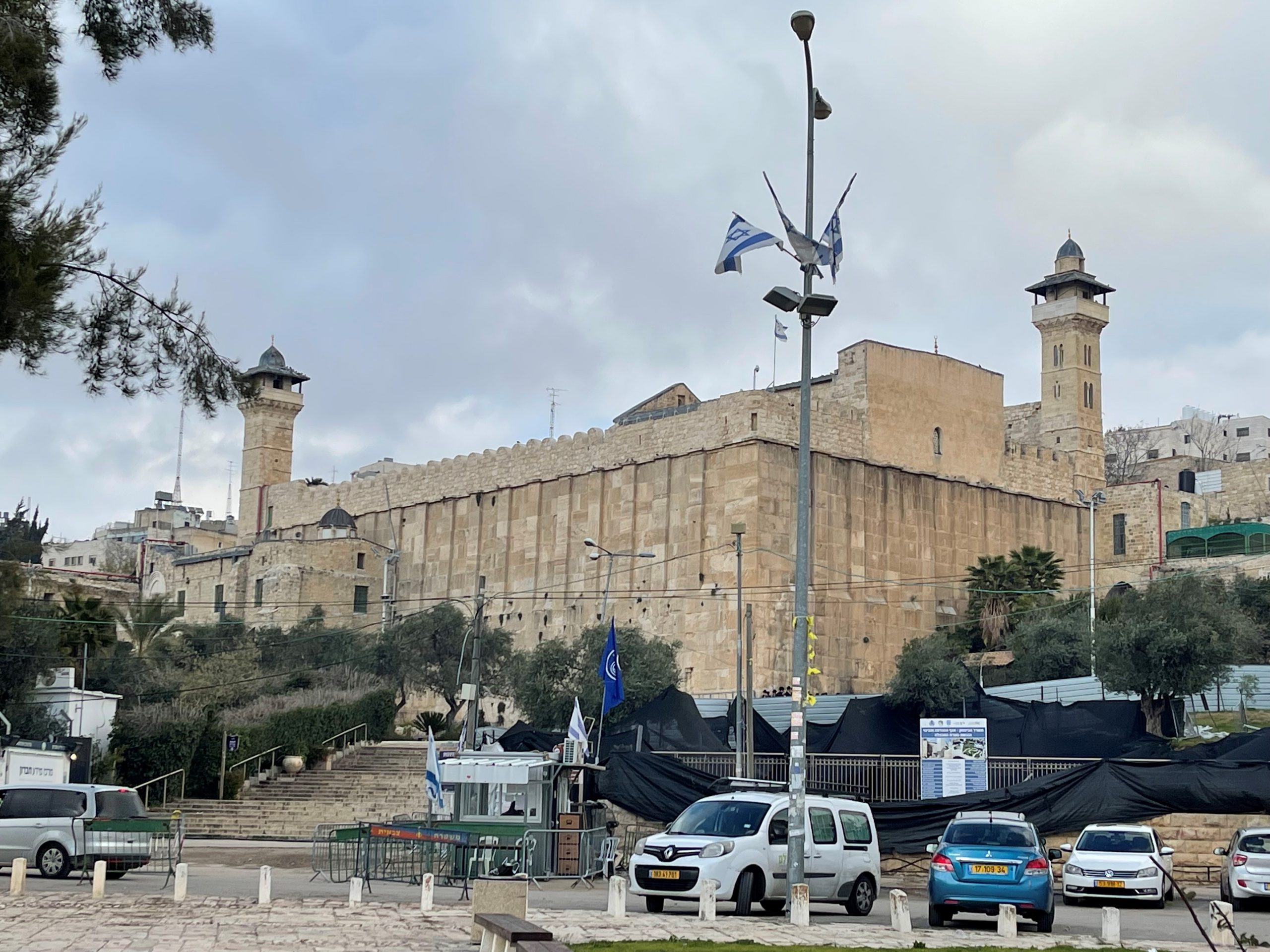
Hebron: Abraham’s Mosque
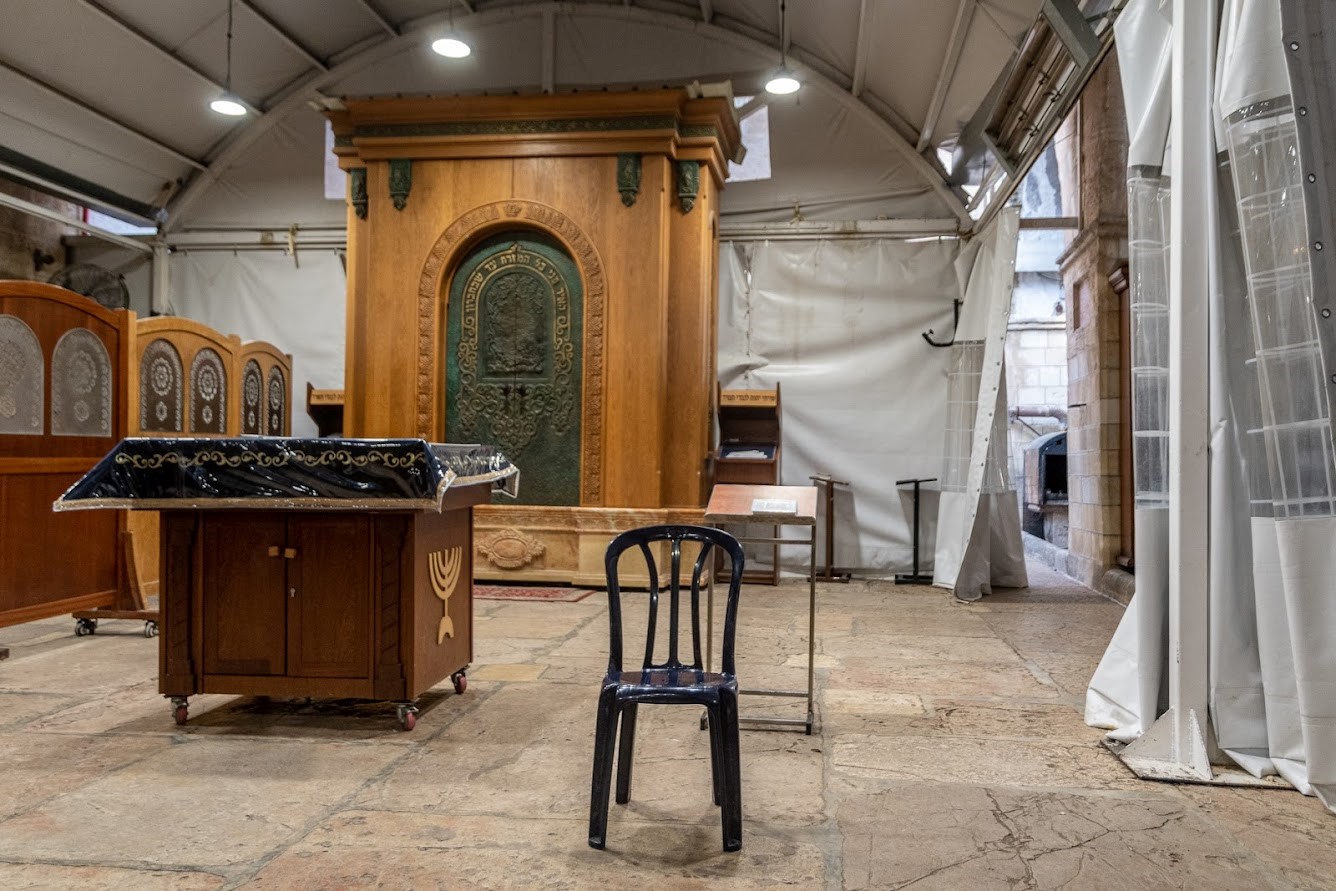
Jewish separated part of the mosque as a synagogue
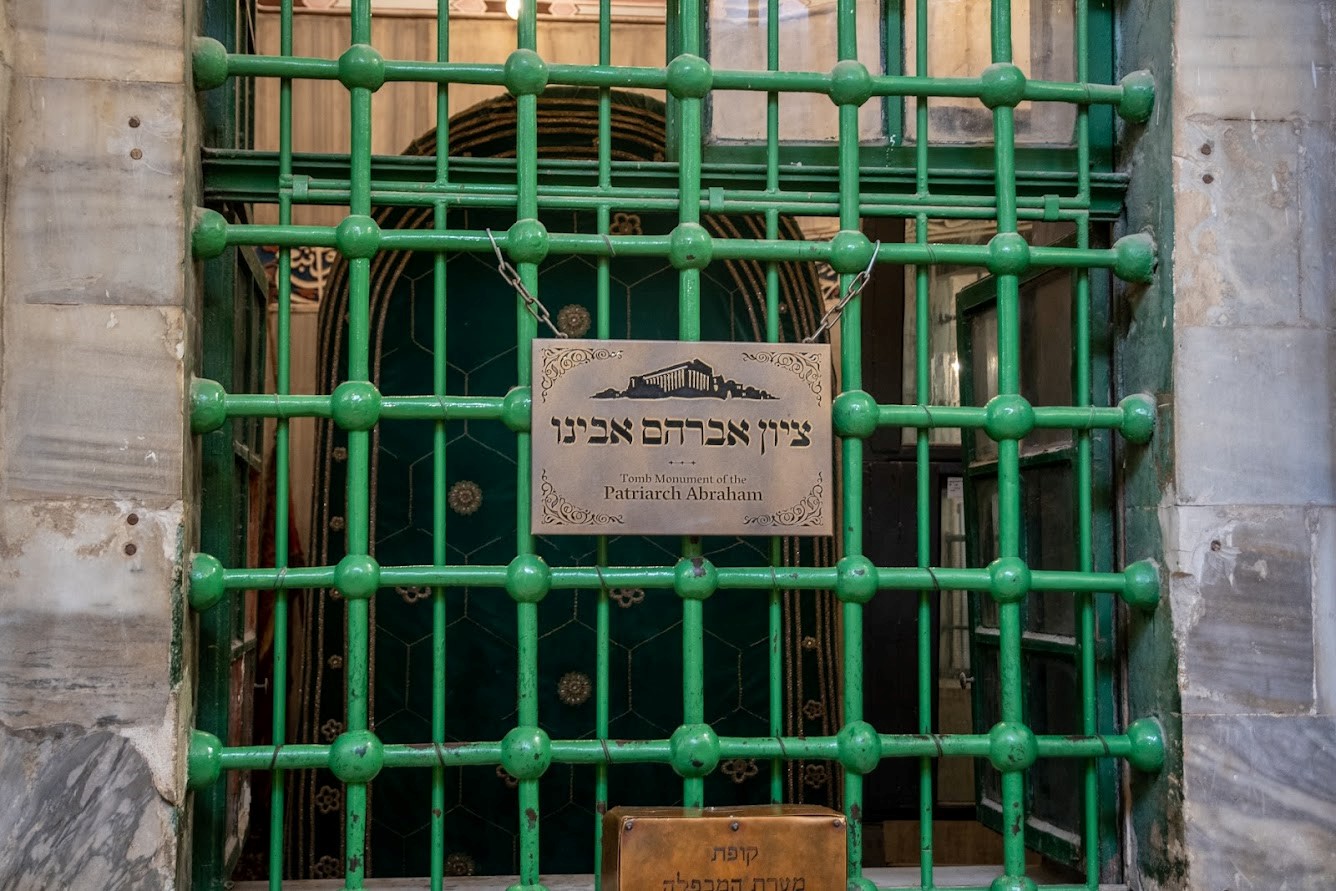
View from synagogue to Abraham cenotaph
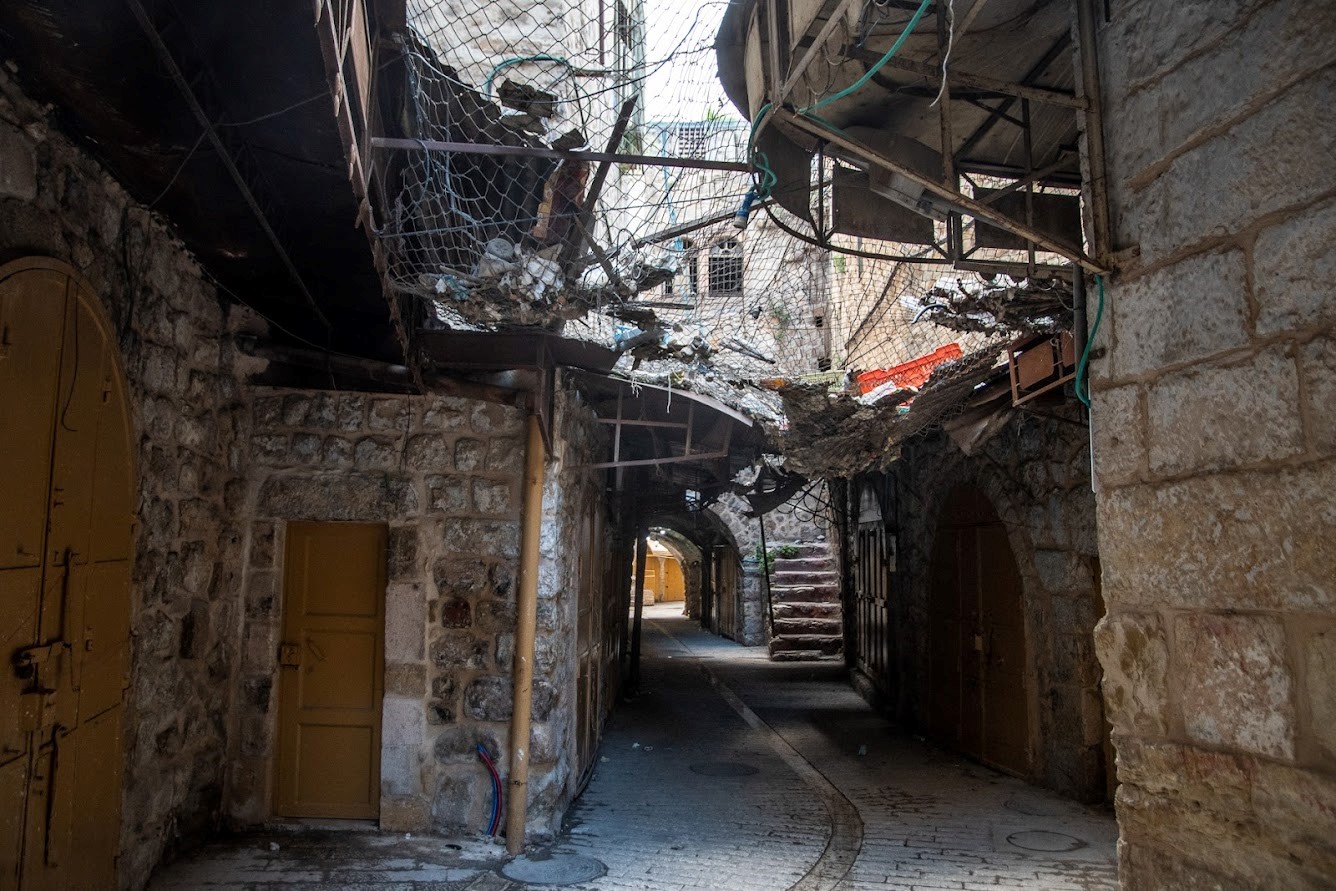
Hebron: deserted souk with collection nets
These new Israeli residents then throw their garbage and refuse on the Palestinians living among them, who have to put up special nets to protect themselves from this refuse – behavior that is truly deeply shameful, but unfortunately tolerated by the Israeli military. We then drove back to Beit Jala, a district of Bethlehem, where we first checked into the guest house of the Talitha Kumi School and then drove with Matthias Wolf, the director of this school, as well as the teacher Sanaa and the teachers Hanna and Jousef to the excellent, but unfortunately already quite expensive Al- Hakoura restaurant in Beit Sahour (“Shepherd’s Fields”), where our group will also have dinner again in October. There we met Matthias, with whom we have been working closely for a long time, as well as the other 3 teachers involved in the exchange and talked about the respective program of the bilateral meetings in June and October 22. Afterwards we were guests of Tony Nassar’s family before we spent the night in the guest house of the Talitha Kumi School.
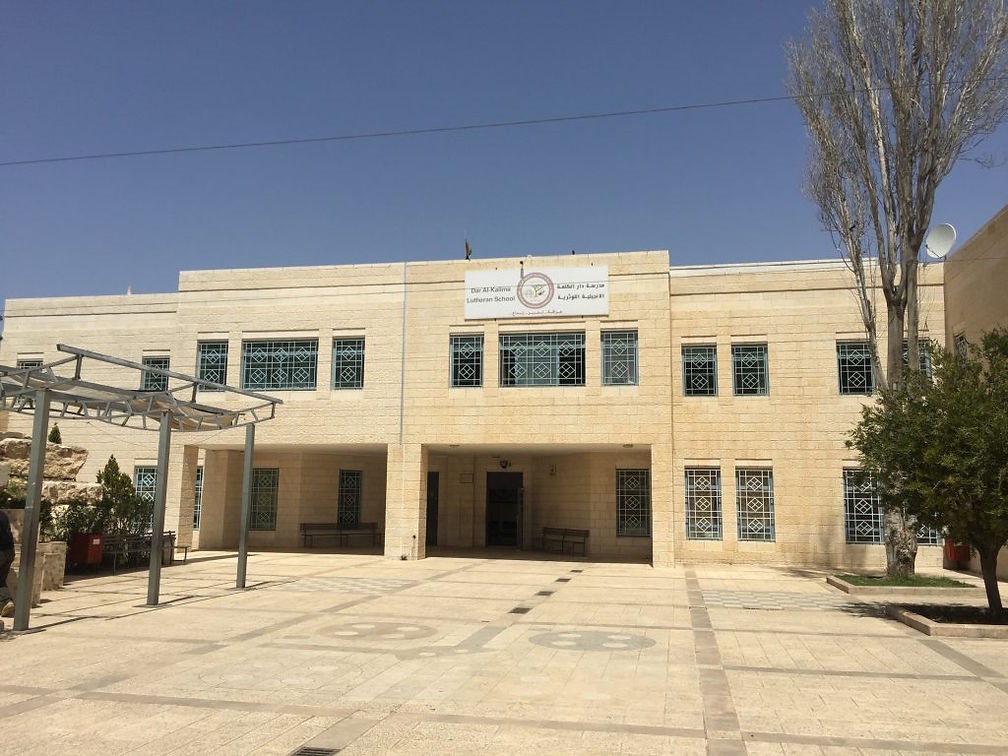
Talitha Kumi School in Beit Jala
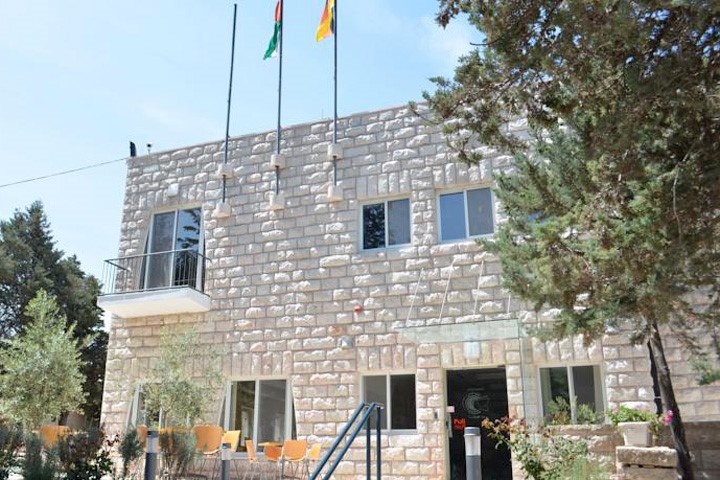
Talitha Kumi School Guest House
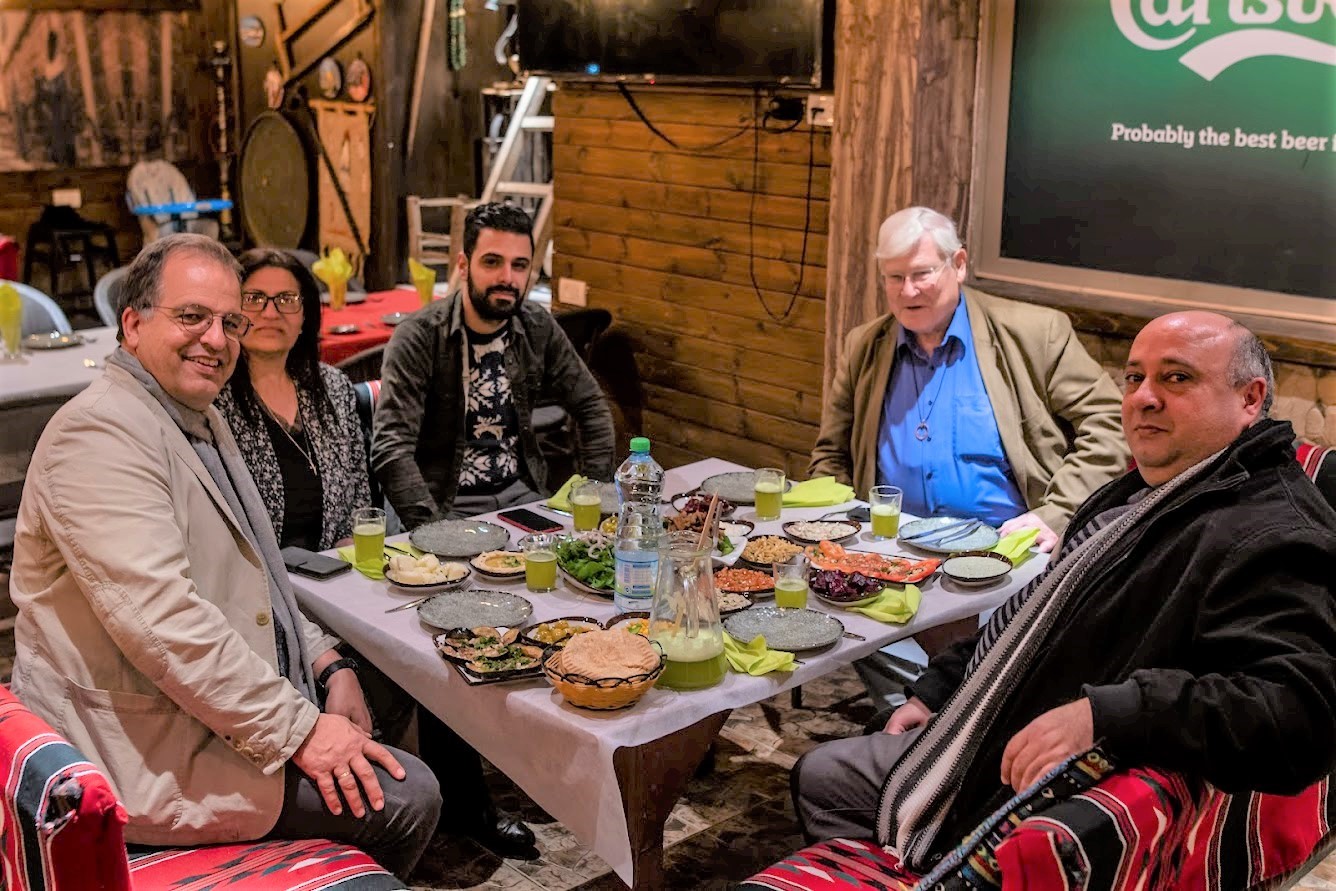
Mattias Wolf, Teacher Sanaa, Hanna and Jousef
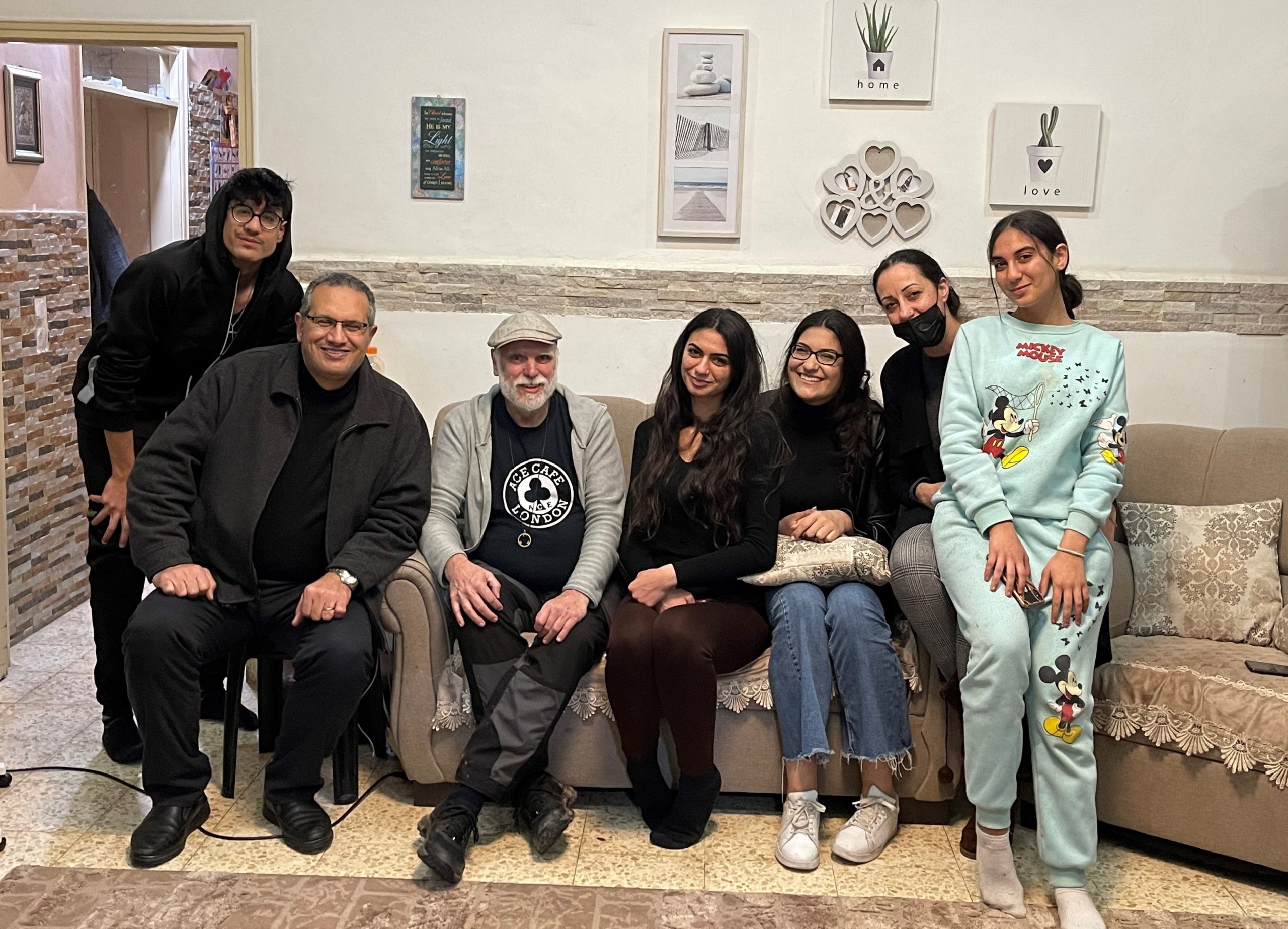
Family of Tony Nassar (without Basil, 2 y.) + Roland
At 8 a.m. we visited Talitha Kumi School and also talked to all 16 students involved in the return visit to us, who were very much looking forward to their visit to us, about their expectations from this exchange. We then met Tony, Daoud’s youngest brother, at Dar Al Kalima School in Bethlehem, with whom we ran the youth exchange from 2013-19. He showed us his school with integrated kindergarten and gave us the opportunity to participate briefly in some classes. We will definitely visit this school again in October 22 and hope that it can participate in the exchange again from 2023.
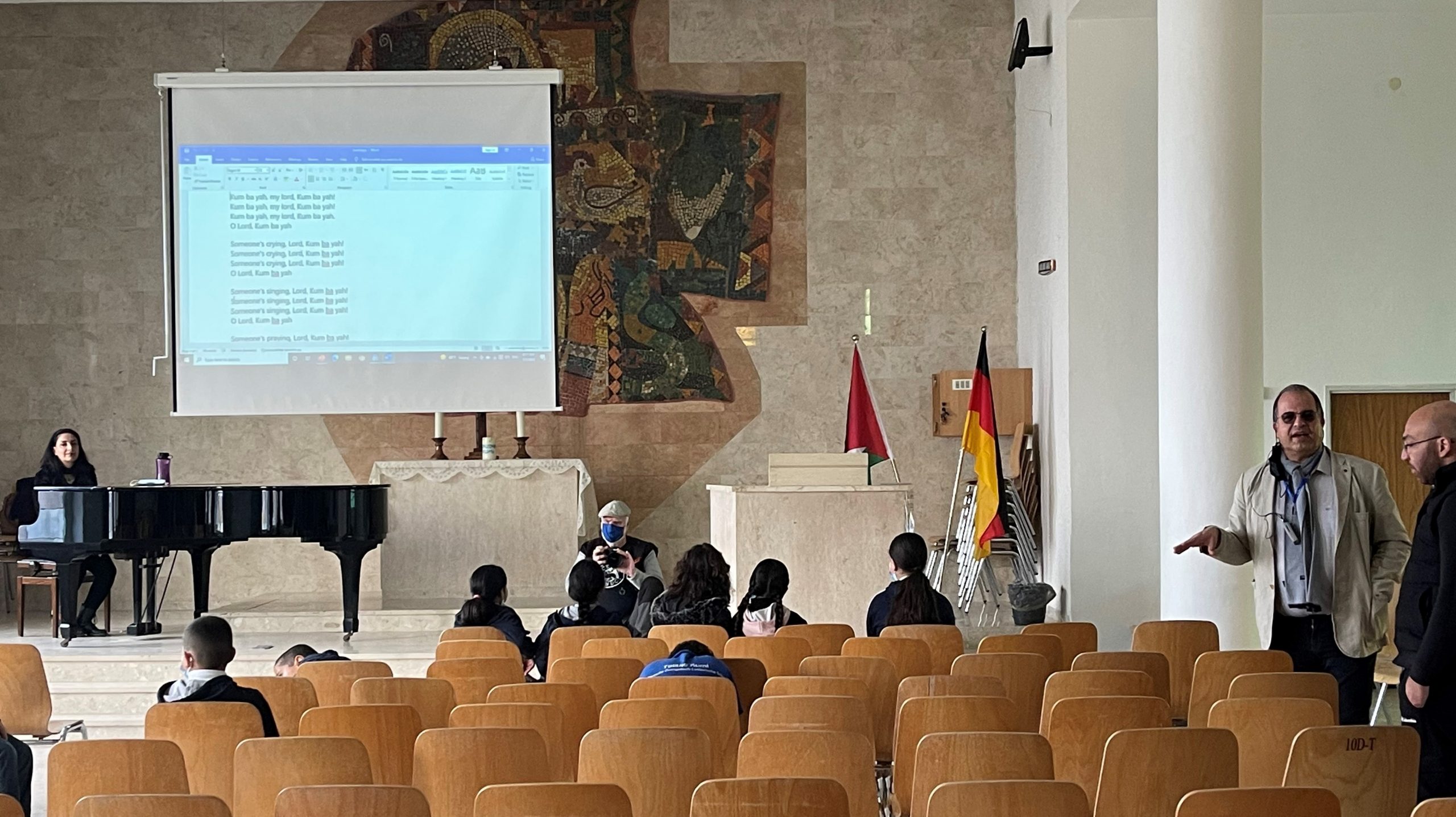
Music room of Talitha Kumi School
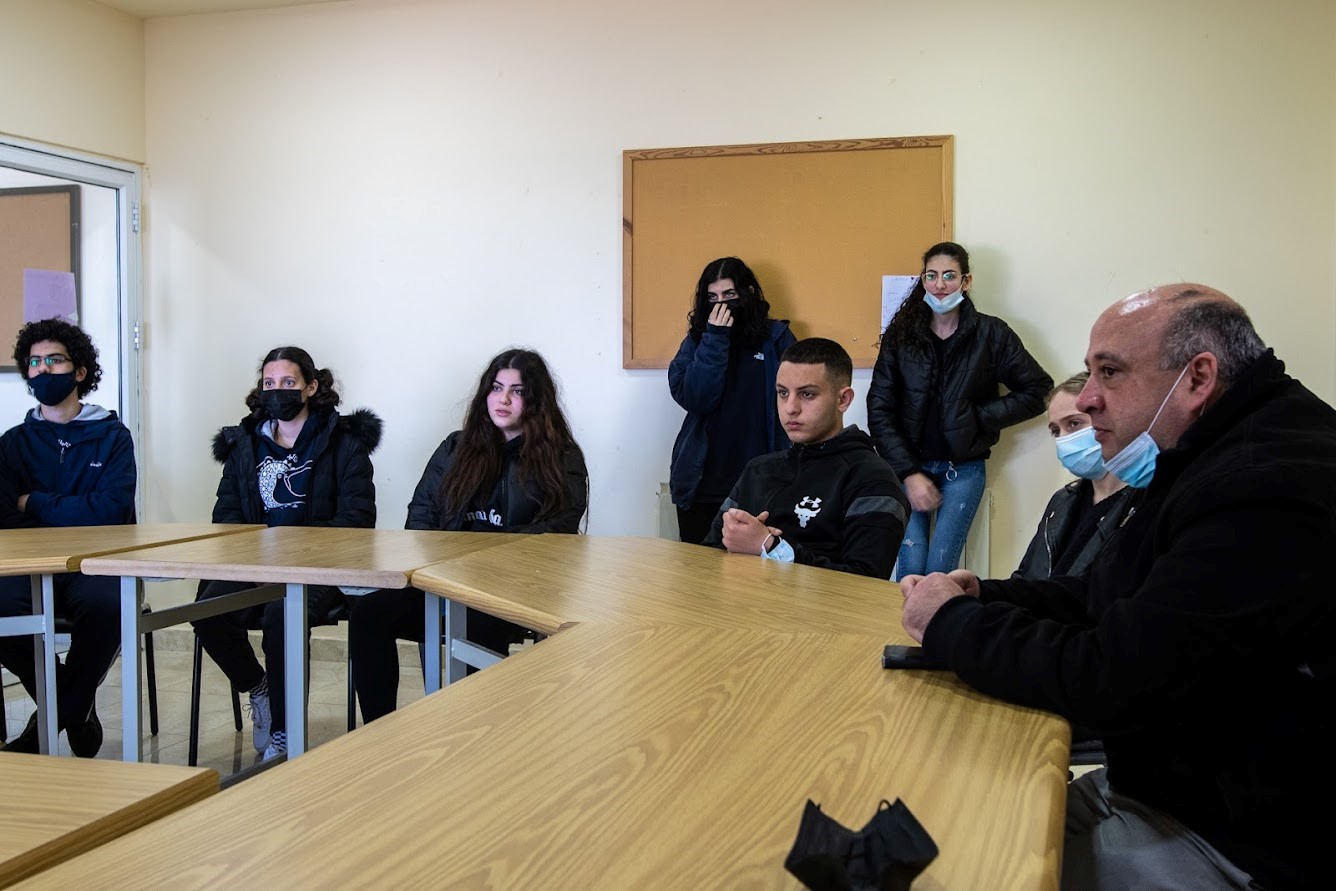
Jousef with students involved in the exchange
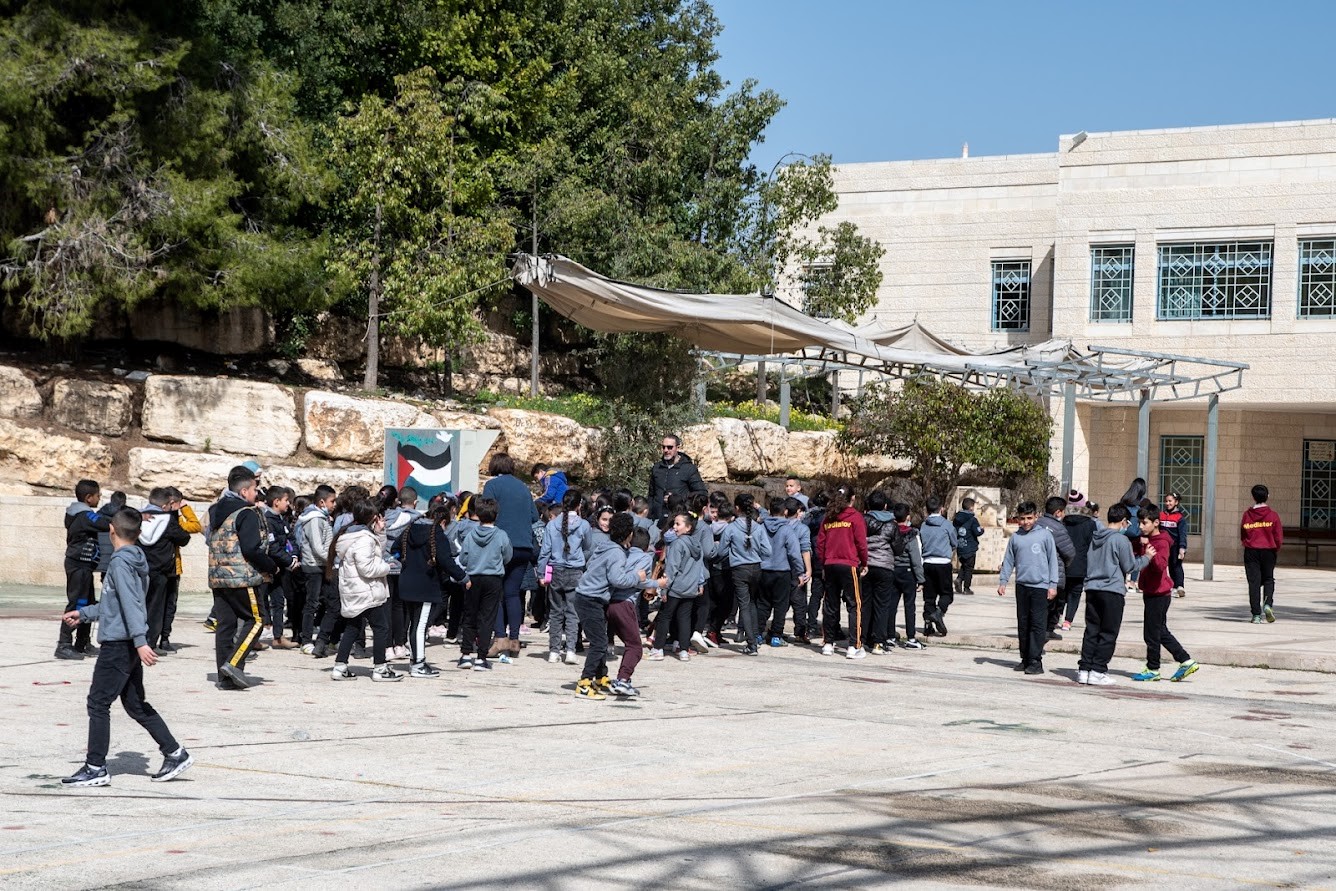
Schoolyard of Dar Al-Kalima School
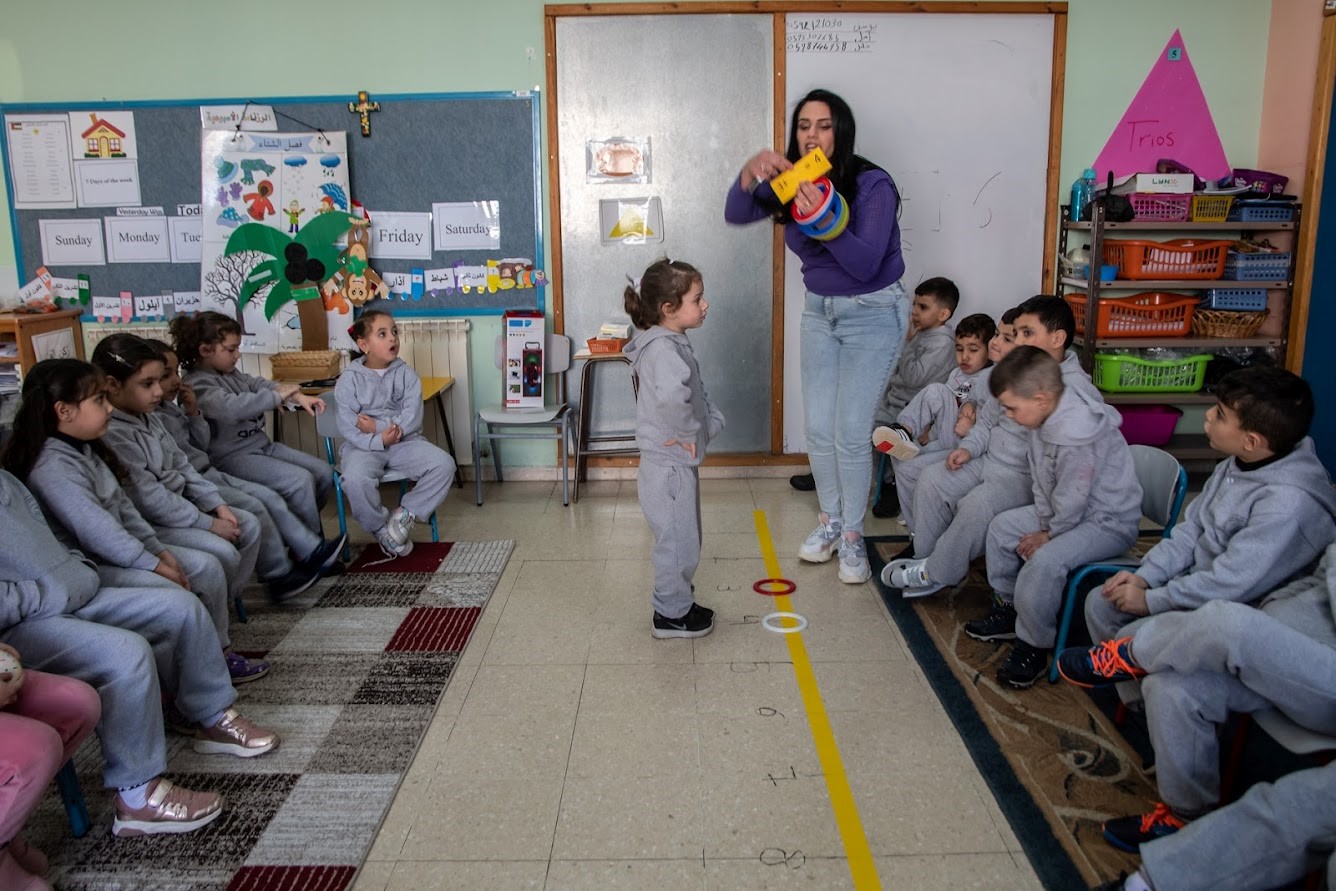
Dar Al-Kalima School Kindergarten
Incidentally, all Christian schools (most of which have about 75% Muslim students) are free of classes on Friday (a Muslim holiday) and Sunday (a Christian holiday). On Saturday (Shabbat and Jewish holiday), however, they have classes.
We then met George Bassous, a Syrian-Aramaic Palestinian Christian and general manager of the huge “City of Cultures and Civilizations” convention palace at Solomon’s Pools in south Bethlehem.
The Convention Palace, a joint investment of the Consolidated Contractors Company “CCC” and the Palestine Investment Fund “PIF”, was one of the projects that were part of Bethlehem’s preparations to welcome the new millennium. The architecture was synchronized with the nearby landmarks such as the “Murad Castle”, the museum and the historic “Solomon Pools”, preserving the historical and archaeological nature of the area. The premises, located on the southern outskirts of Bethlehem, include a huge auditorium, an exhibition gallery, a theater with more than 2,200 seats and state-of-the-art technology, meeting rooms and a cafeteria. The Palace hosts several important local and international events throughout the year and has managed to maintain international standards of hospitality. The area in and around the Palace of Congress welcomed thousands of visitors every year (until 2019) to explore the history and heritage of the place and enjoy the interesting mix of events and activities, especially the programs held in the summer. The Castle Museum houses one of the largest ethnographic collections of Palestinian history and culture.
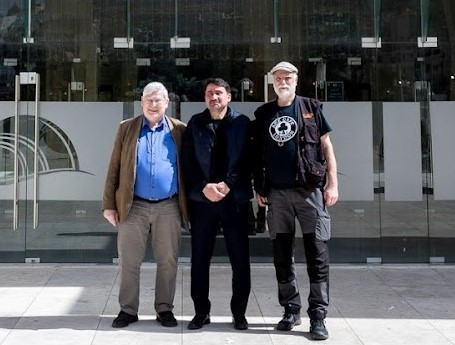
With George Bassous in front of the Palace of Congress
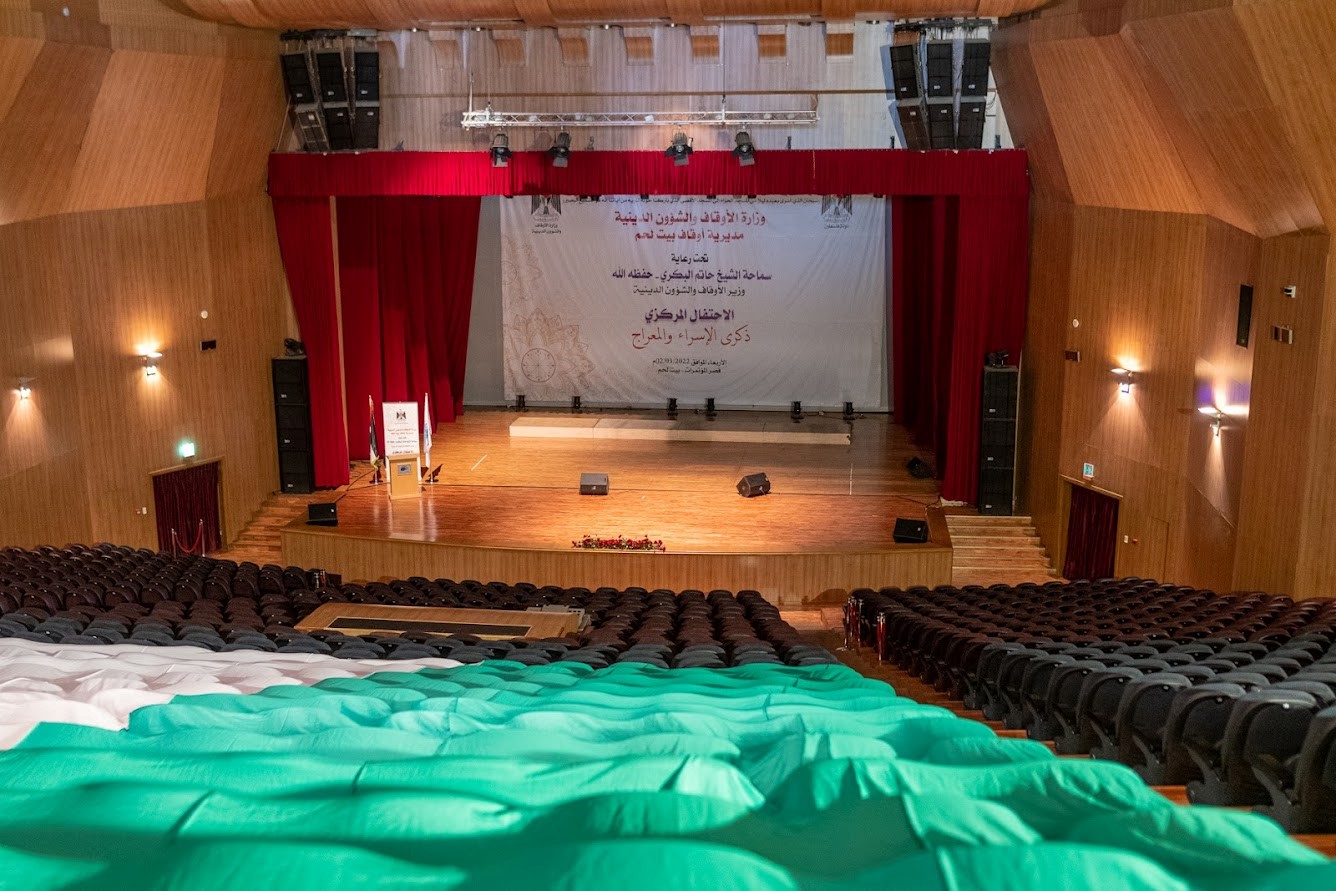
Congress Palace Theater
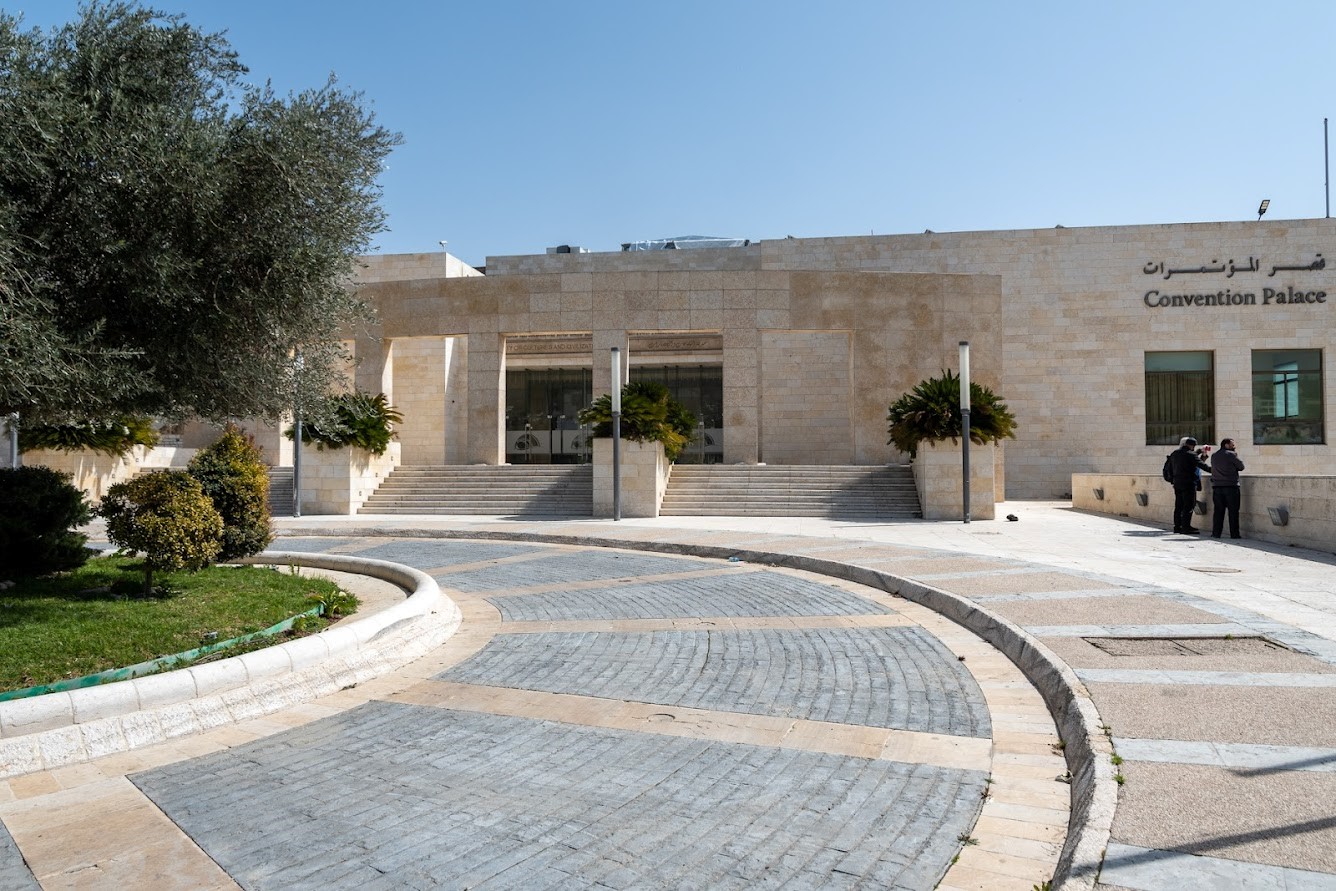
Entrance area of the Congress Palace
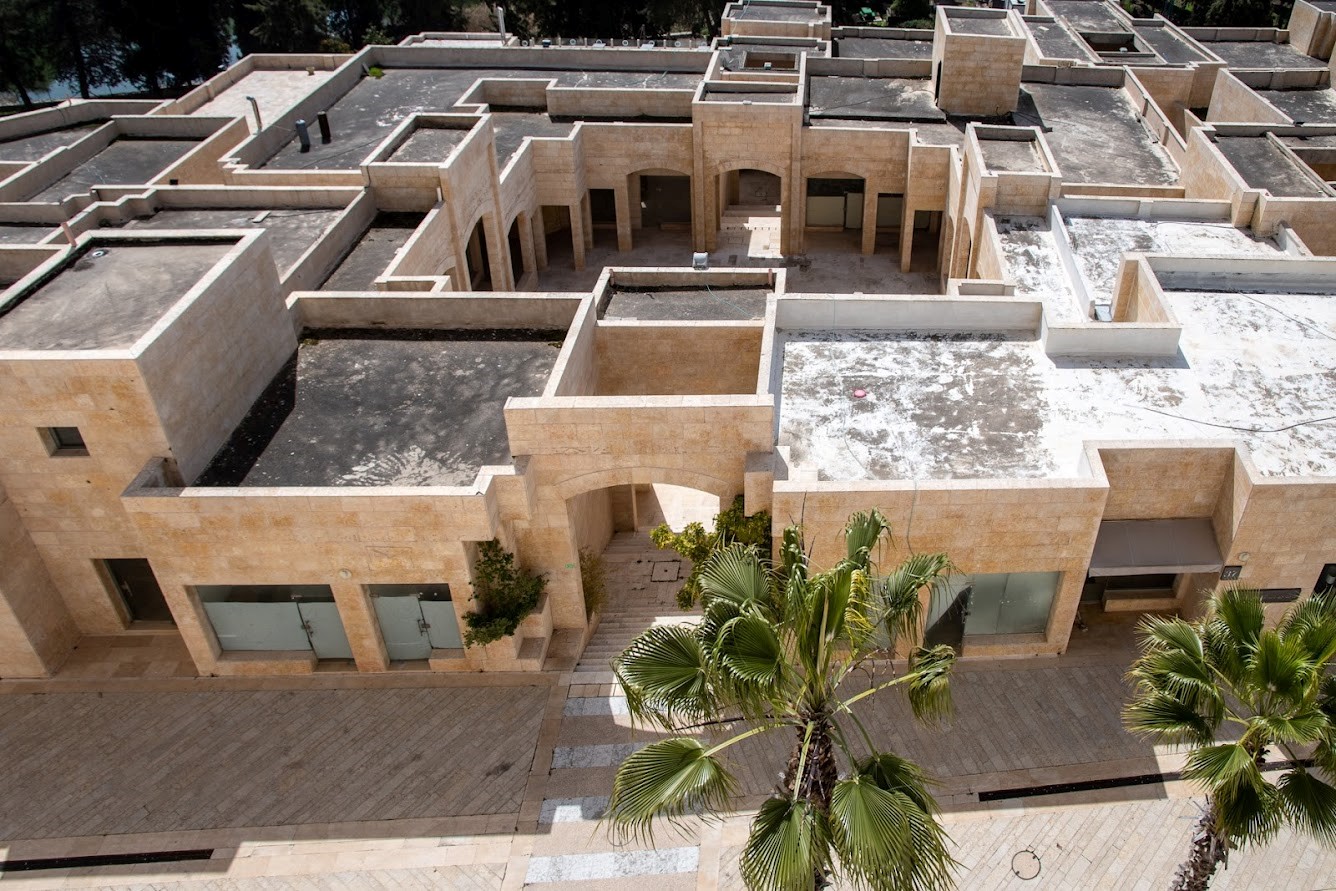
Outdoor area
After a short visit to the Church of the Nativity (This time, for the 1st time, there was no queue in front of the Grotto of the Nativity!), we drove to the Bethlehem Wall, which encloses the city like a prison. The many formerly very worth seeing and partly also touching graffiti, among others by the famous artist Banksy, are now unfortunately mostly very unprofessionally sprayed over with new graffiti, not to say disfigured, so that photographing is hardly worthwhile.
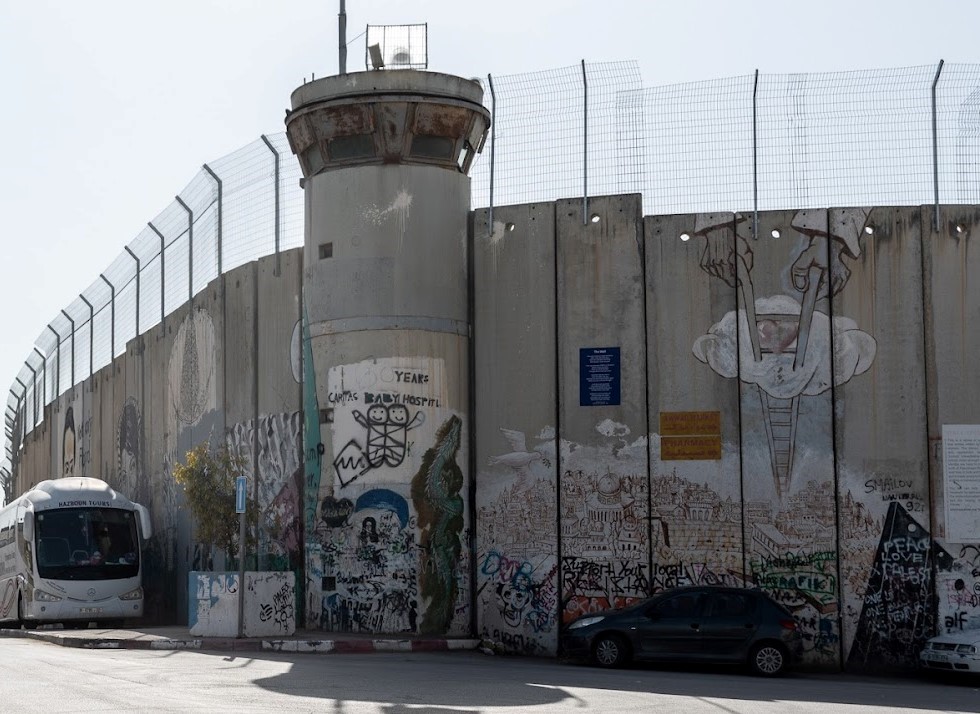
Bethlehem Wall
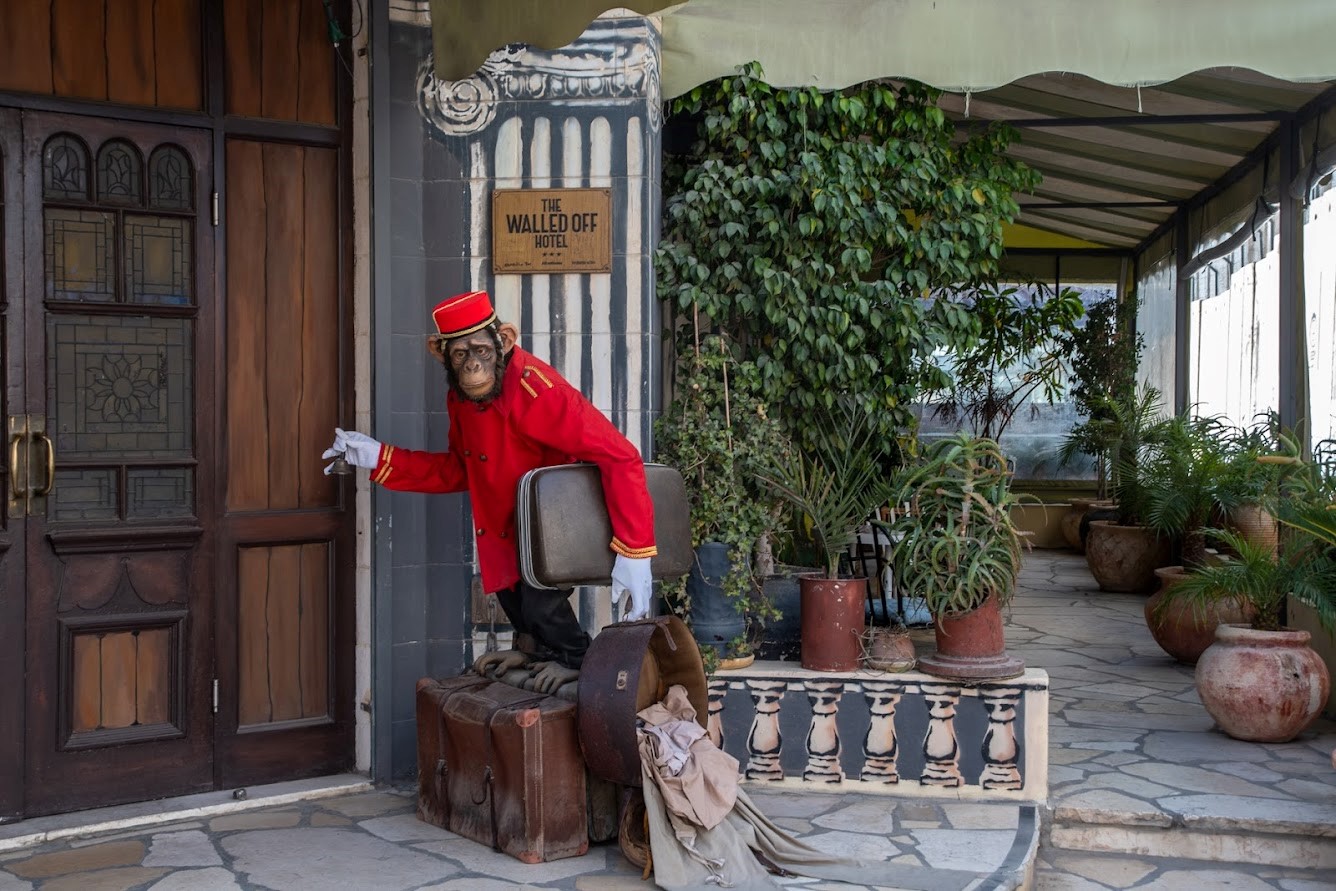
Wallet hotel directly on the wall
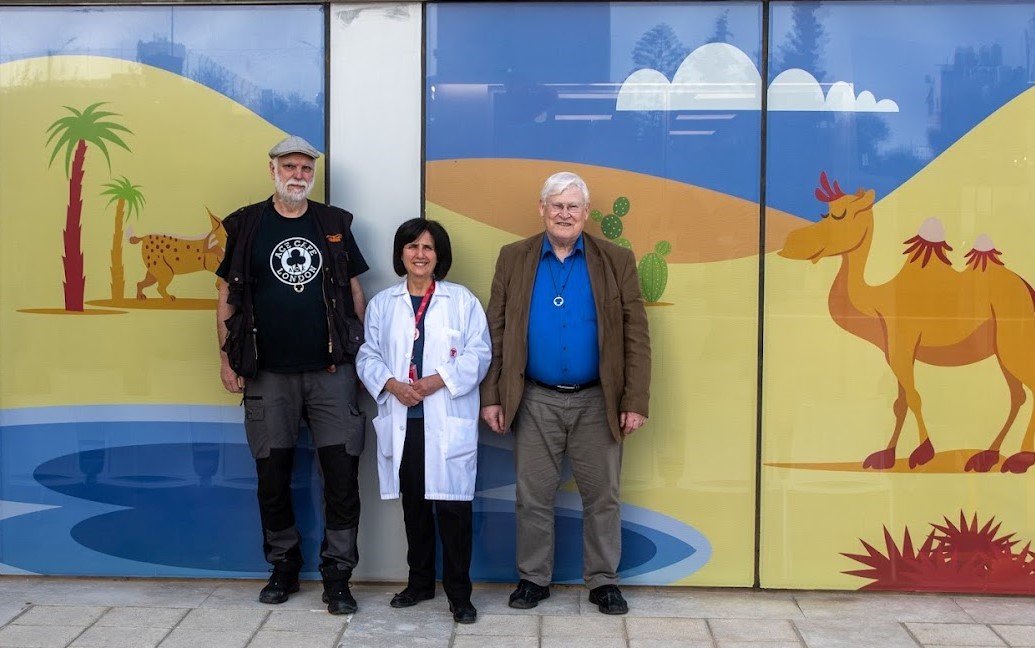
With Dr. Hiyam Marzouqa in front of the Caritas Baby Hospital
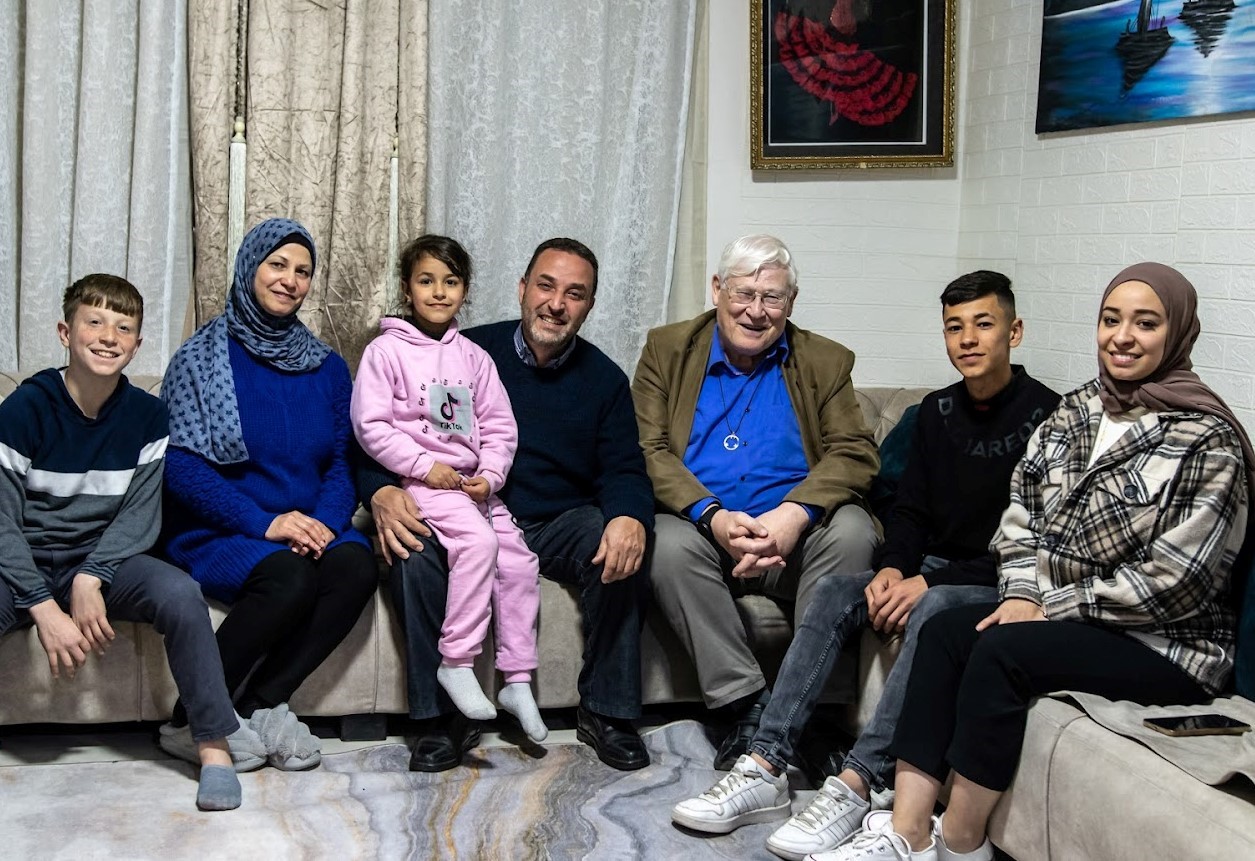
in the circle of the family of our driver Husam Moner
Early in the morning we drove to Ramallah, the unofficial capital of Palestine, where the palace of the current President Abbas is also located. Directly in front of it is the tomb of Yasser Arafat, which we visited briefly. Afterwards, a short visit to the Al Jalazoon Secondary Girl’s School (built with KFW funds) in the refugee camp of Ramallah was on our agenda, which only came about after several interventions with the Palestinian Authority, which had actually prohibited all visits to the school and also to us because of the Corona pandemic. With this school the idea for youth encounters with Israel-Palestine started first on a school level for me as a former teacher of the Berufskolleg Opladen (from 2008) and then later with JIK (since the foundation of the association in 2011). Although Husam is actually the best driver in the world and has been there several times, he got lost several times in this completely opaque maze of alleys until we finally reached the school (built on a former garbage dump). Since this school – like the Israeli schools – has Fridays and Saturdays off, we were able to visit them on Sunday during school hours.
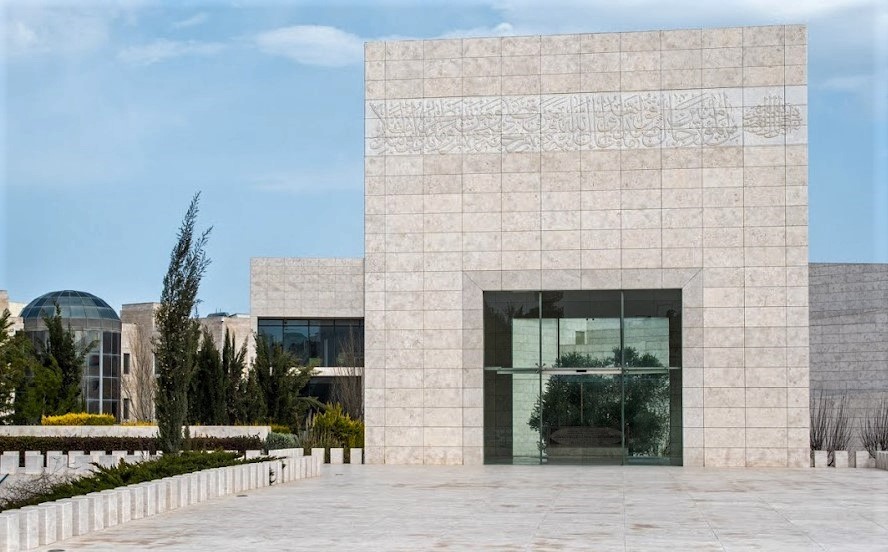
Ramallah: Arafat’s tomb; left: Presidential Palace
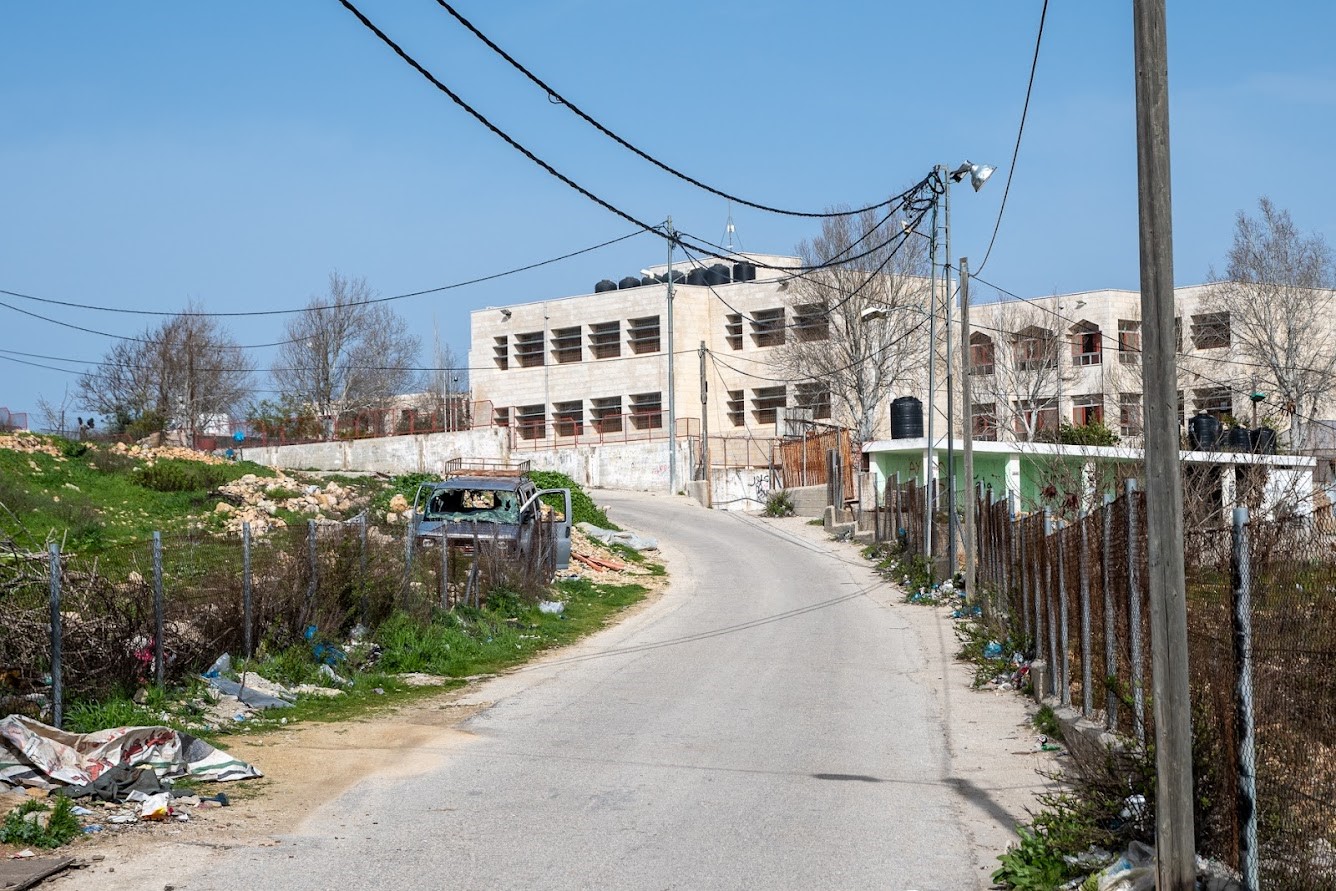
Refugee Camp: Al Jalazoon Secondary Girl’s School
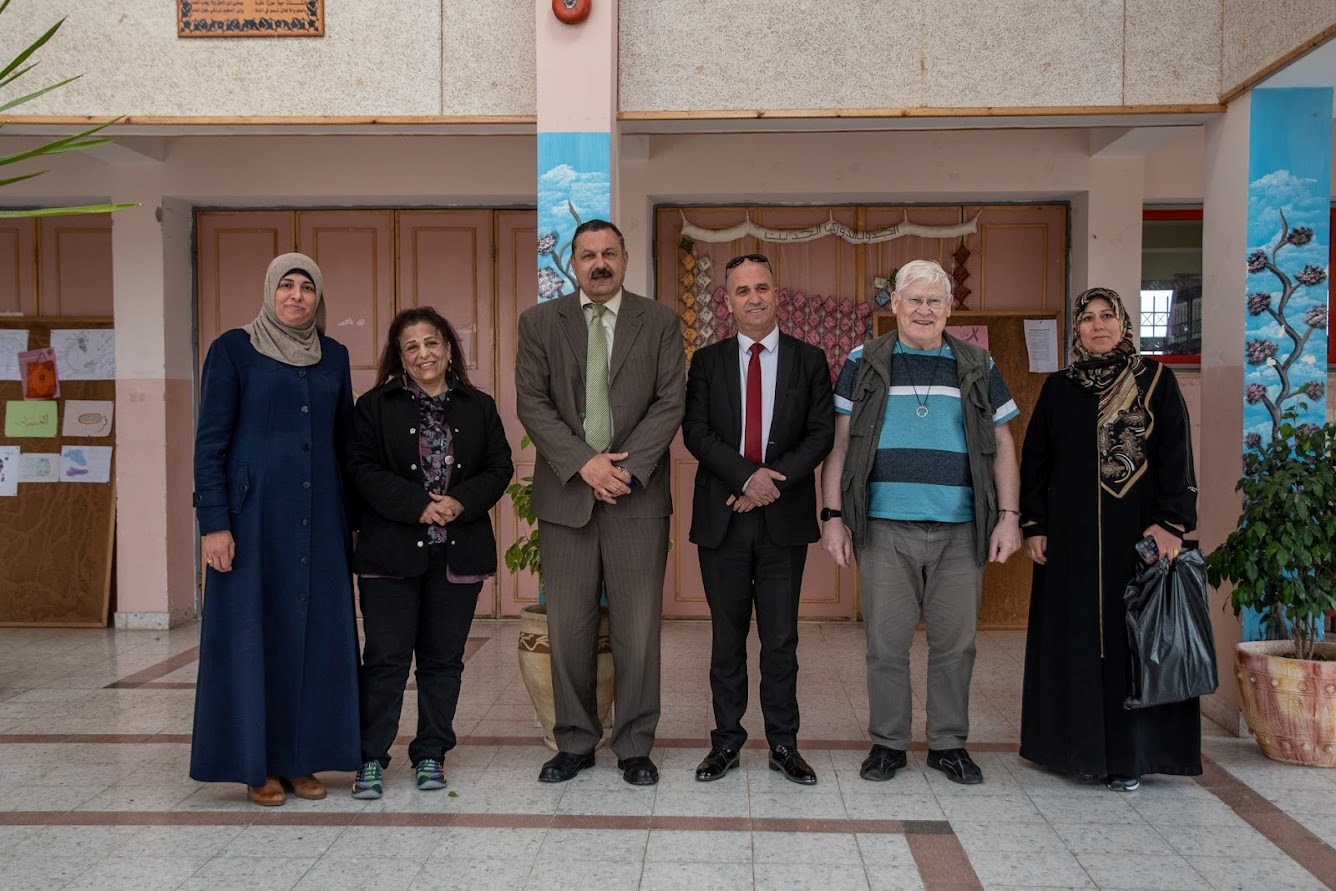
Principal, General Manager (3rd from left), Rabeeha (right).
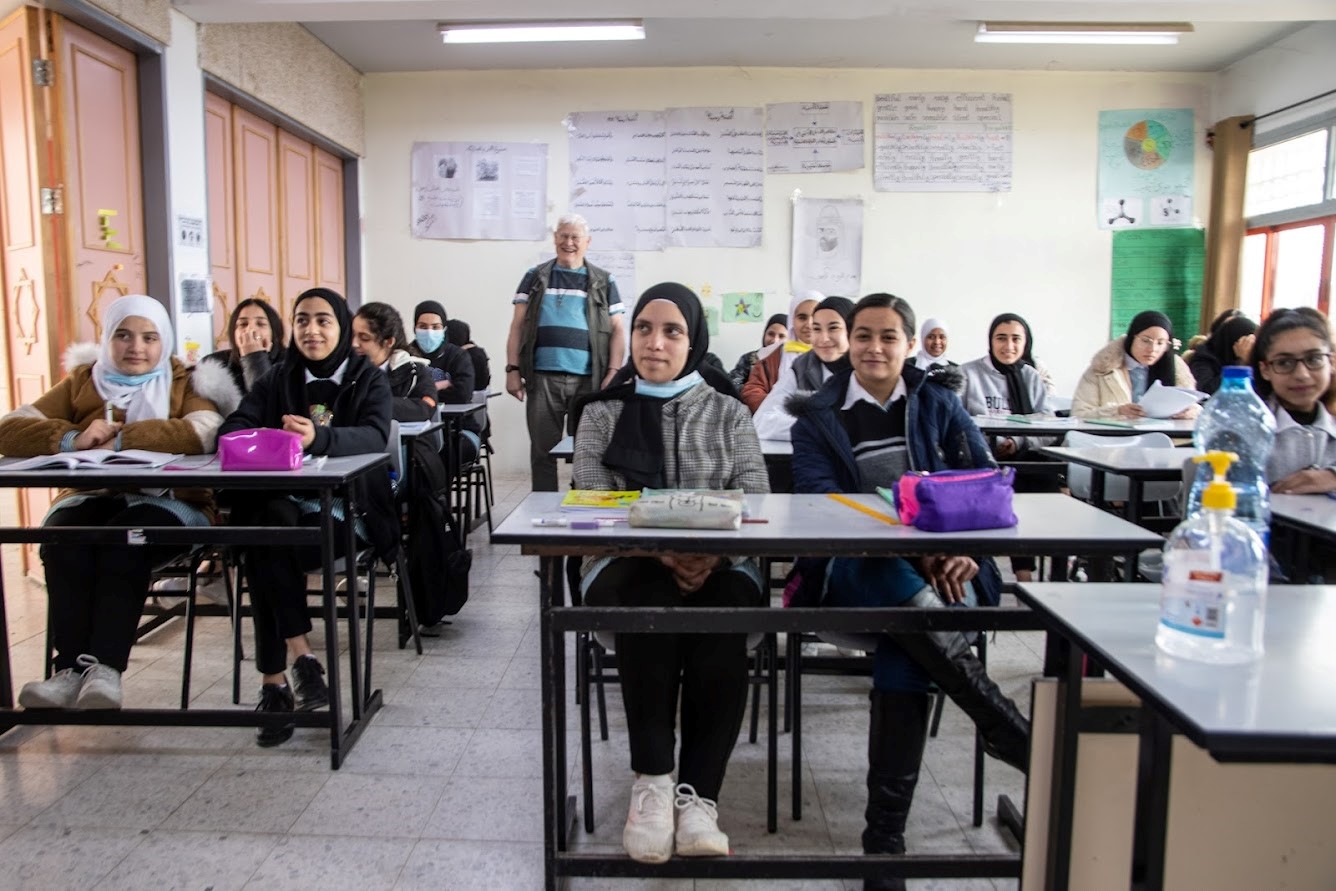
Mathematics lessons in the 6th grade
From the Damascus Gate, Husam then drove us to the Kol Haneshhama Reform Synagogue, which we have also been visiting since the beginning of our youth exchange. Here we were warmly welcomed by the new Rabbi Oded and his assistant Anna.
Since this Reform synagogue is very open and liberal, we could easily talk about having been in Ramallah before and supporting the ToN. Unfortunately, for many Israelis, the mere mention of contacts with Palestine causes the conversation or contact to break off. We had to experience this a few years ago at the famous, intercultural and actually liberal Leo Baeck Education Center in Haifa, where we were therefore accused of anti-Semitism and advocacy of the extermination of Israel, just because we support the ToN of the Christian Palestinian Daoud Nassar!
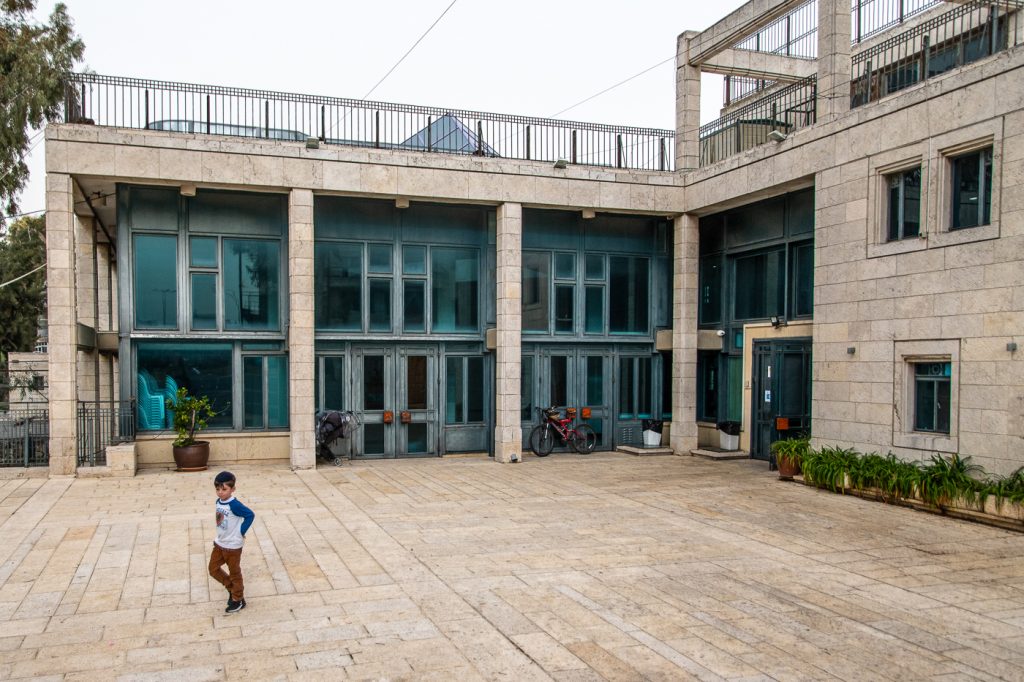
Reform Synagogue Kol HaNeshama
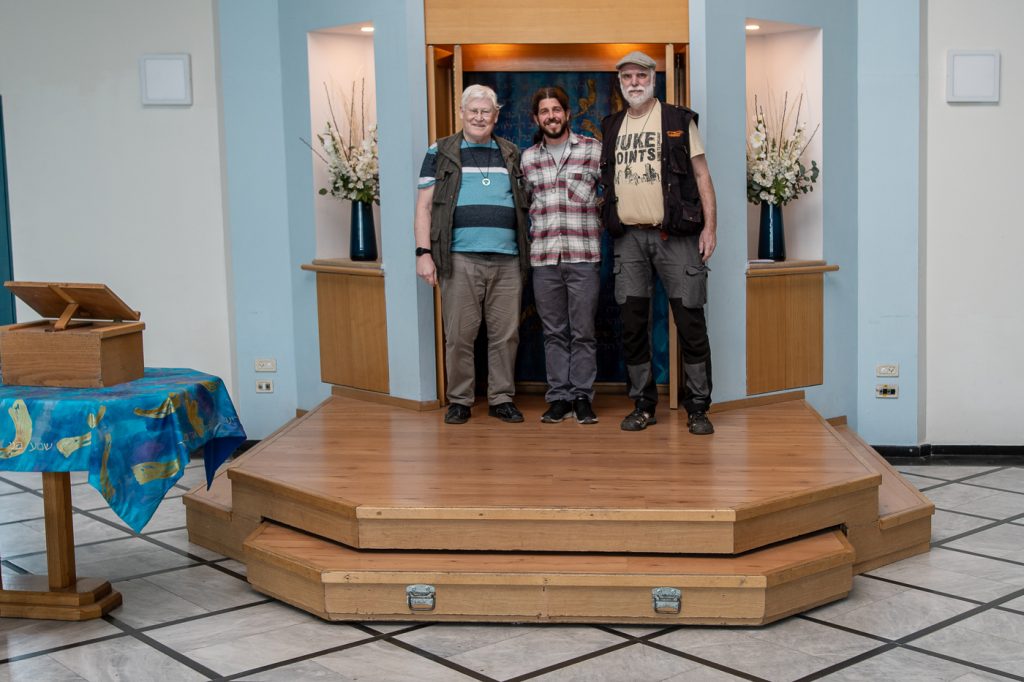
with Rabbi Oded in the synagogue
Because of Sukkot (incl. preparations) and Yom Kippur in October, according to Rabbi Oded, a meeting with other young people from the Reform synagogue is uncertain, but maybe it will work out. After visiting the Reform synagogue, Husam took us to the upper viewing platform of the Mount of Olives, from where we descended to the city wall with a magnificent view of the Old City and the Dome of the Rock and visited, among other things, the tomb of Mary, the Garden of Gethsemane, the Church of the Nations and “Absalom’s Tomb” (in reality the tomb of an aristocratic Jewish family from the 1st century AD) in the Kidron Valley. We visited the Kidron Valley, from where we can see the settlement of Silvan (about 35,000 Palestinians), whose houses are also threatened with demolition for lack of permits from Israel, before returning to the Birgittines for dinner and spending the night there.
In the morning we visited St. Paul’s House and the Schmidt School (also sponsored by JIK) in East Jerusalem, where we were warmly welcomed by the principal Dr. Eva Schönemann. By the way, she was previously head of the comprehensive school in Troisdorf and therefore knows Bonn and the RSK very well. She showed us some rooms of the school, explained the school system and reported about the currently still very difficult financial situation of the school, but especially of the still often unemployed Muslim parents (about 75%), who often cannot pay the school fees. We would also like to hold a workshop with our group in this school in October.
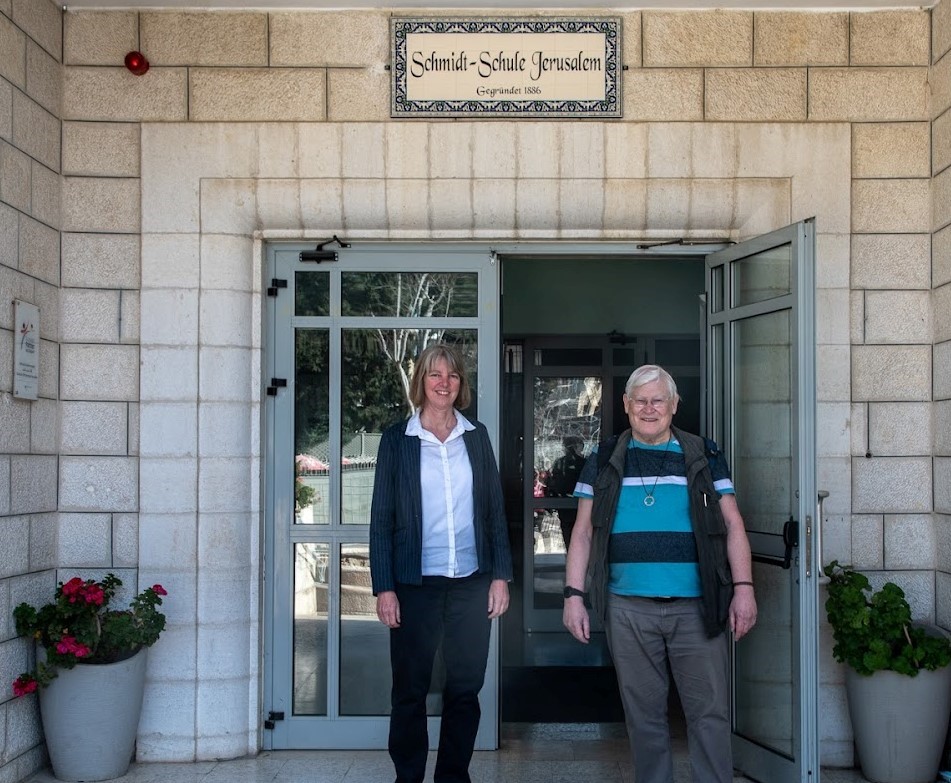
With Dr. Schönemann in front of the Schmidt School
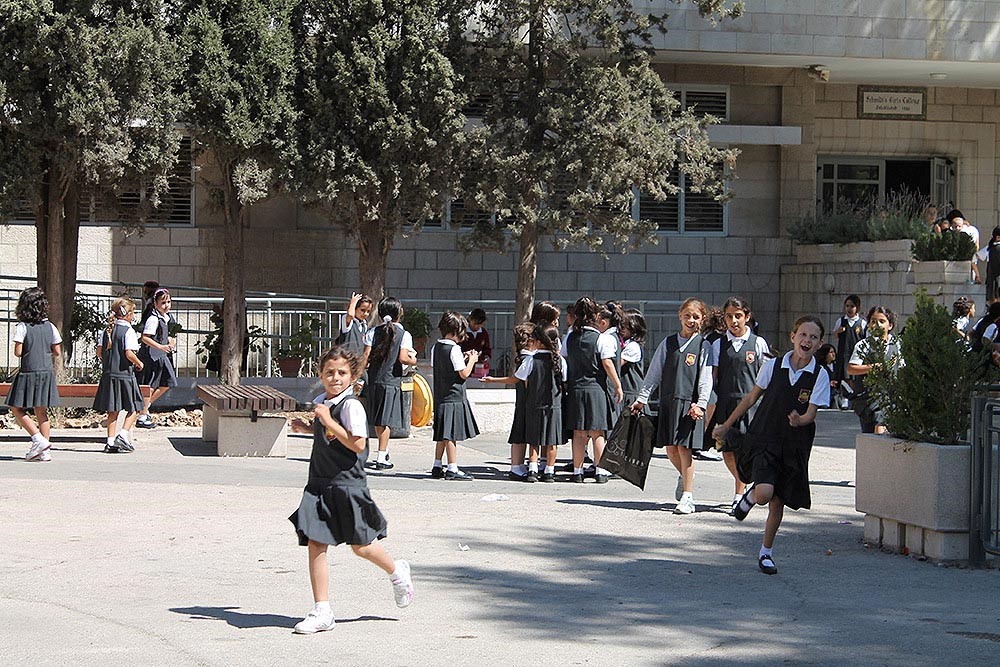
Schoolyard of the Schmidt School
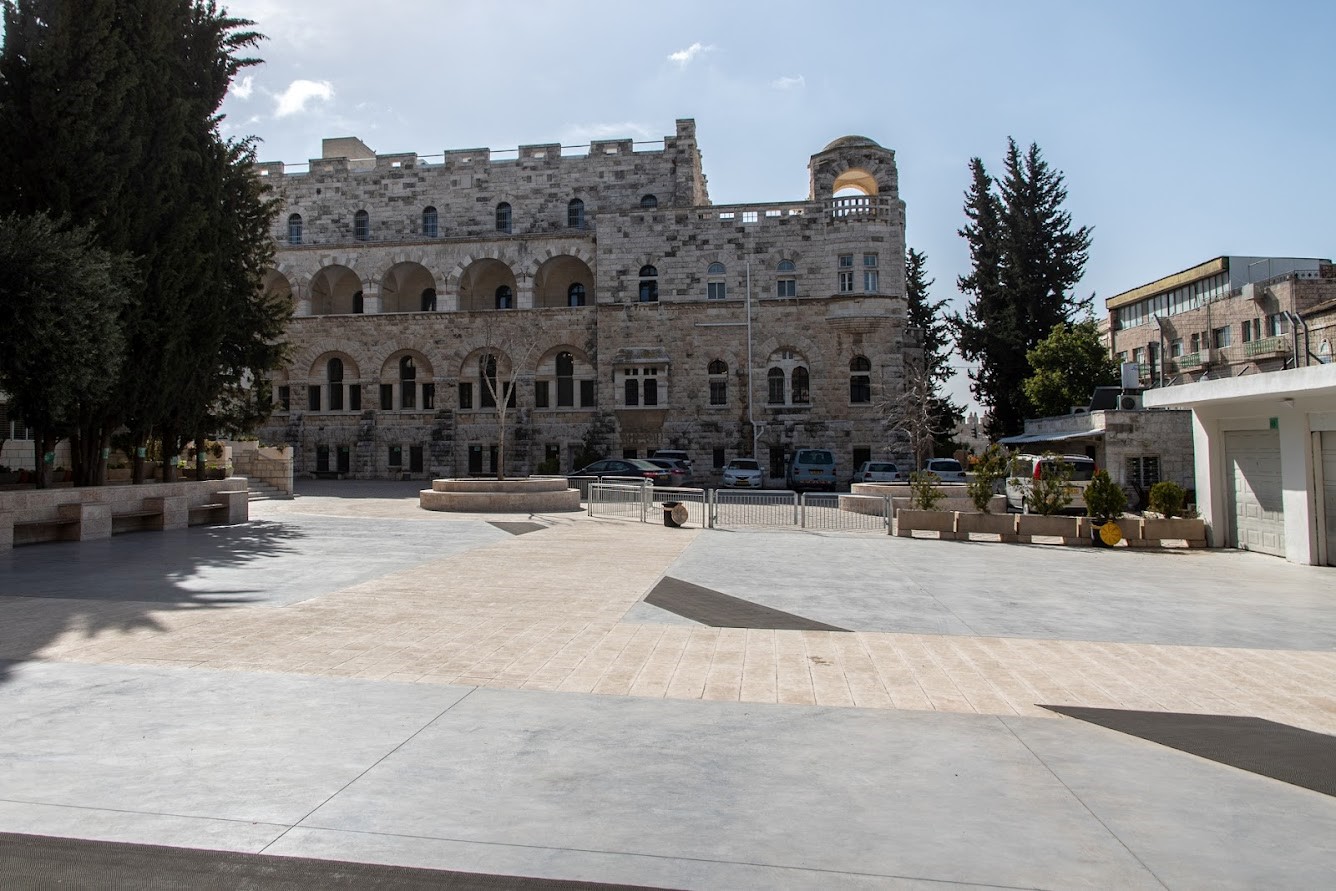
View from the schoolyard to the Paulushaus
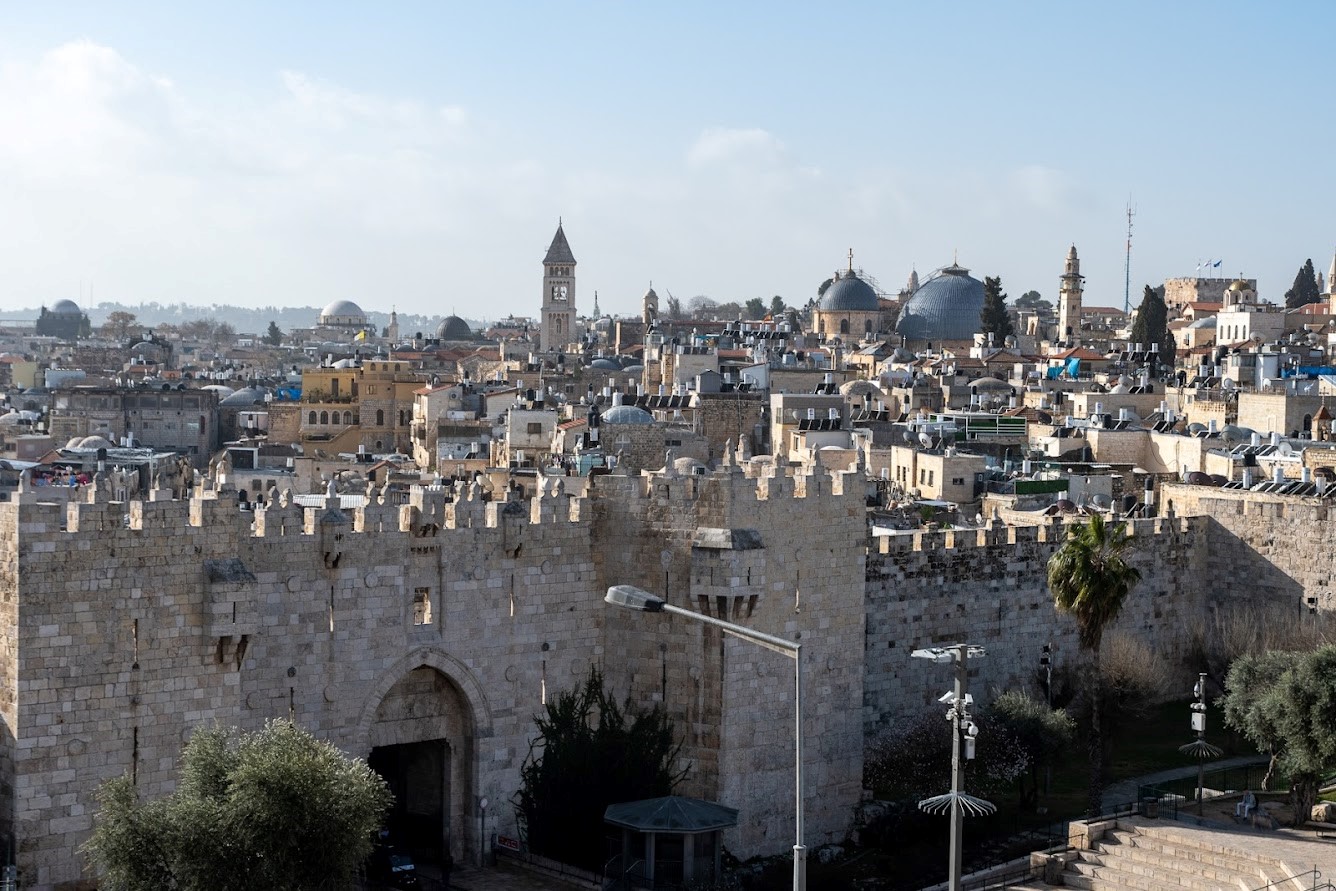
View from St. Paul’s House to Damascus Gate and Old Town
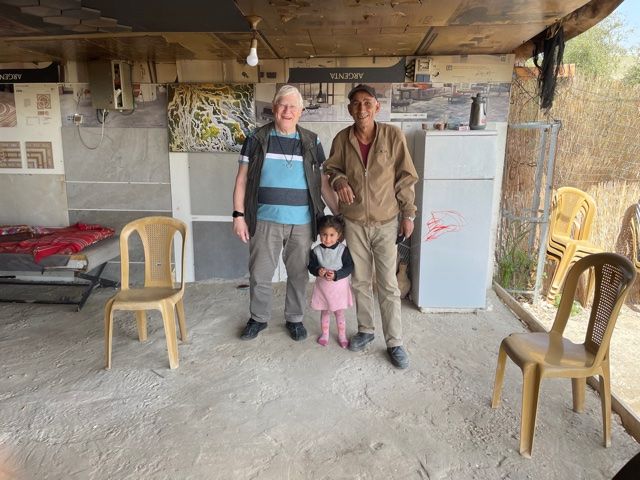
With Aid Jahalin and daughter
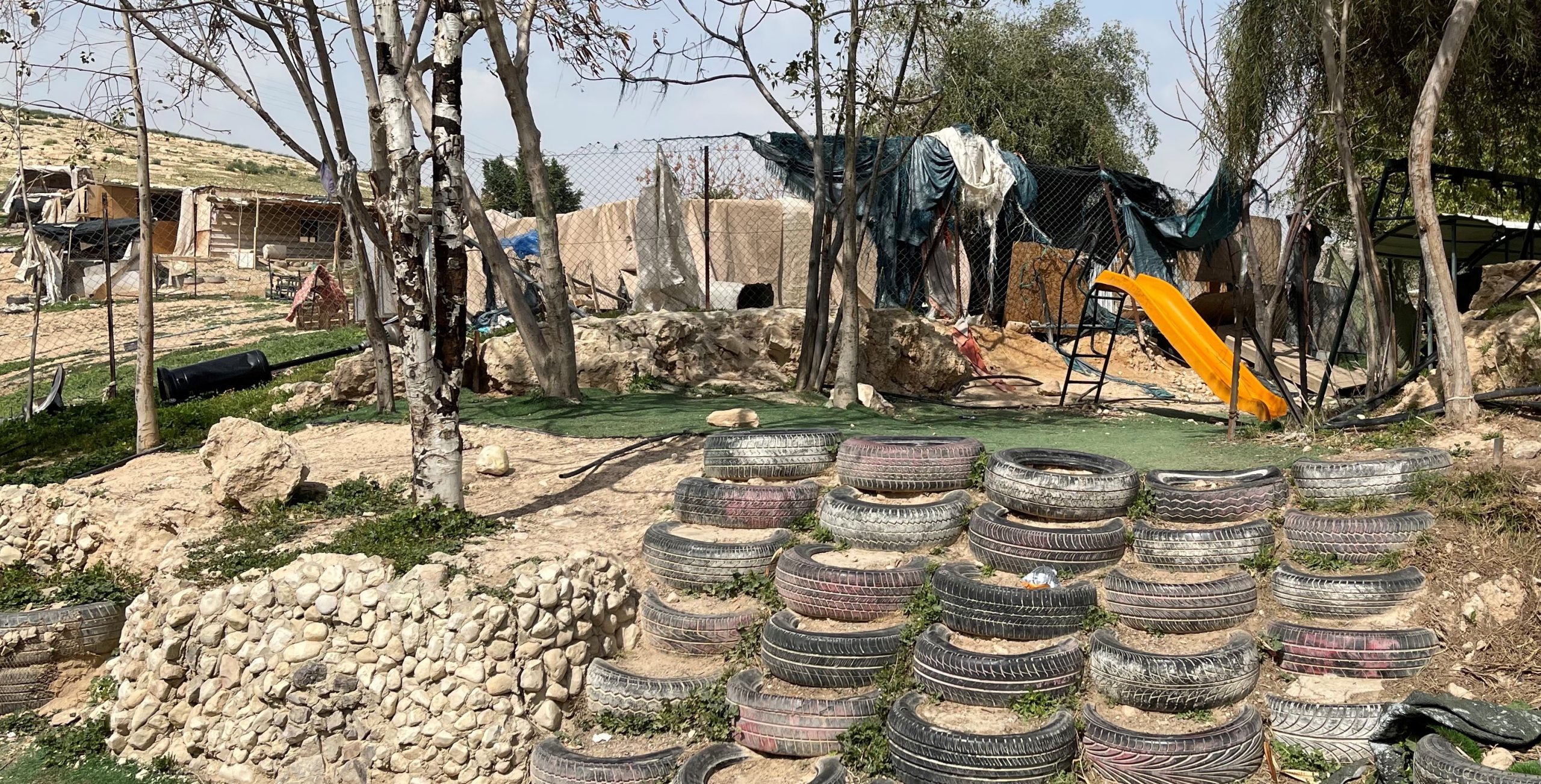
old car tires as building material
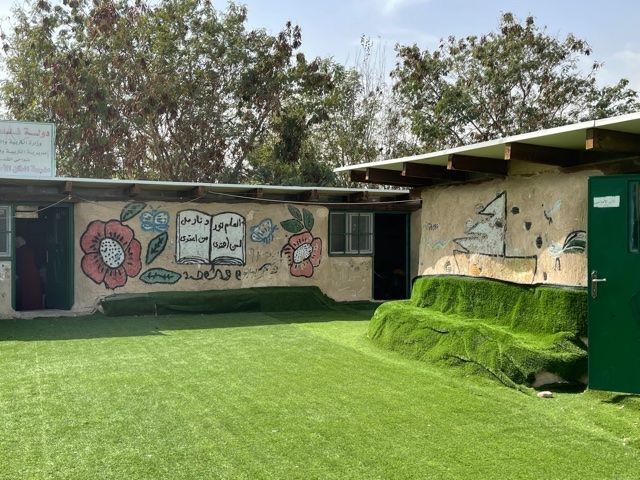
Car tire school of the Jahalin Bedouins
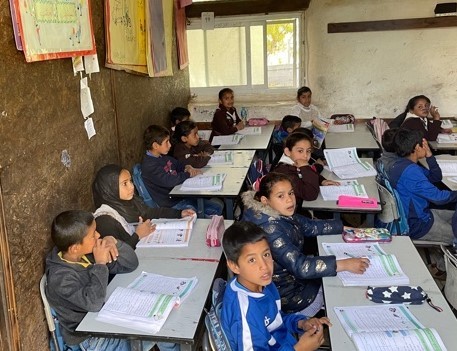
View into a classroom
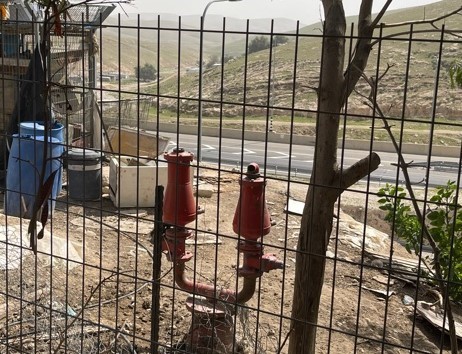
Water connection only for Israelis at the school fence
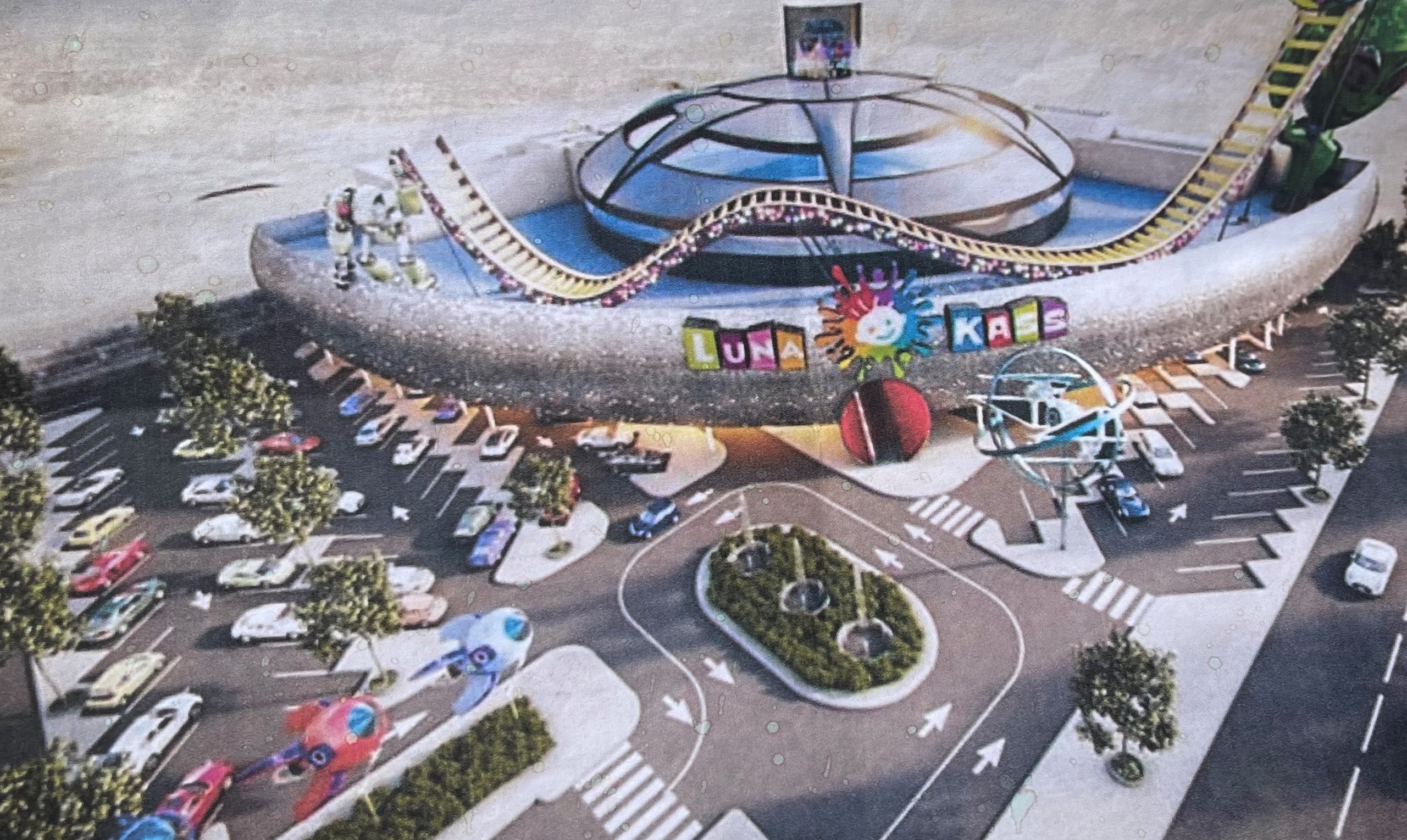
planned fun park after forced relocation of the Bedouins
In Jericho, we then first visited the huge Hisham Palace, which was destroyed by an earthquake in 749 AD shortly after its completion. Thanks to a roofing of the entire palace, the huge, wonderful mosaics can be visited for the 1st time since the end of 2021.
After visiting the Mount of Temptation and the Greek Orthodox rock monastery with the help of the cable car, as well as the One Sultan Spring, where Jesus is also said to have stayed, we visited the Romanian Orthodox Church, built in 2011 and magnificently painted.
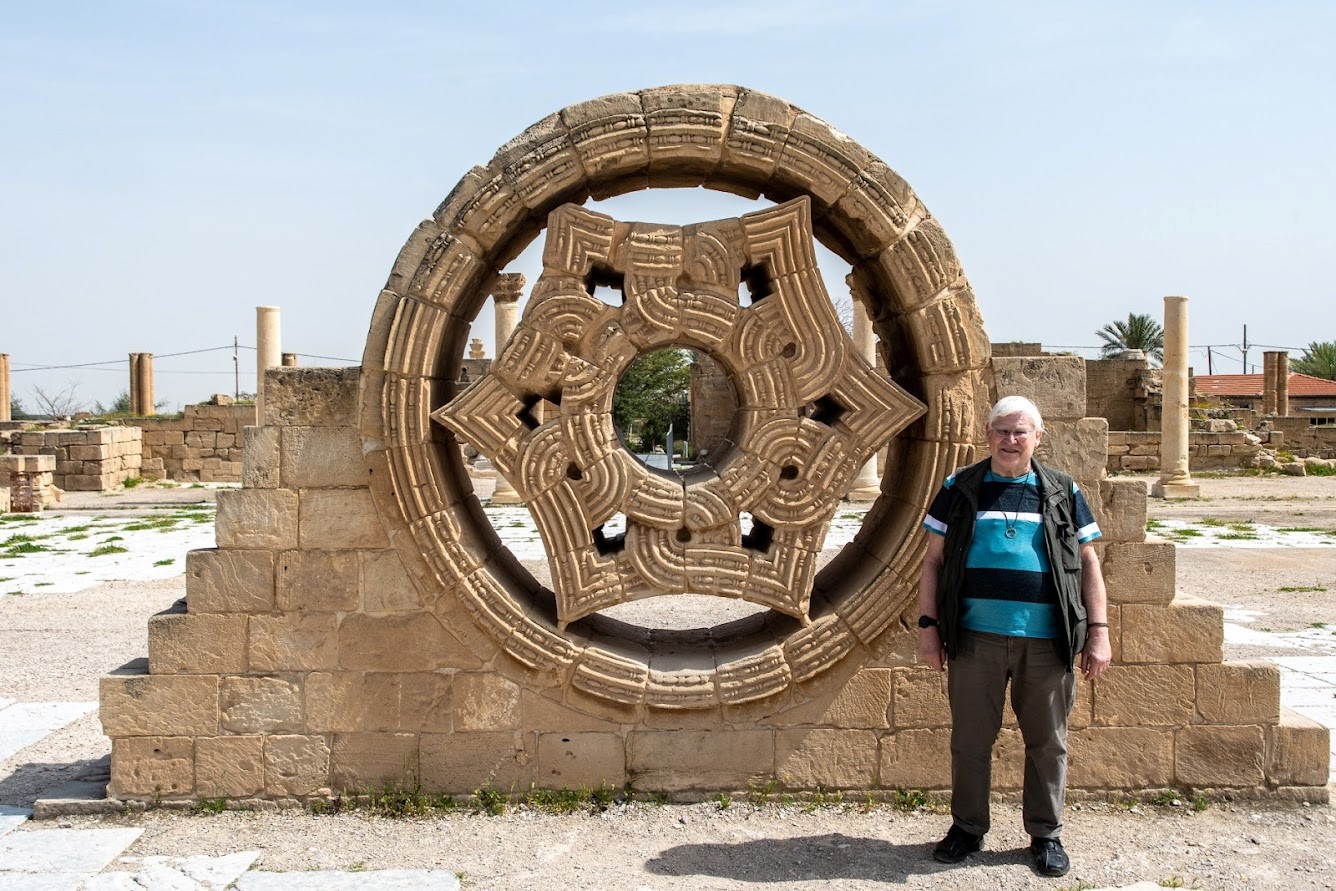
Jericho: Hisham Palace
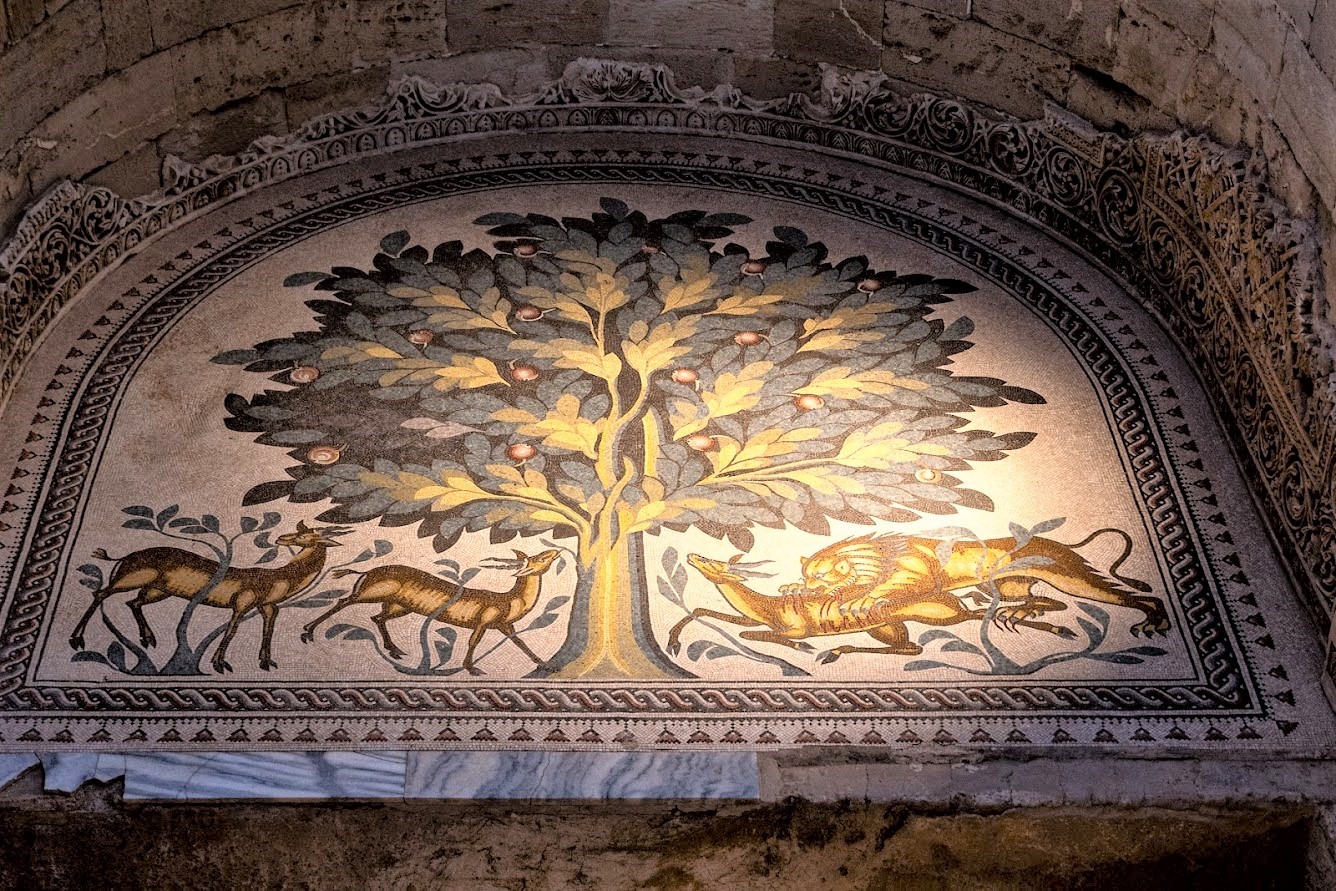
Hisham Palace: Mosaic of the Paradise Tree of Life
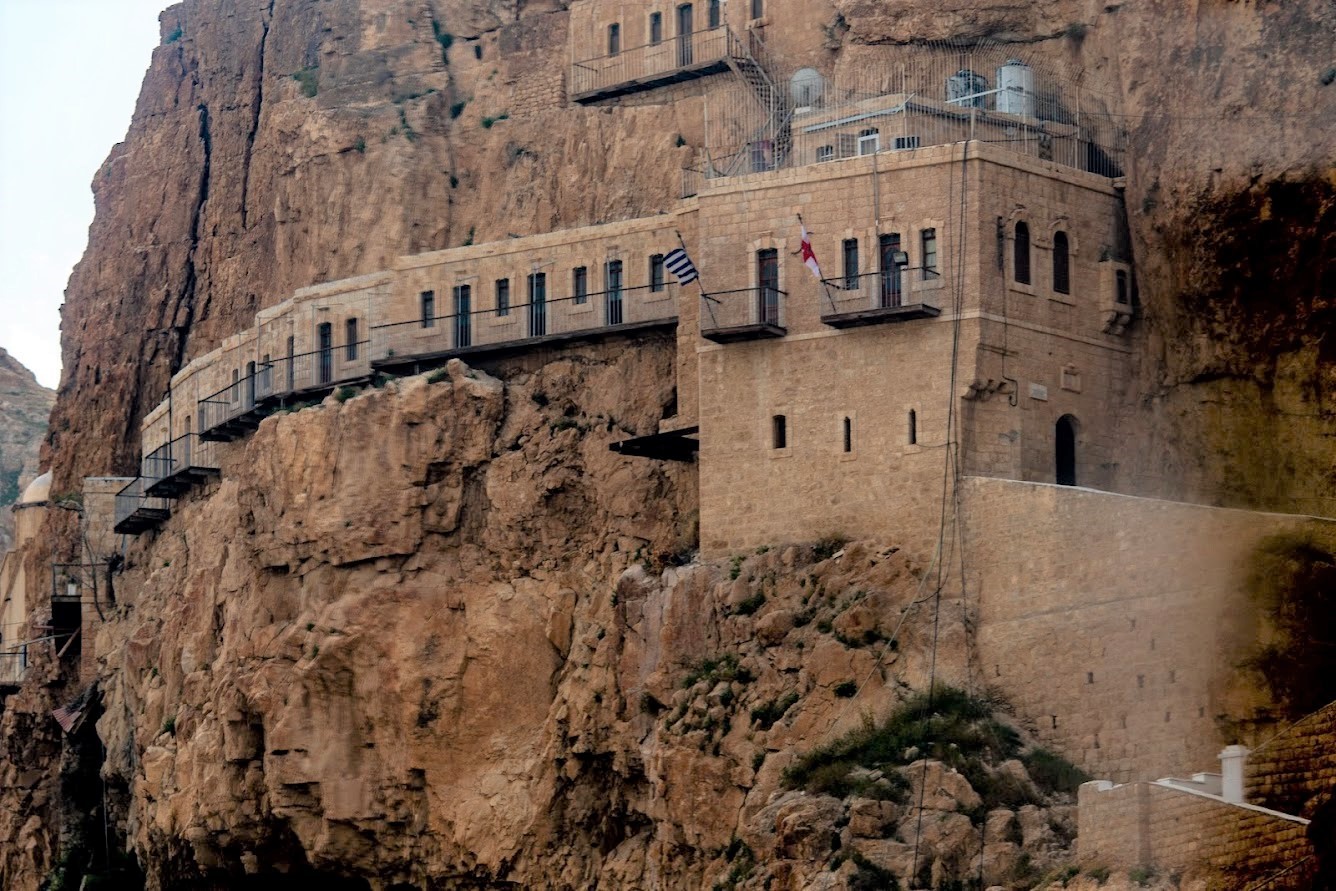
Jericho: Greek Orthodox rock monastery
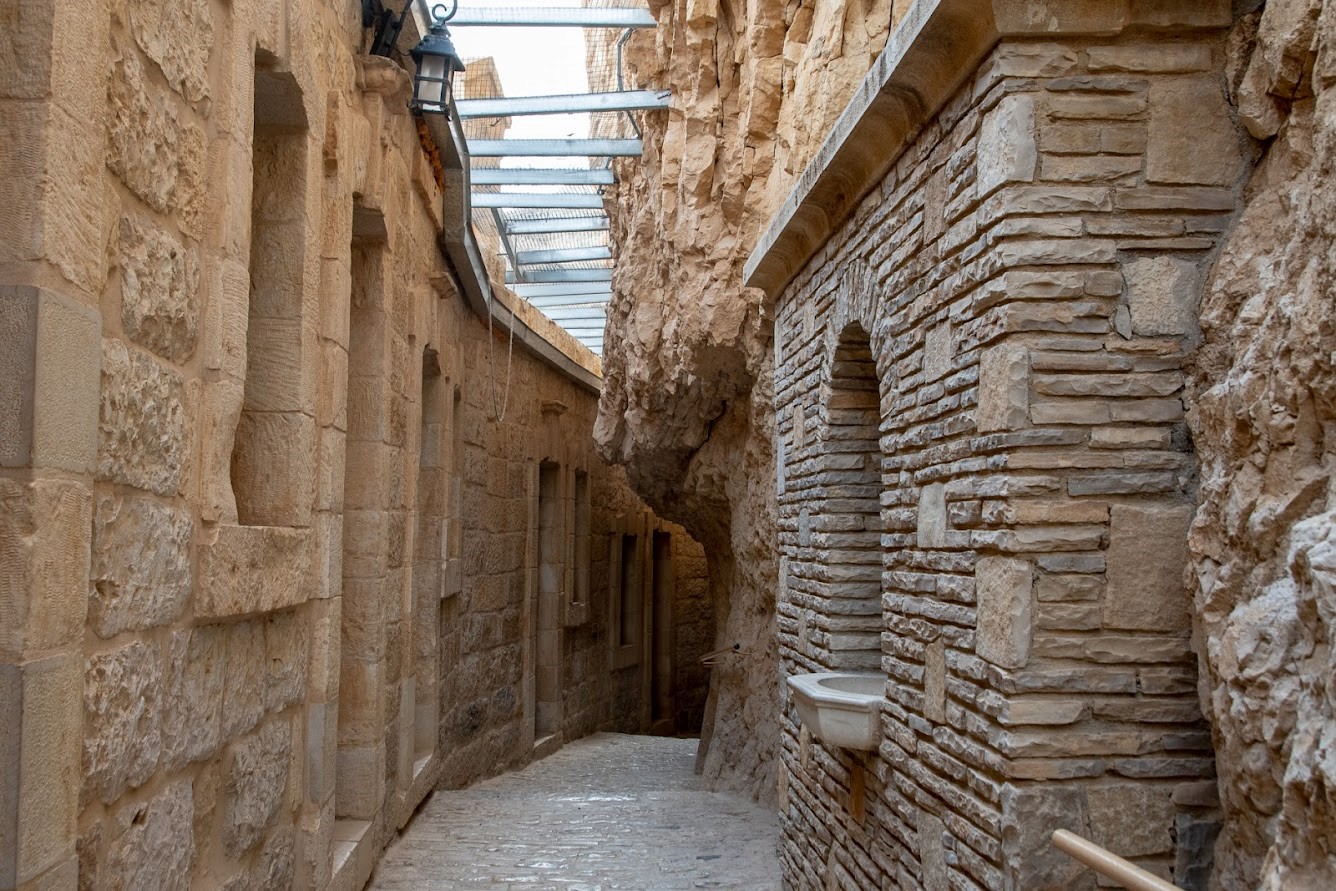
Entrance to the monastery
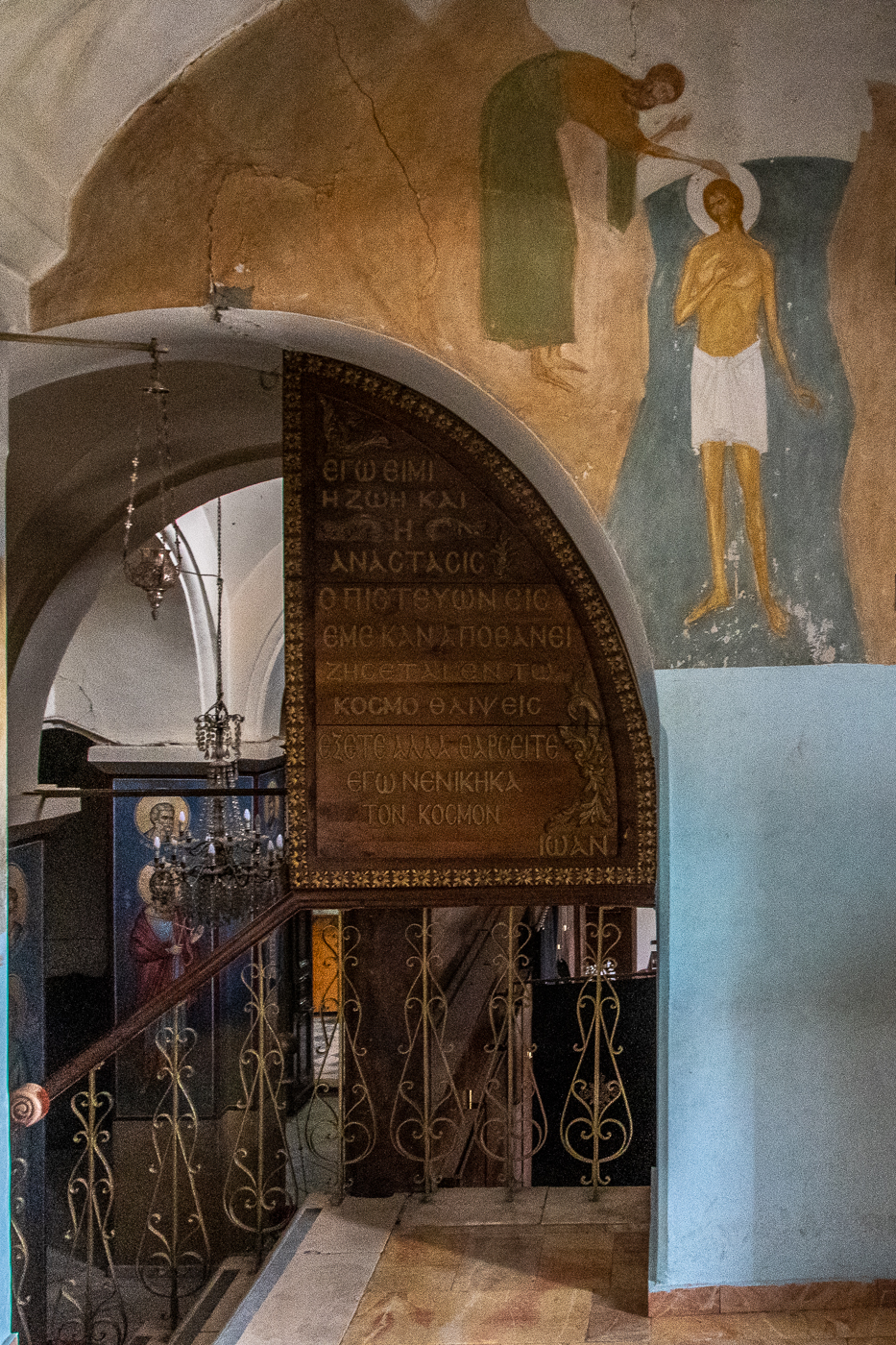
Rock monastery church
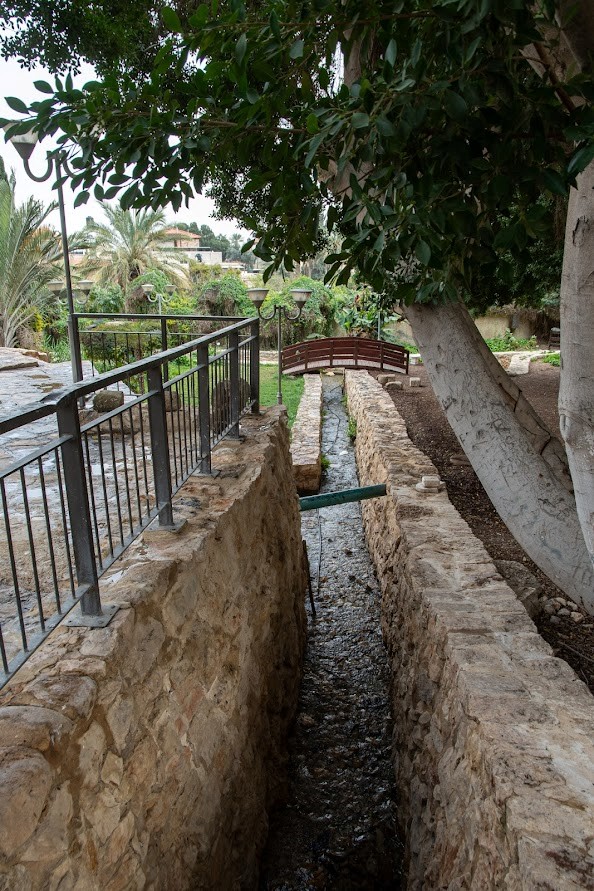
Jericho: One Sultan Source
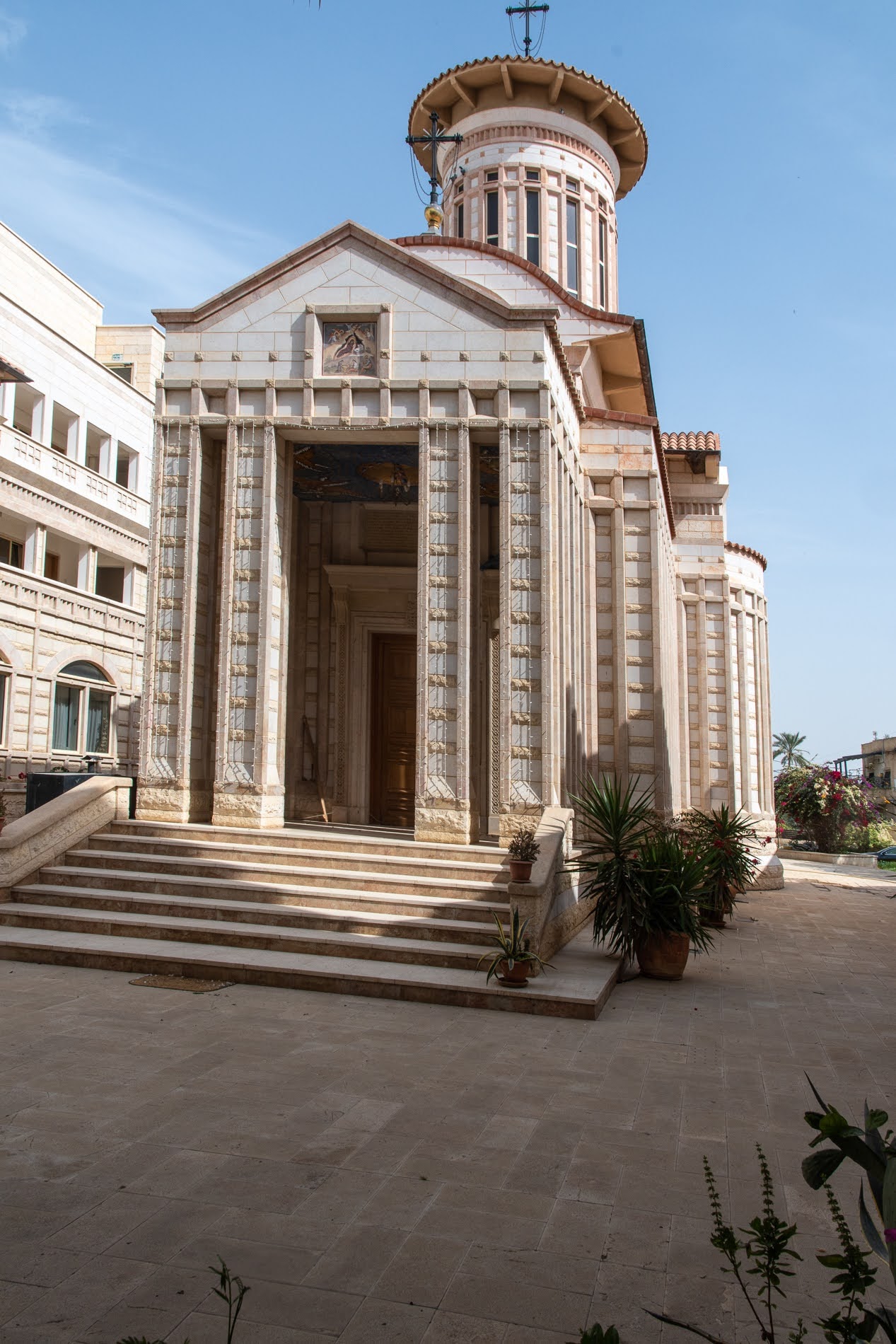
Jericho: Romanian Orthodox Church
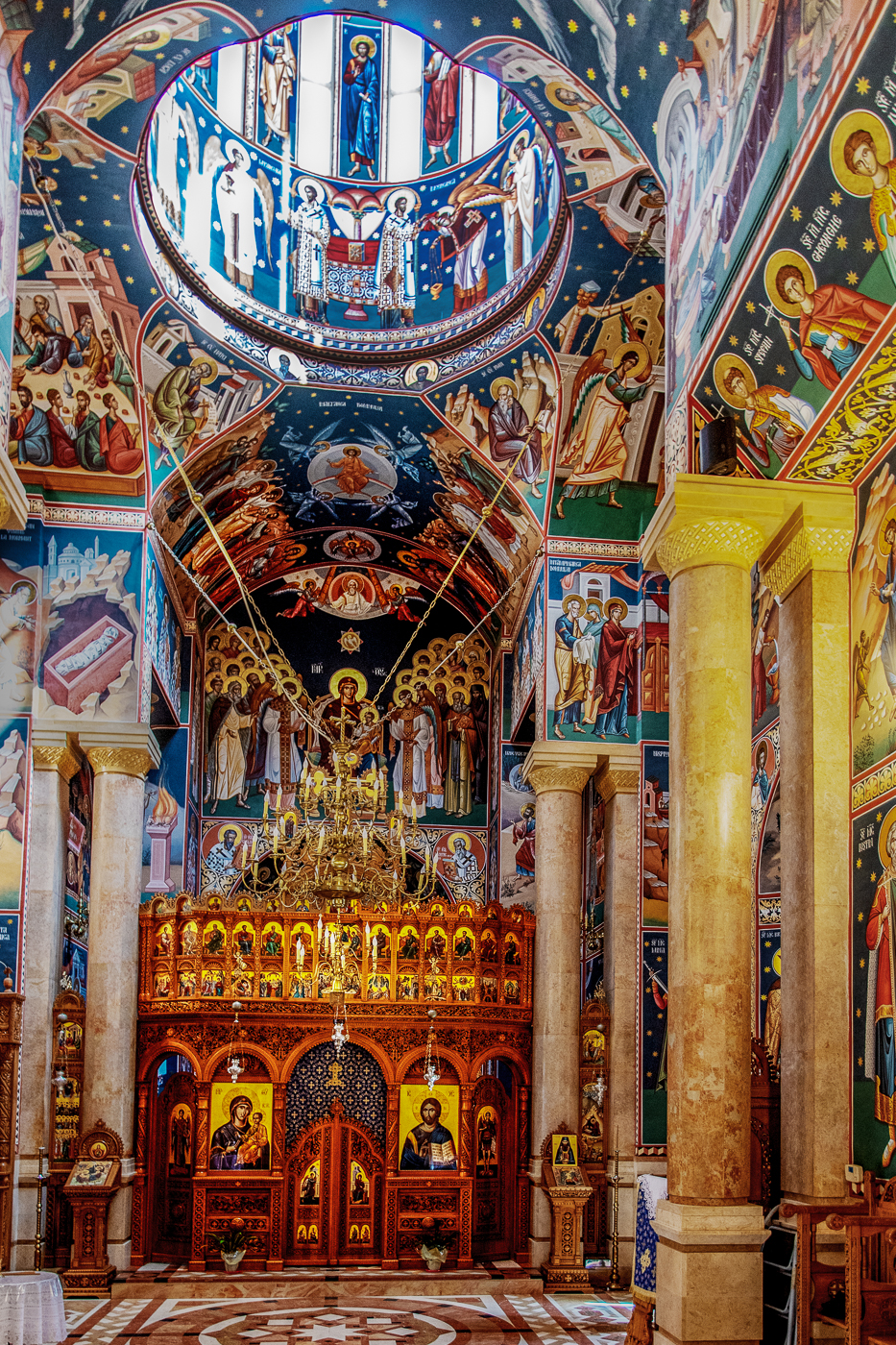
The interior of the church
We then drove to the Palestinian headquarters (which in reality consists of corrugated iron huts), where we have visited Colonel Hamza Jayyab for many years, but who is now stationed in Hebron. (He always reported to us relatively neutrally about the respective current political-military situation, his work as a mediator in conflicts between Palestinians and Israeli soldiers at the checkpoints, without constantly loudly lamenting the Palestinian fate and one-sidedly portraying Israel as the sole culprit). He always showed great interest in our projects, told about the professional progress of his children (none of them became soldiers, all of them have social and medical professions!), was always in a good mood, laughed a lot and always smilingly said “Inshallah” (God willing) regarding the future. I often wish that the soldiers at the checkpoints would be more friendly and smile more often, despite their not always safe work, especially since we German tourists are certainly not a danger. In October we would like to visit his successor, who will hopefully be in the same good mood.
Since the conversation with the wonderful Lutheran pastor Gabi Zander in the Kaiserin-Auguste- Viktoria-Stiftung near our Birgittinnen convent was cancelled (she returned to Germany on March 9 after 6 years and still had so much to do.), we were able to stroll through the pedestrian zone of West Jerusalem in the early evening, where we also had dinner, but – similar to East Jerusalem and Bethlehem – had to realize that the prices in many restaurants have probably almost doubled.
In the morning we took the last opportunity to visit the Old City of Jerusalem, also to buy souvenirs. Afterwards we met Provost Joachim Lenz in the provost’s office next to the Church of the Redeemer and an intern who had only been in Jerusalem for a few days. Again, because of ongoing renovations, the Provost’s Office was still a major construction site like Dormitio Abbey. We told him about our previous visits to the various organizations and institutions, and the provost knows practically all the institutions himself. After he informed us about the difficult time since 2020 also for the evangelical Christians in the Holy Land, we exchanged information about the current situation on the ToN u. the project of the interreligious Angel of Cultures rooftop garden, which borders directly on the café of the evangelical guesthouse. According to Propst (George Bassous expressed himself similarly, see above) the Jerusalem municipality and the various owners of the roof garden (besides the Protestant church also radical Jewish settlers) currently have neither money nor great interest in straightening this very uneven terrain with deep steps as tripping hazards and developing it as an easily walkable pedestrian area at the intersection between the neighborhoods of the Old City (despite several serious accidents with paraplegia at night due to poor lighting!). The still tense political-religious situation certainly plays a role here as well. This is of course a great pity, as this would be a pioneering intercultural peace project for the Holy Land.
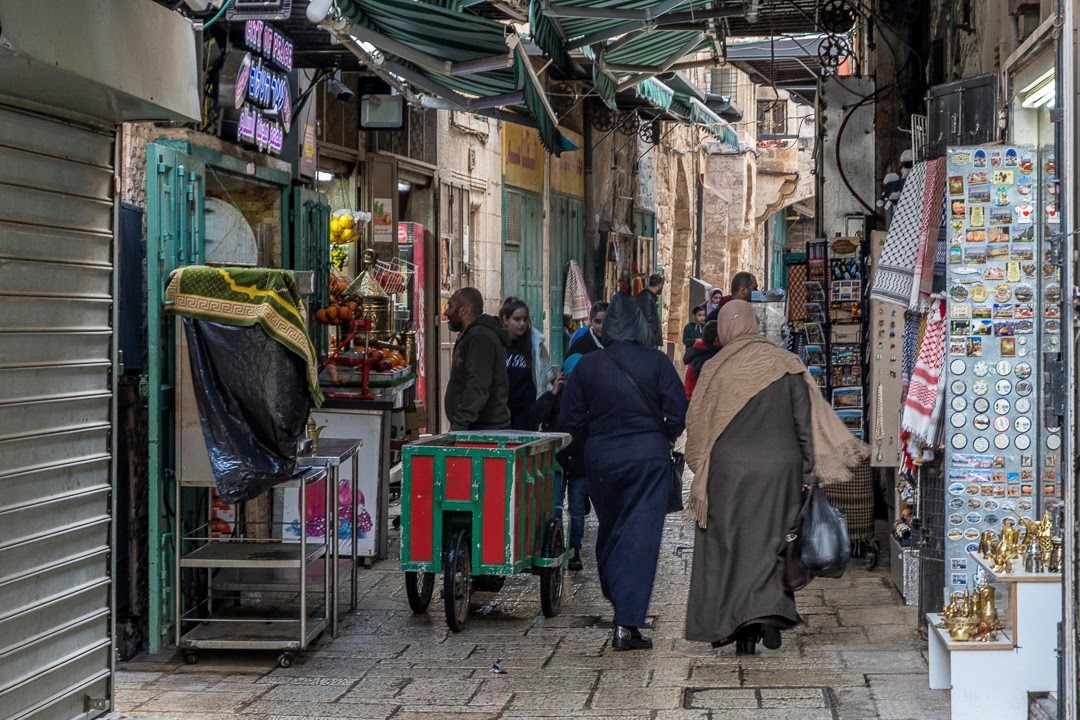
Jerusalem Old City: Souk Muslim Quarter
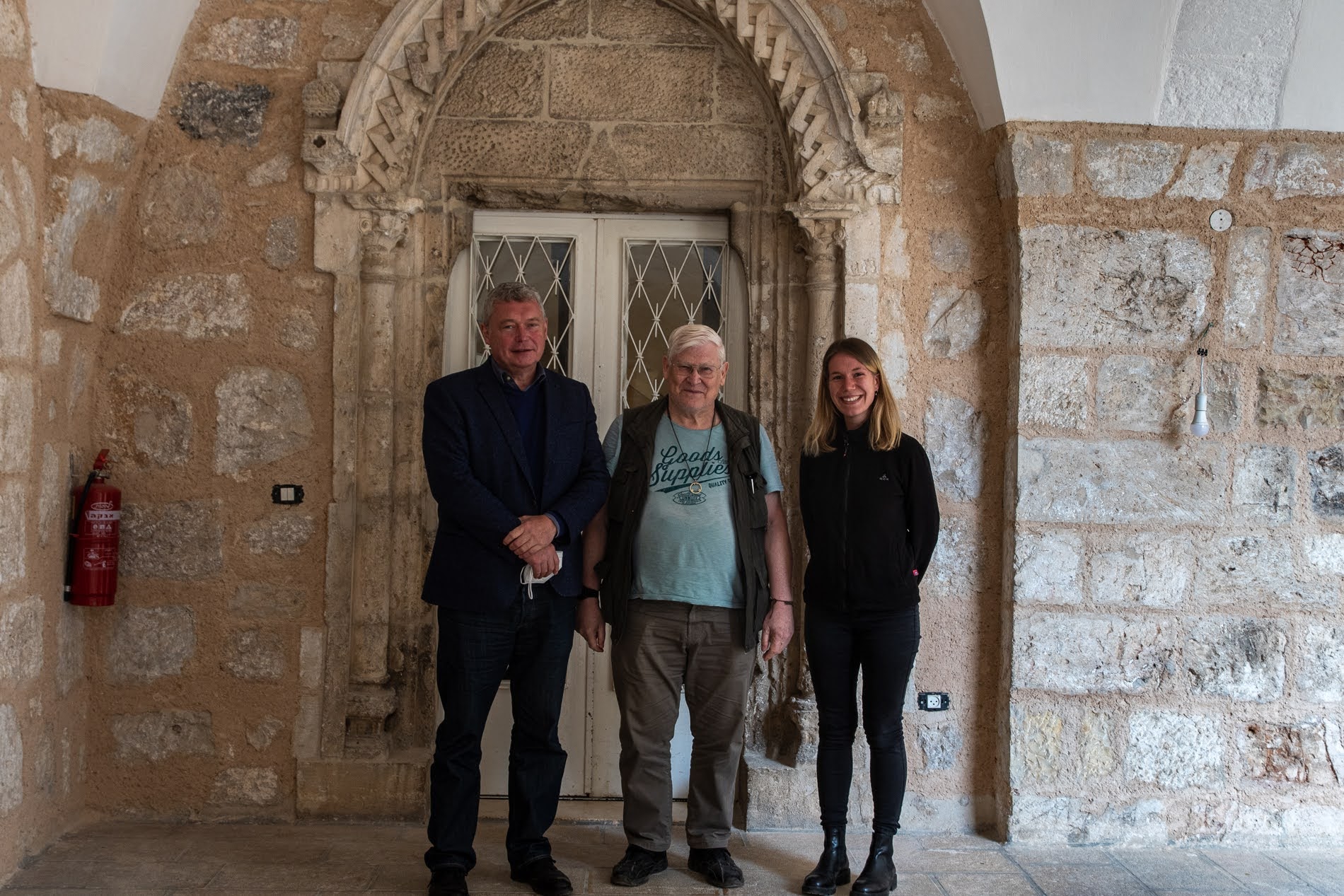
With Provost Lenz and intern
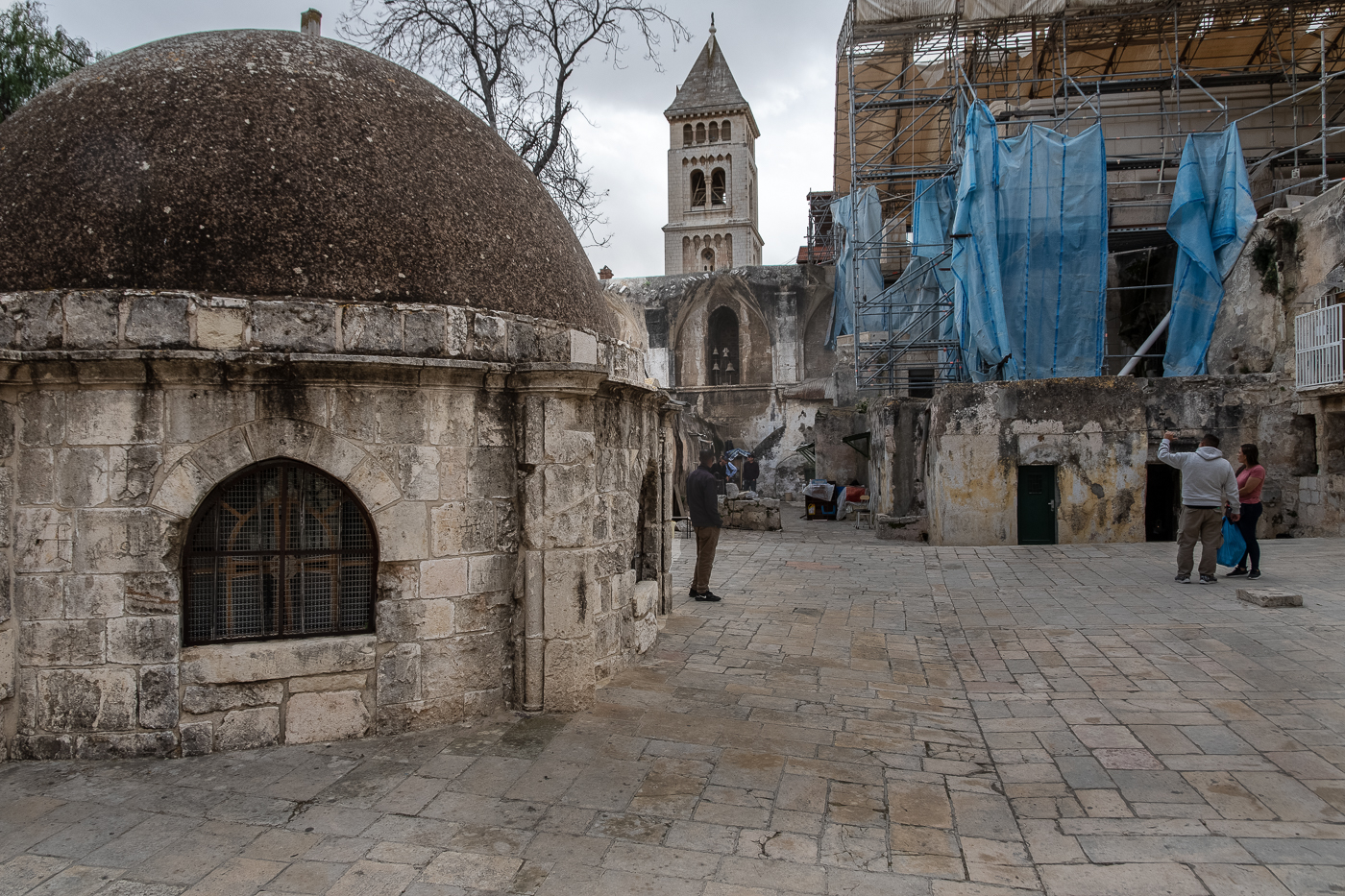
Roof garden
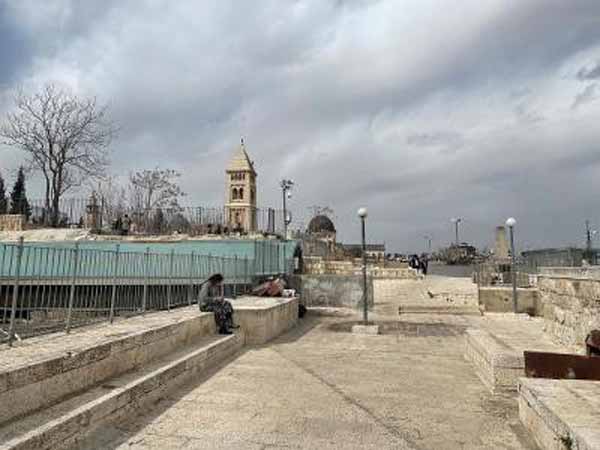
Roof garden over Jerusalem Old City
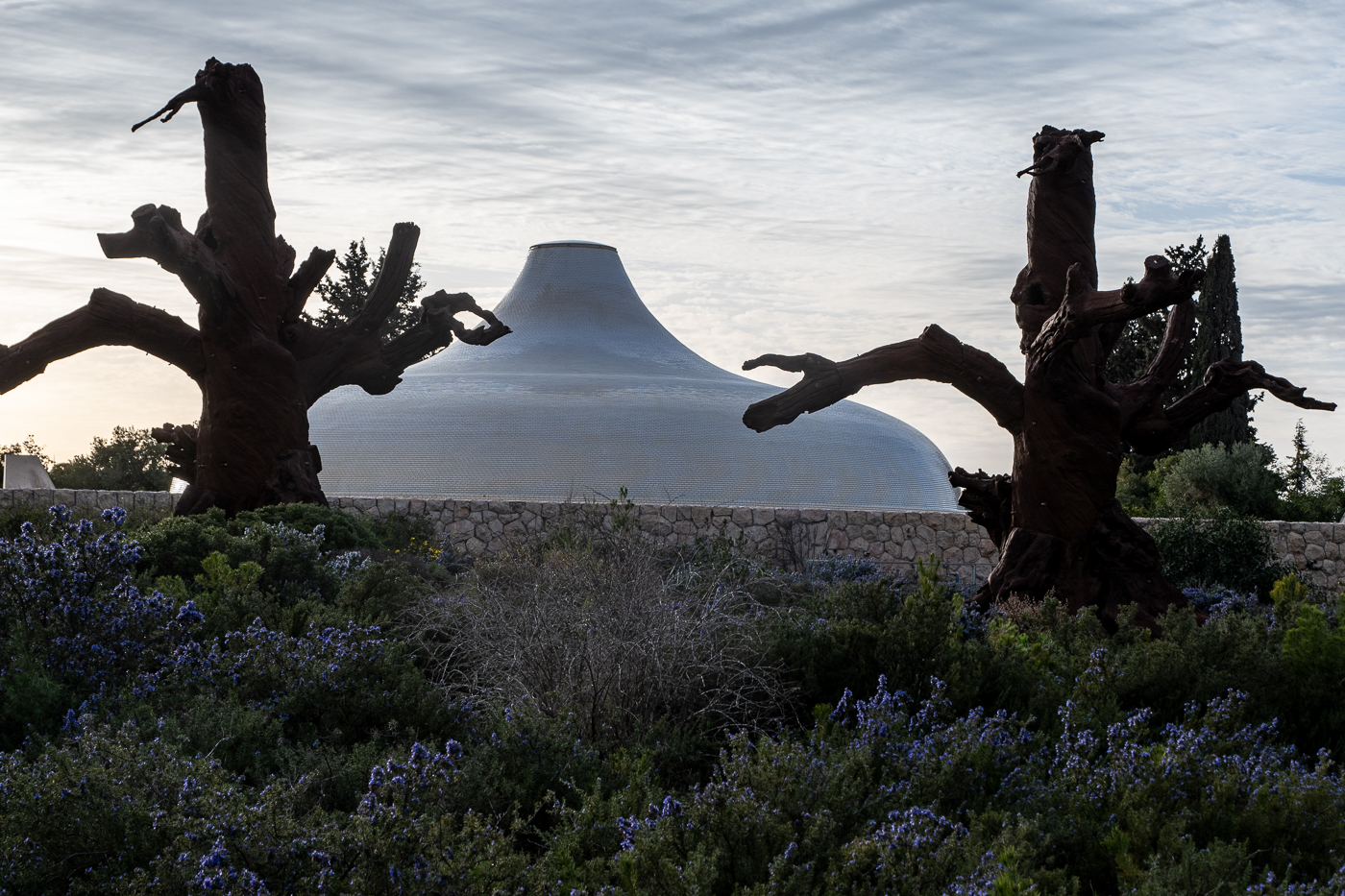
Israel Museum: Shrine of the Book
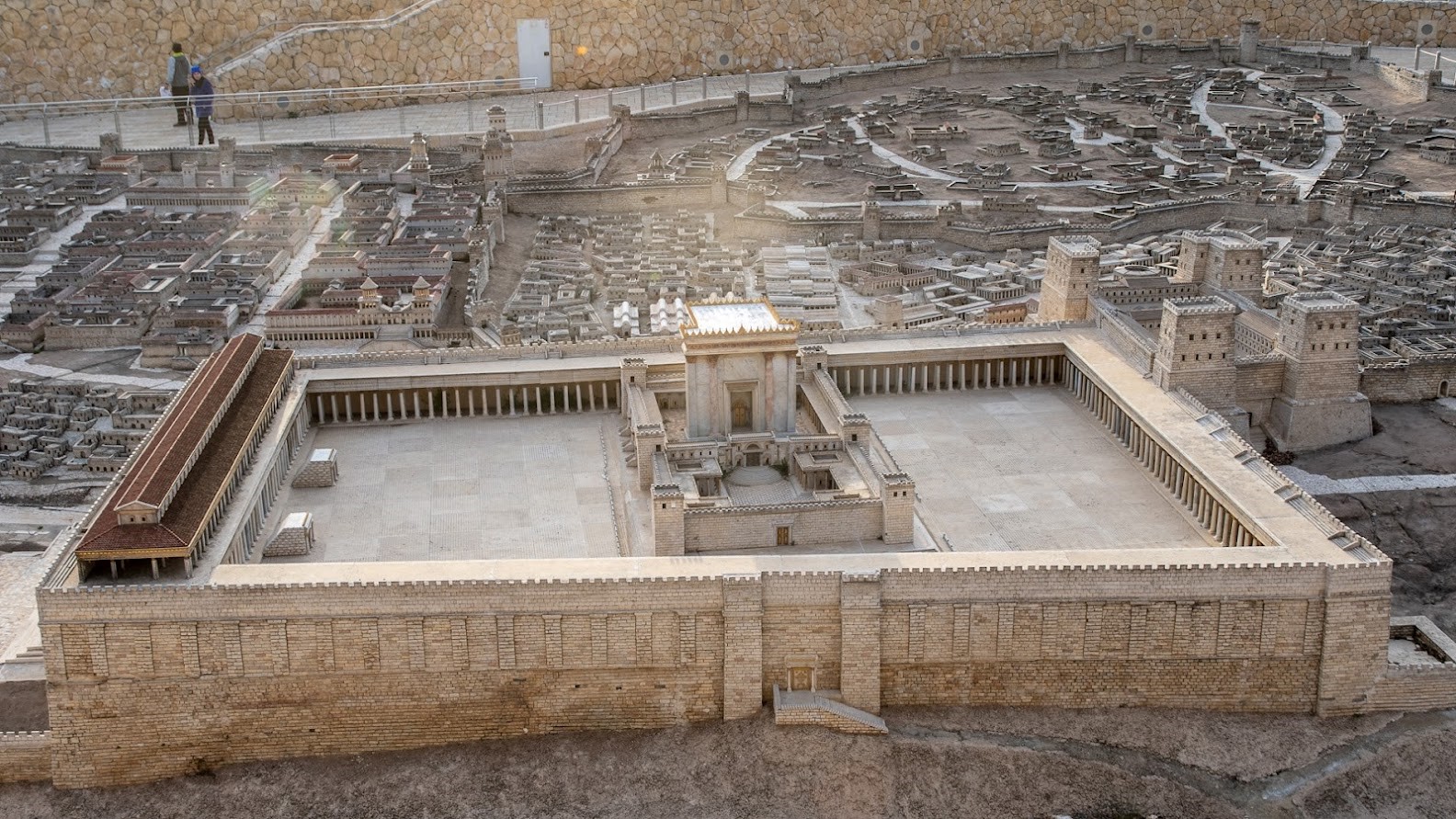
Israel Museum: Model of Jerusalem at the time of the 2nd Temple
After that, we had dinner again in East Jerusalem, where the hotel-restaurant located on Nablus Road, not far from the Schmidt School, has also been remodeled in the meantime and is unfortunately also almost twice as expensive as in 2019. Since we didn’t want to use Husam’s help so late, we ordered a local cab driver, but due to lack of knowledge of the roads as well as the Birgittine Monastery on the Mount of Olives, he drove us around East Jerusalem for 30 minutes, although there was an easy and short route with a maximum of 10 minutes driving time.
Early in the morning we drove to Haifa. Our first stop was the Bahai Gardens with the Shrine of the Bab, which I also wanted to see from the inside for the first time.
Celebration without rituals
On the holiest days of the Ridvan period, the first when Baha’u’llah, the successor of the Bab announced that he was the Promised One, the ninth when his family visited him in the Garden of Ridvan, and the twelfth when he left the Garden, the Baha’i do not work. They meet on these days to hold devotions and celebrate. In some countries, such as India, children are also off school. Exact beginning of Ridvan festival is April 21, 2 hours before sunset. For the feast, religious gatherings are held in devotional rooms with common prayers and celebrations. The story about the time Baha’u’llah spent in the Garden of Ridvan is told, read aloud, or acted out by the children as a play. Afterwards, celebrate at home with a good meal. Even though there are no set rituals for the celebration. For the Bahai do not know such. Likewise, there are neither ceremonial services nor a religious clergy. Community affairs are carried out at the local, national and international levels by democratically elected bodies. Also on the first Ridvan day, local bodies are convened, the “spiritual councils,” each consisting of 9 people. Before that, they must be elected from the entirety of the community and then exercise their religious office for one year.
Unfortunately, it had rained a bit before. The security guards at the lower entrance to the Bahia Gardens therefore thought that the steps were too slippery for tourists, so only members of the Bahai religion were allowed in. So it was again nothing with the visit of the Bab shrine.
We now drove up to the pilgrim house of the Carmelite monastery “Stella Maris” on the slopes of the Carmel Mountains, where we have stayed with our group for many years, and visited Sister Edith, who also told us about the past difficult Corona years and had missed our group very much. From here you have a great view of Haifa, the harbor and the Mediterranean Sea. After visiting the main church and the Elias Cave inside, we drove to the upper entrance of the Bahai Gardens, from where we had another fantastic view of the gardens, the Shrine of the Bab (landmark of Haifas) and the Mediterranean Sea.
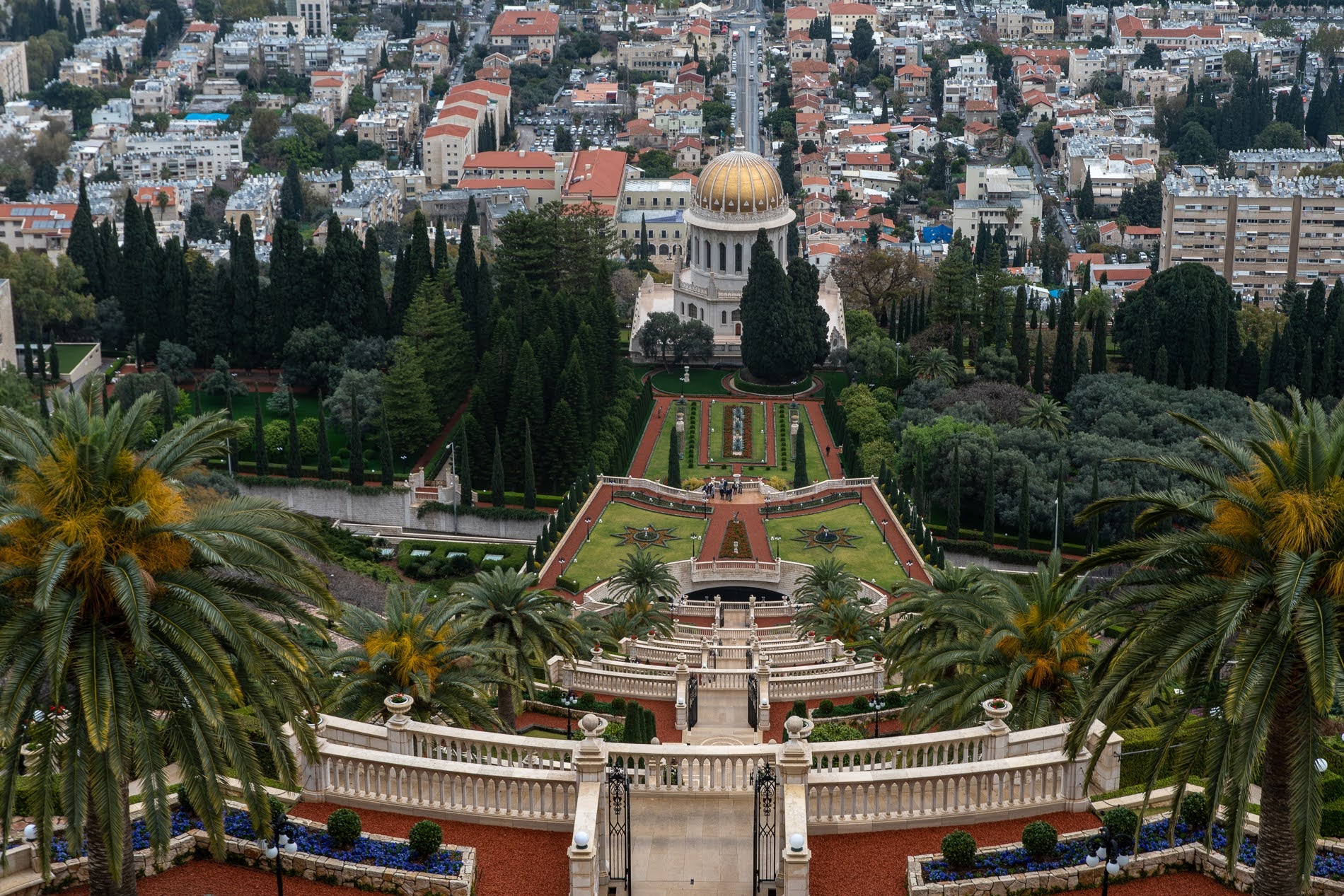
Haifa: Bahai Gardens with Shrine of the Bab
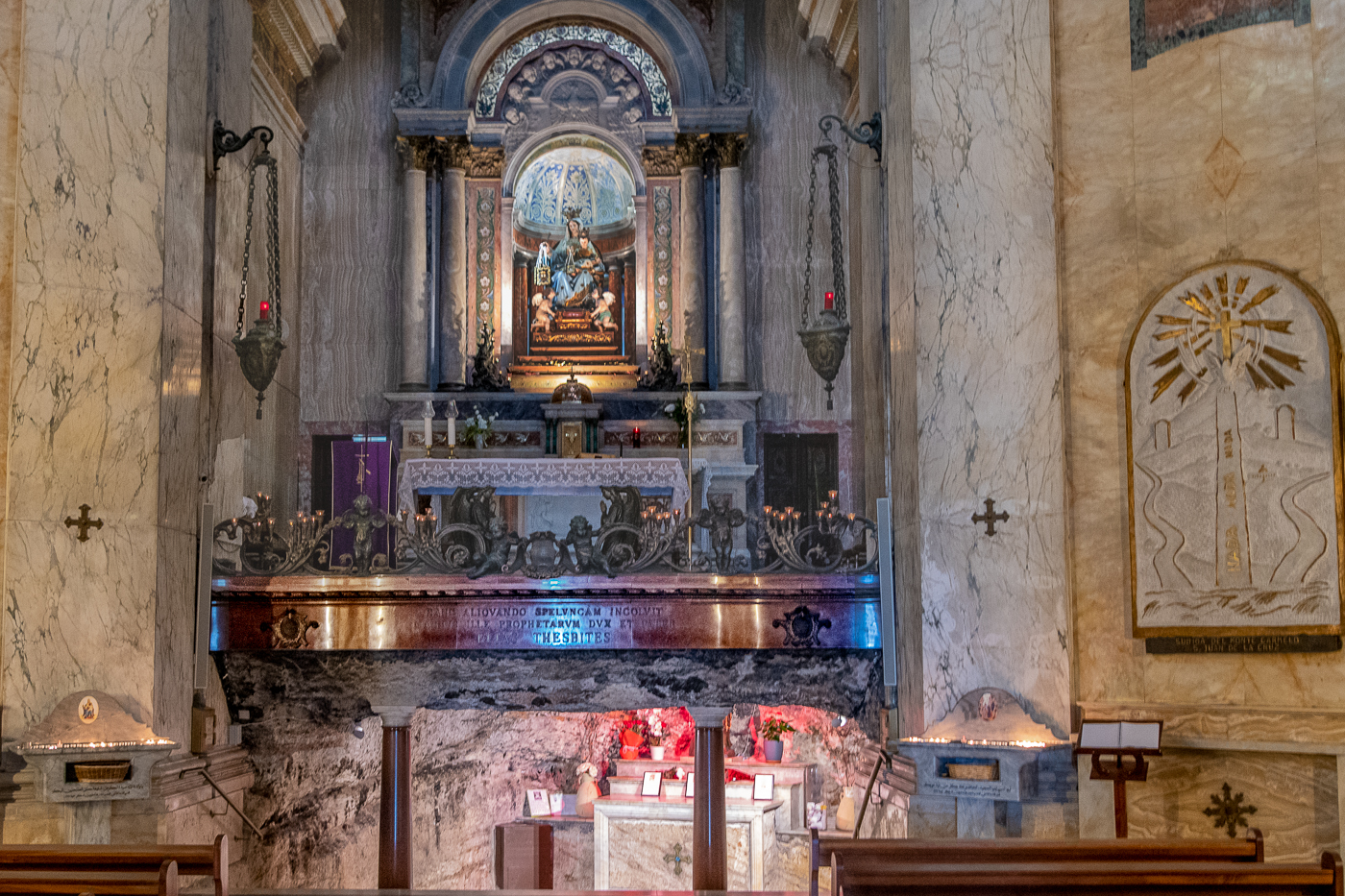
Monastery church Stella Maris
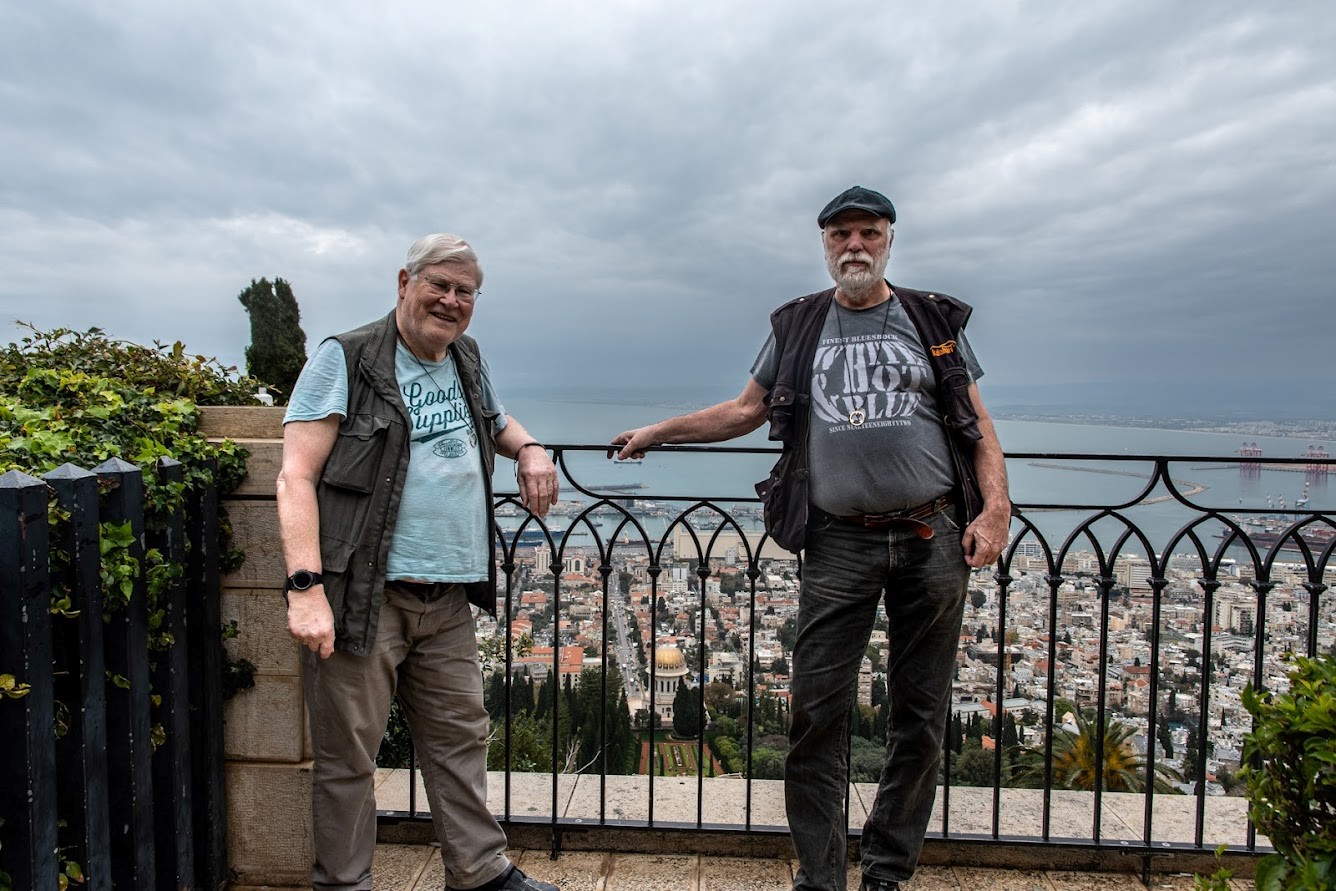
View of Haifa and Mediterranean Sea
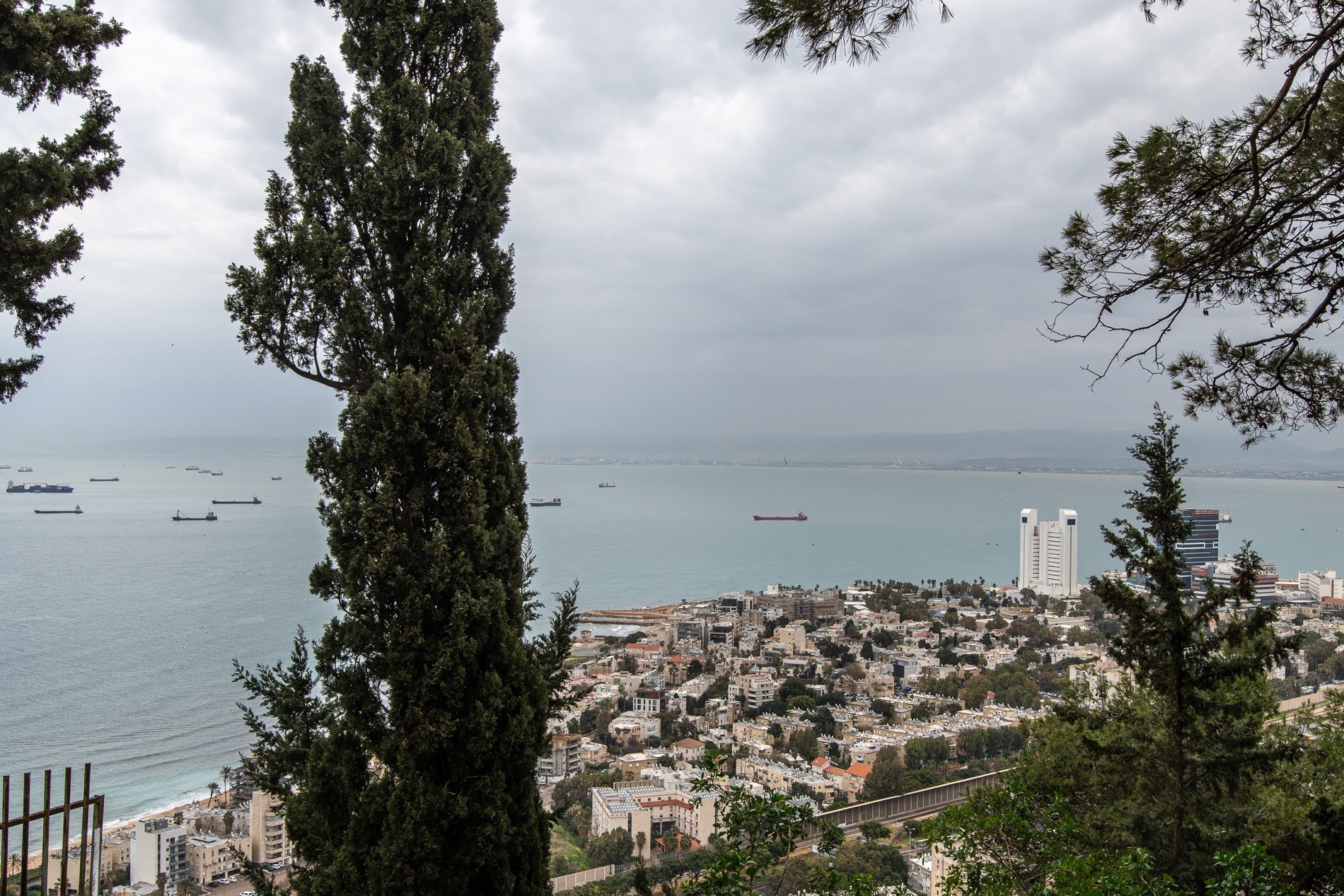
View of Haifa and Mediterranean Sea from the slope of Carmel Mountain
From Haifa we drove to the former Crusader city of Akko, where we visited, among other things, the well-preserved city wall, the wonderfully painted Al-Jazzar mosque and the famous, ever-excavated, huge underground Crusader city (so far only approx. 15% uncovered so far), we also visited the underground passages that lead to the sea and enabled the besieged to escape or to be supplied with food, etc., which is why this fortress was not conquered by the Mamluks until 1291 and was even besieged in vain by Napoleon in 1799. I still wanted to show Roland the harbor with its wonderful Panomara and view of the Mediterranean.
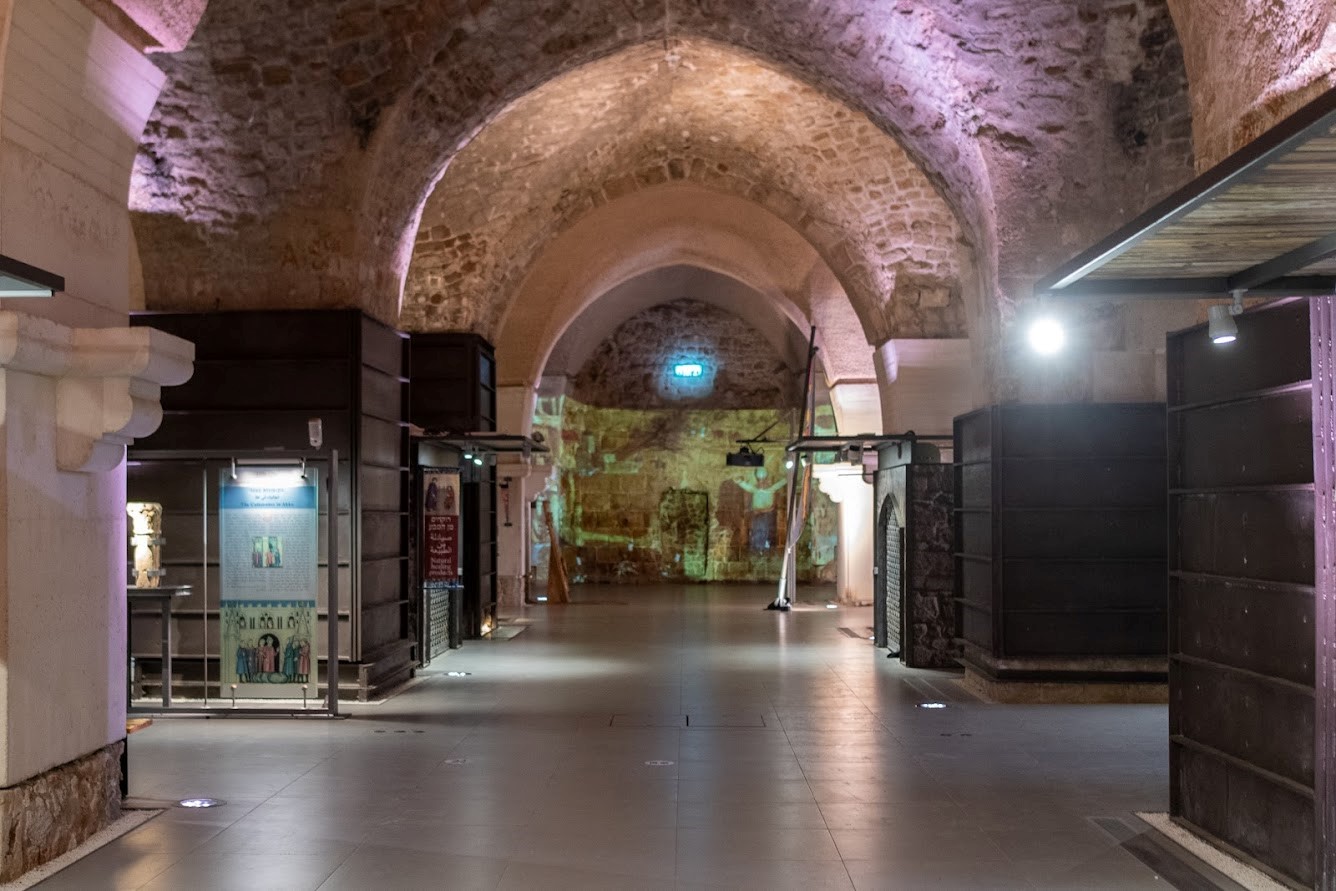
Acre: underground crusader city
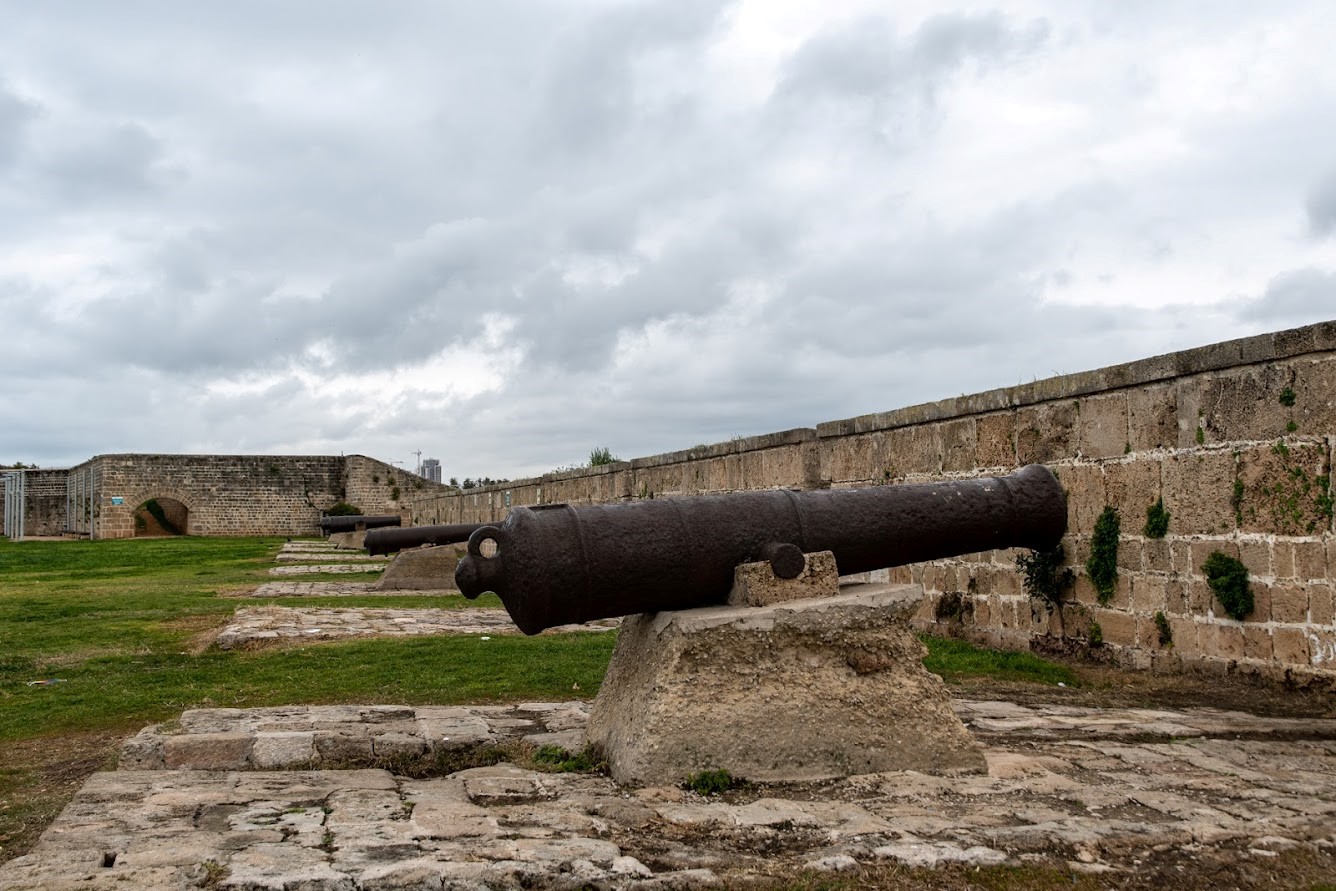
medieval city walls of Akko
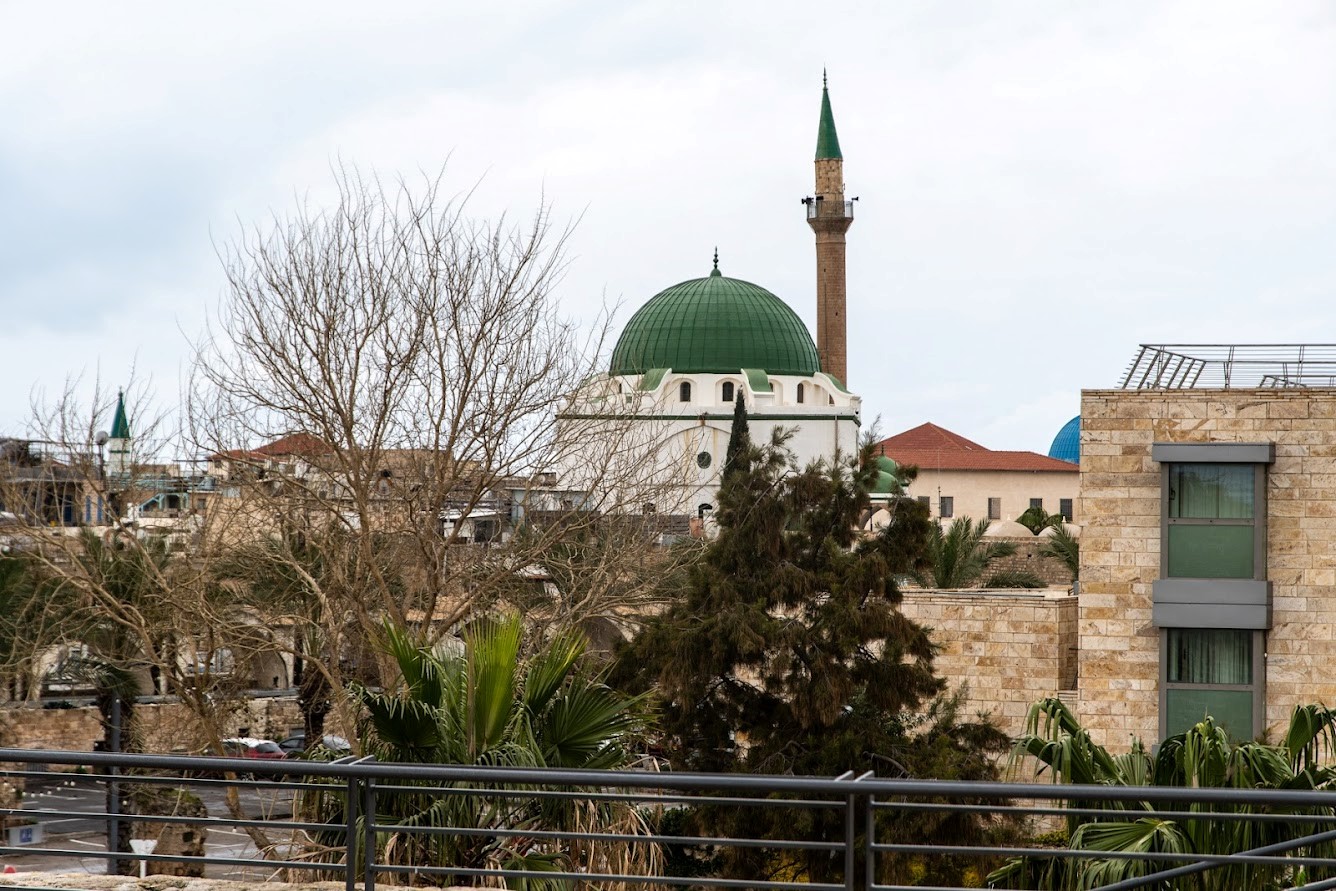
Acre: View of Al-Jazzar Mosque
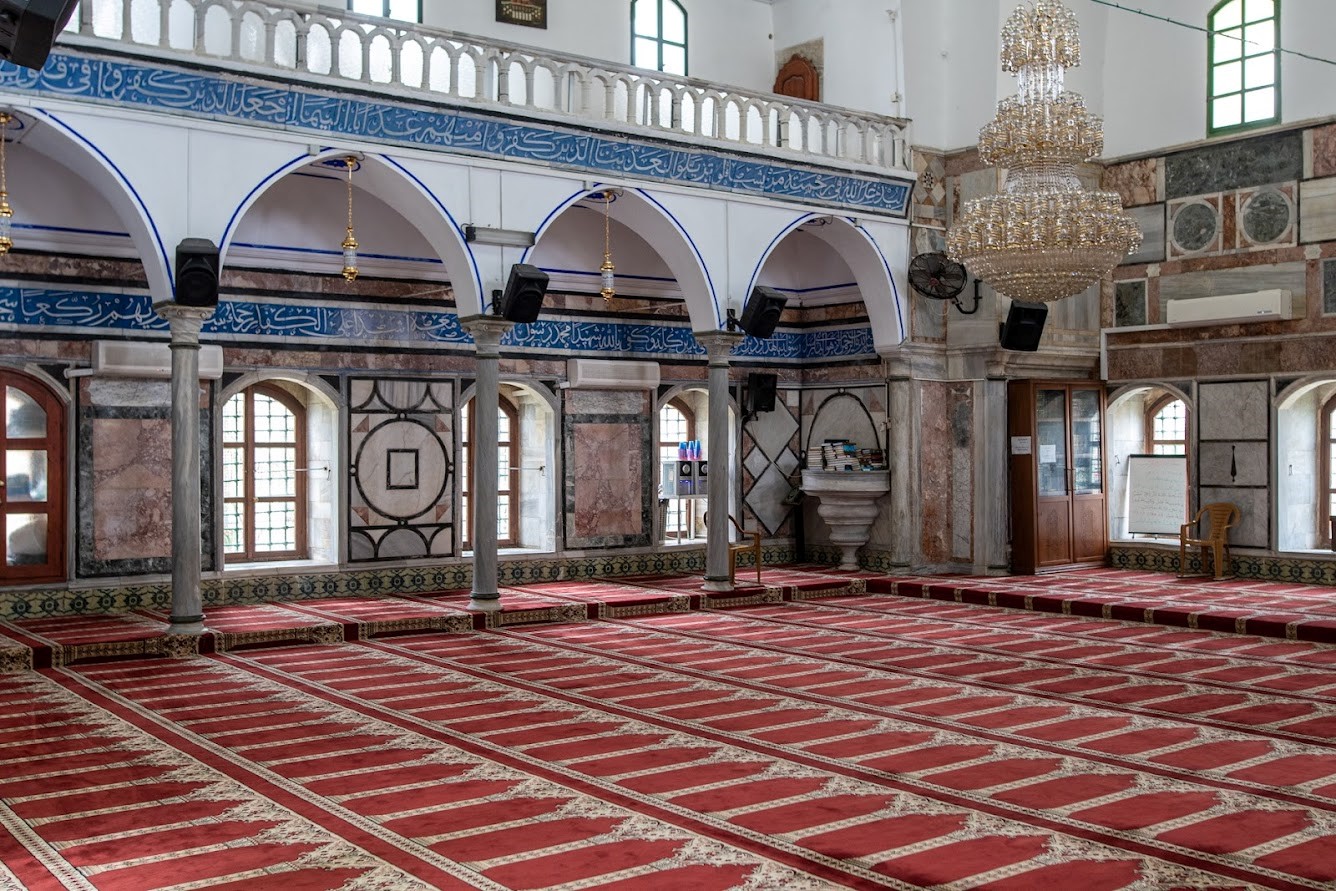
the Al-Jazzar mosque from the inside
However, there was very little time for this, as we absolutely wanted to go to Tiberias and the sights at the Sea of Galilee. We visited there first the “Mount of Beatitudes” beautifully situated on the lake with the church from the 60’s, then Capernaum, the city where Jesus taught in the synagogue (foundation walls of the black synagogue from the 1st century AD still visible under the ruins of the Byzantine synagogue), lived in the house of Peter’s mother-in-law for a while and probably performed the first rituals with his disciples, later called Christian. Above the ruins of this house, a glass-bottomed St. Peter’s Church was built in 1990, so you can see these remains very well from above.
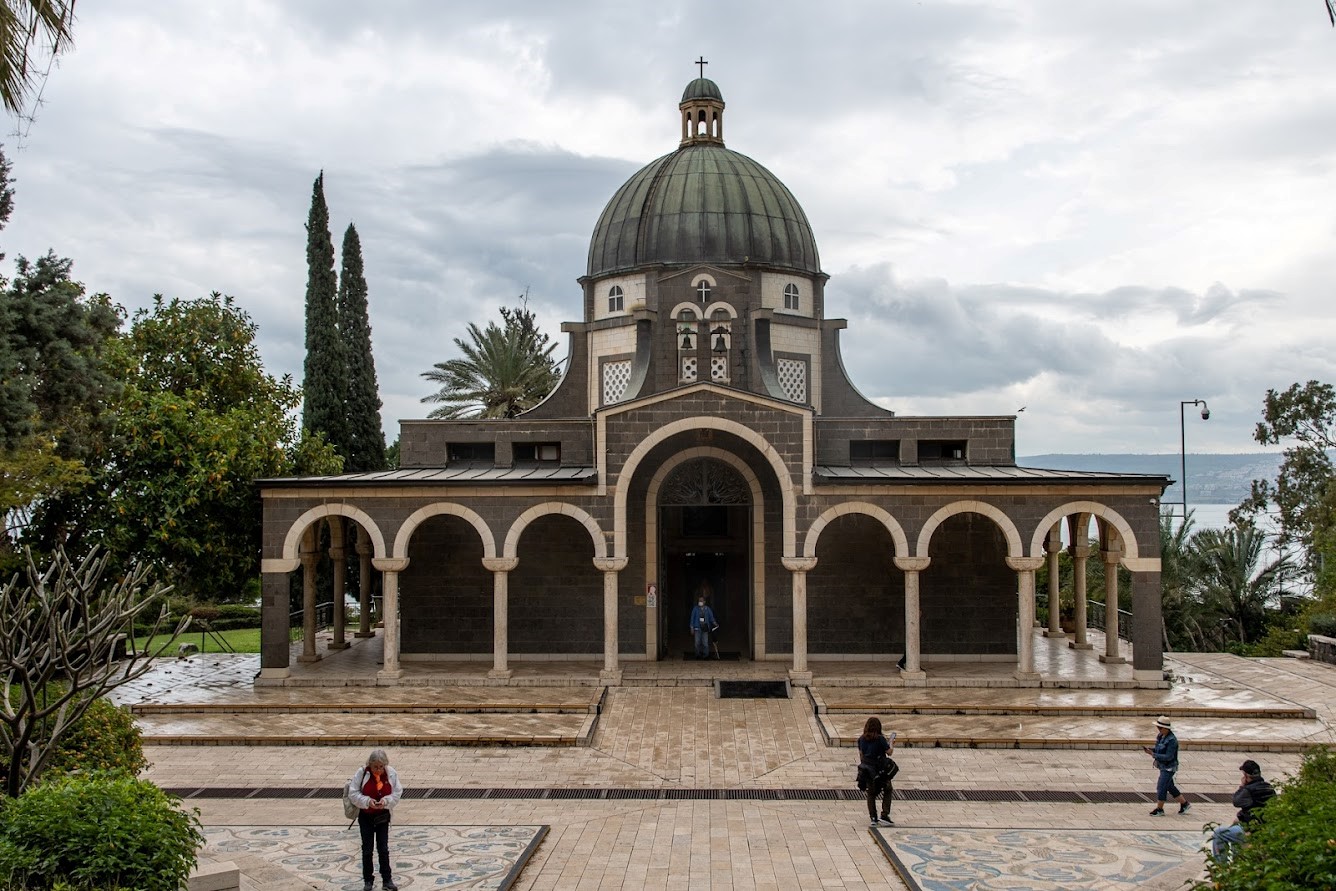
Church on the Mount of Beatitudes
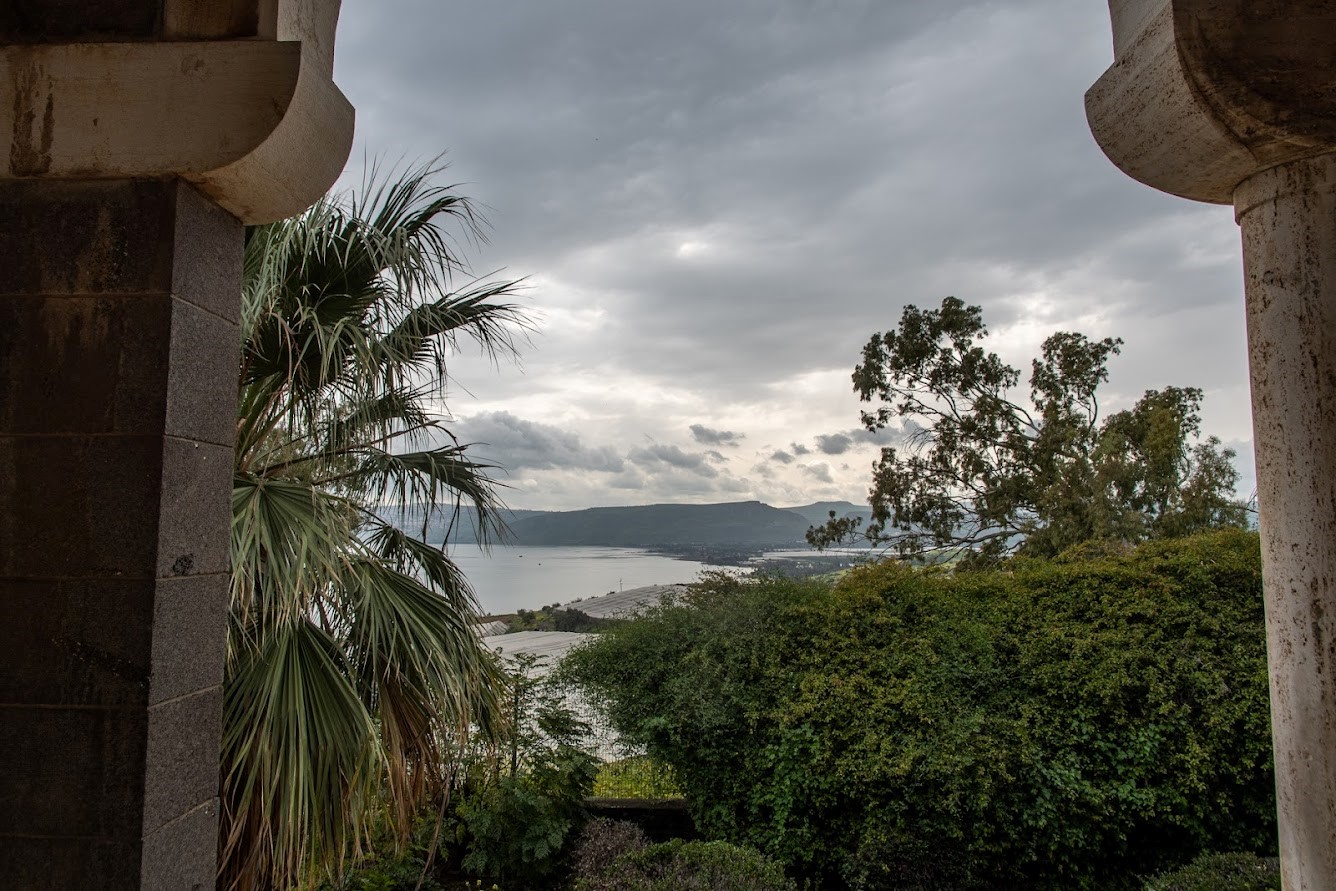
View of the Sea of Galilee
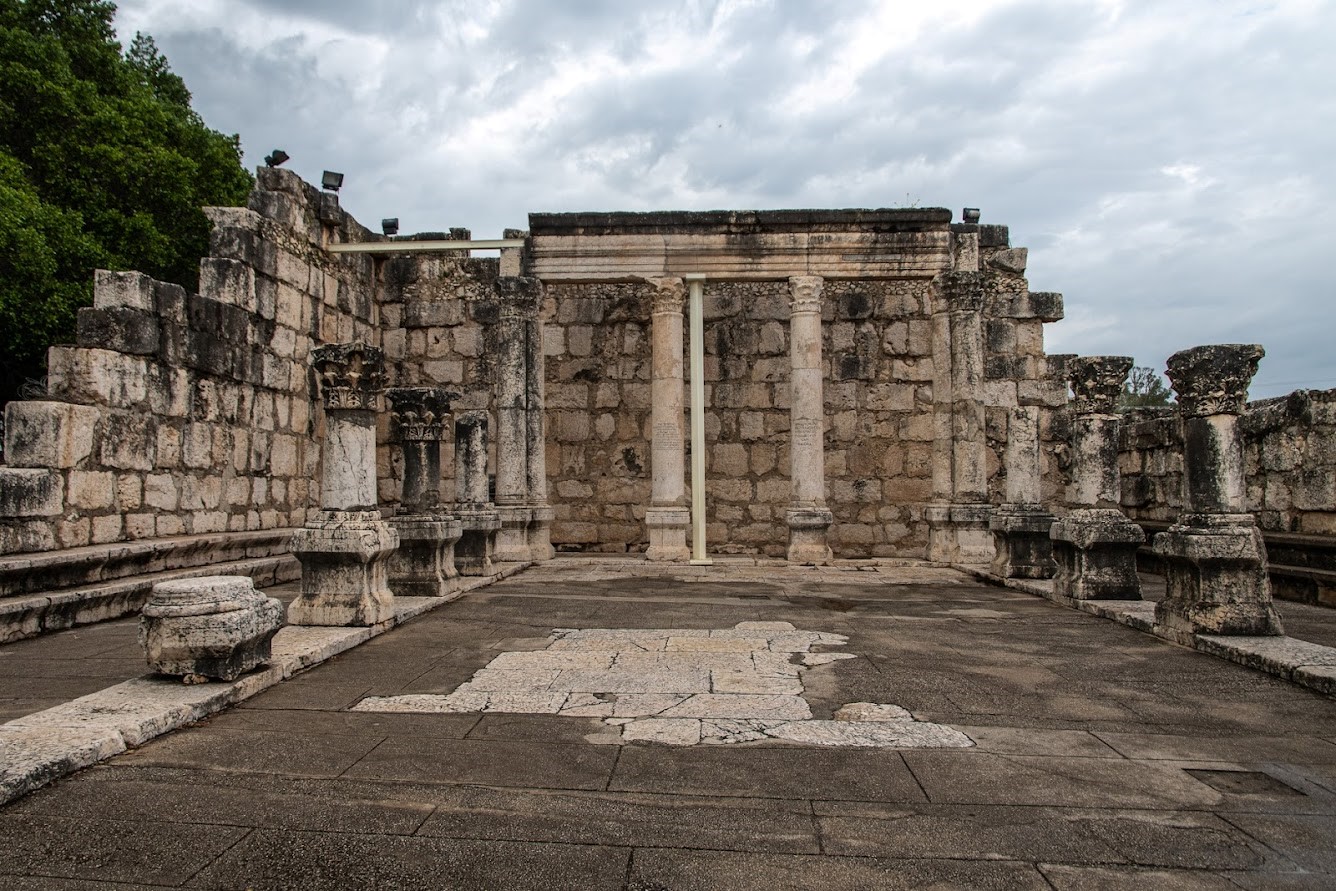
Capernaum with remains of the Byzantine synagogue
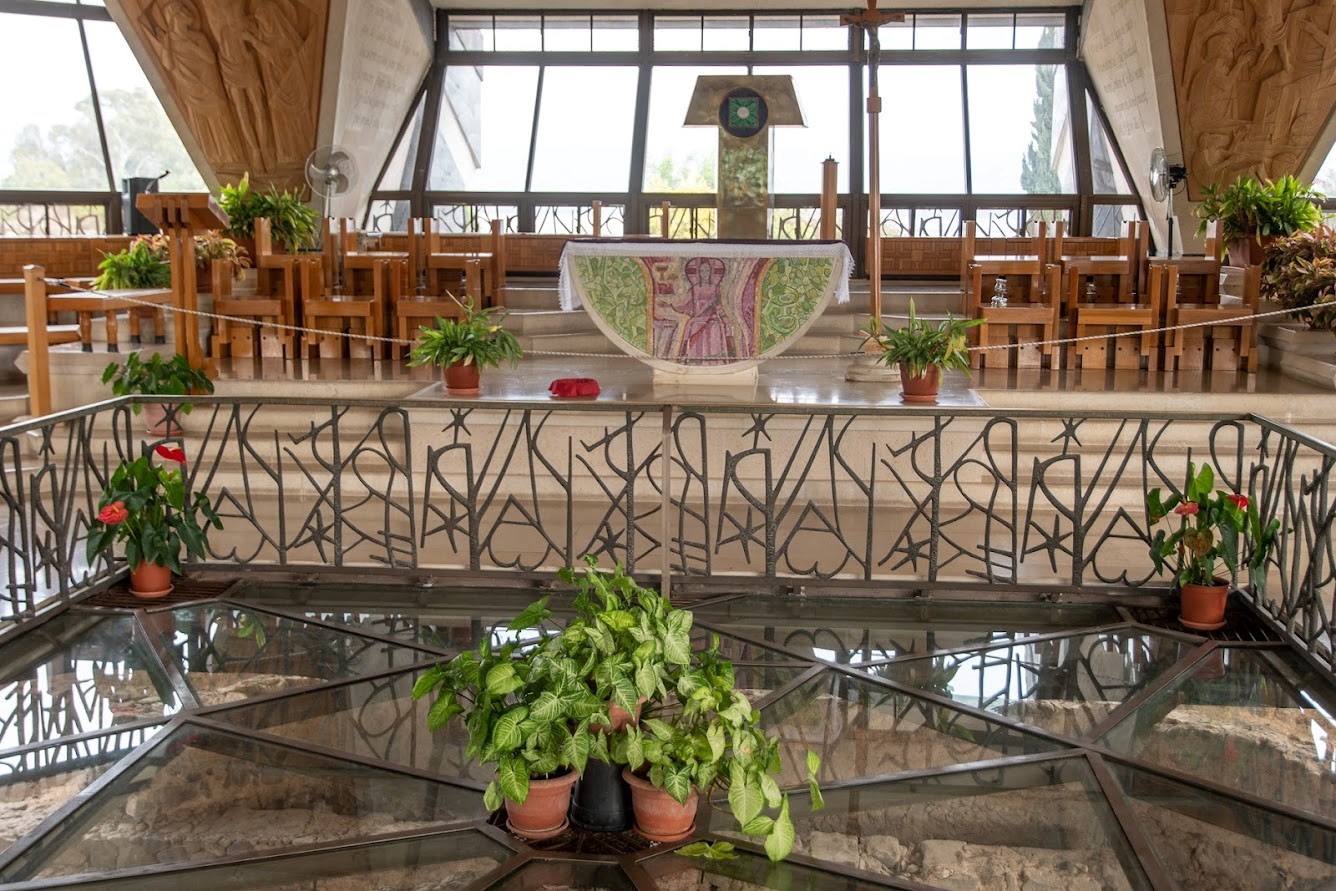
Church over the ruins of St. Peter’s House
After visiting the guesthouse and the Church of the Multiplication of the Bread in Tabgha, we drove to Tiberias, where we wanted to check with hotels or hostels ourselves because of the futile reservation of accommodations for our group in October. It turned out that because of Sukkot incl. vacations in this period, some travel companies have blocked a lot of rooms as a precaution, so that bookings from abroad were difficult. Finally, we found free rooms only in the newly built Aviv Hostel (not far from the extensive lake promenade), but for an average of 120 € (but with great breakfast and dinner buffet). Unfortunately, the prices for gasoline, catering etc. have also risen very sharply, so that already our trip in October will become considerably more expensive.
Before returning to Jerusalem, we stopped just past Tiberias at a bridge over the Jordan River, from which one has a very good view of this place, formerly exclusively and still occasionally revered by pilgrim groups (dressed in white baptismal robes) as the alleged baptismal site of Jesus (Yardenit). Since 2015, it has been possible to visit the real baptismal site of Jesus, Qasr El Yahud, south of Jericho, as it is no longer a restricted military area.
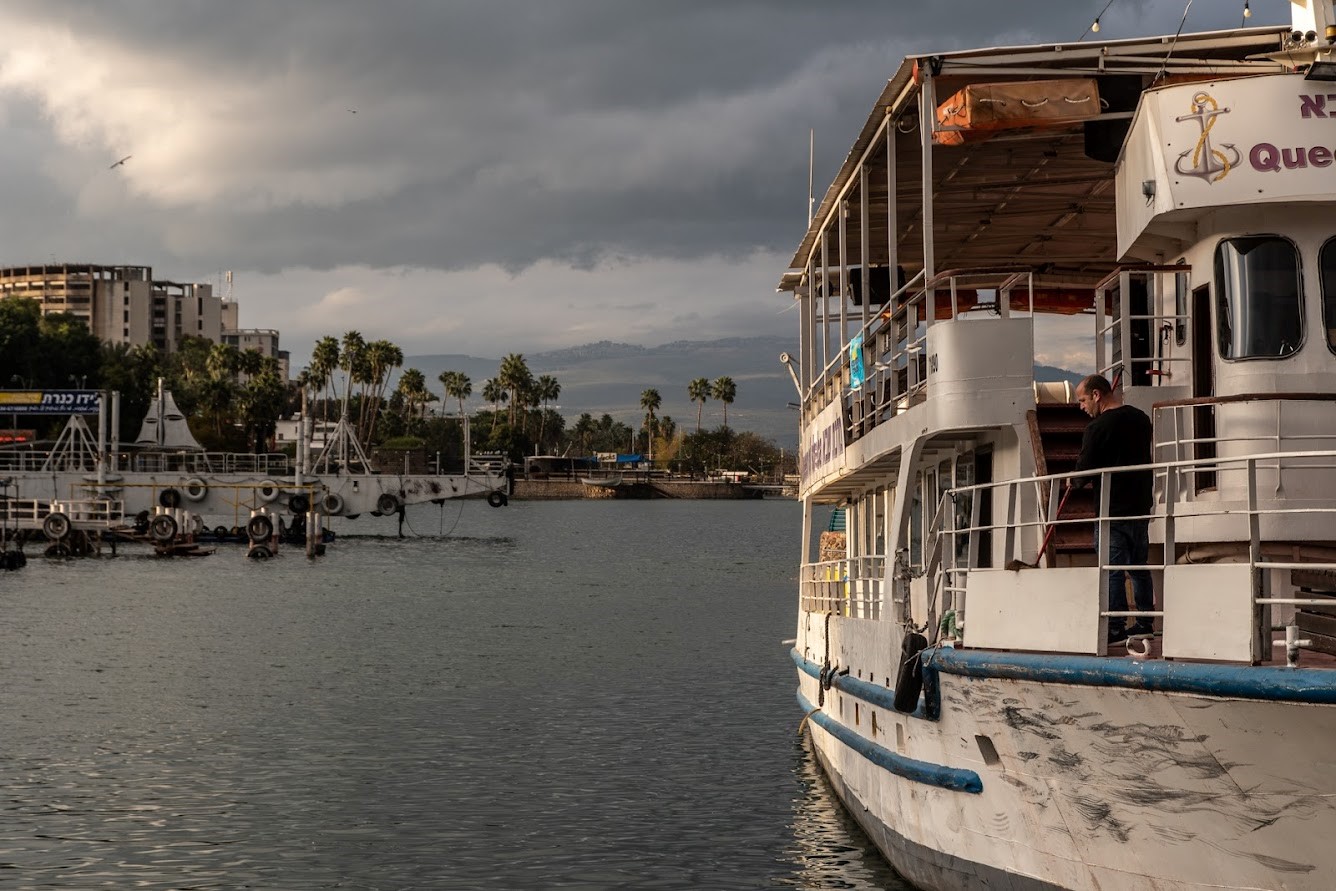
Tiberias: Promenade view of Sea of Galilee
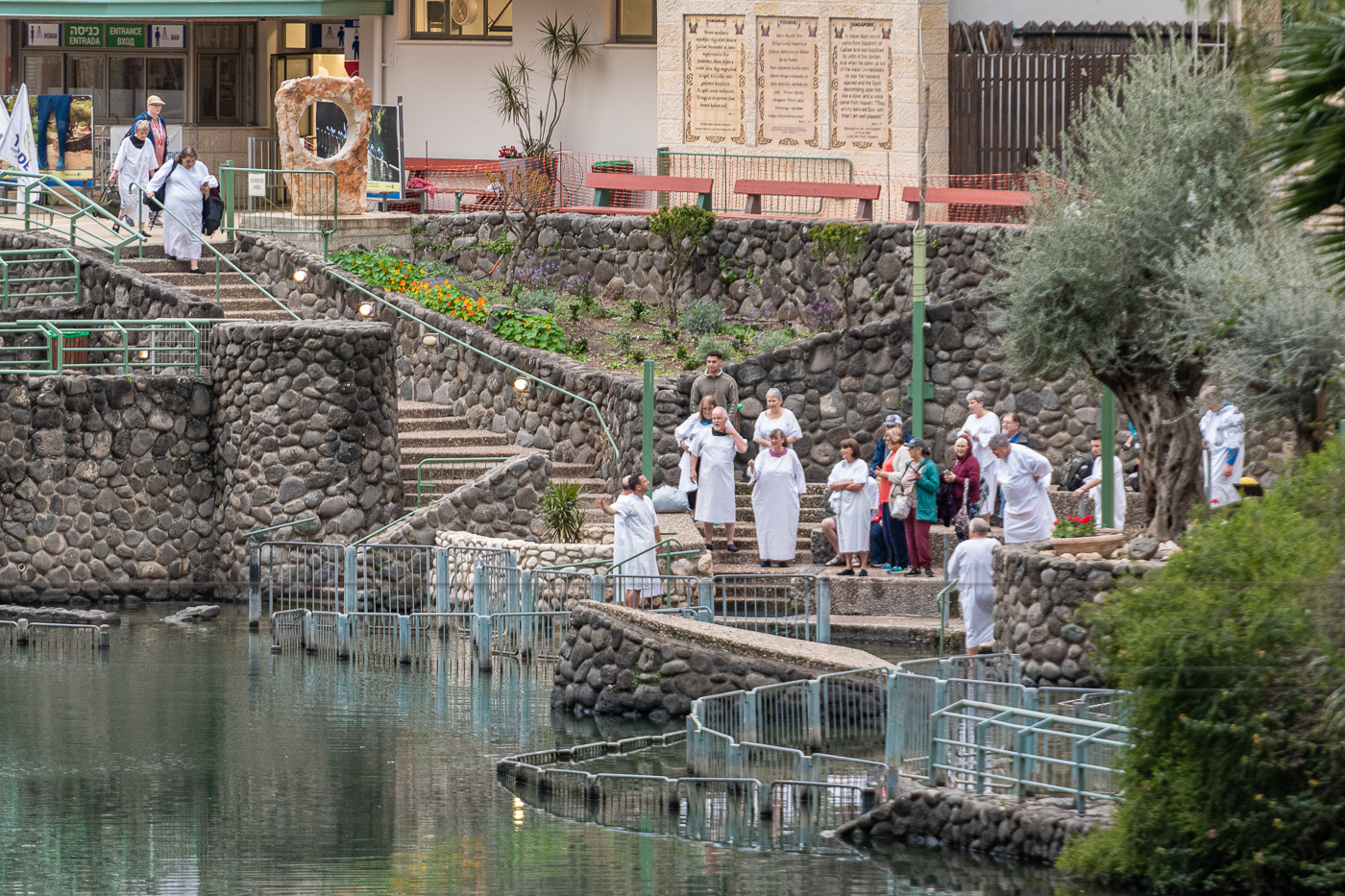
alleged baptism site of Jesus at the Jordan River near Tiberias (Yardenit)
Since it was almost dark by now, we headed straight back to Jerusalem, where Husam dropped us off again in East Jerusalem, we ended up at a nice, very expensive restaurant, and then took a local cab driver again, but this time he found the Birgittine Monastery faster. On Thursday, March 10, Husam took us to Ben Gourion Airport, from where we flew back to Germany.
Roland – for the first time in Israel-Palestine and as always a very pleasant, interested companion and interlocutor – gained an incredible number of new impressions – and took great pictures (see above). Since he will also be participating in the 16-day trip in October, he will then be able to deepen these diverse experiences and encounters even further.
As nice as it was not to have to wait long anywhere due to the lack of tourist and pilgrim groups, we naturally wish the Holy Land as many foreign visitors again as in 2019. Over Easter, more than half of the previous tourist and pilgrimage groups are said to have already arrived. In October, it will probably be as crowded in Israel-Palestine as it was before Corona.
Many institutions and organizations that we would also like to visit in October had major problems during the Corona period, which are now slowly being overcome so that we can carry out our planned program in October as far as possible. We will be adding some new program items (e.g. B. Jahalin Bedouins, workshops at Talitha Kumi and Schmidt School instead of Dar Al Kalima School, EAPPI), others like the overnight stay in the big Bedouin tent city Kfar-Hanokdim in the Negev desert (because of Sukkot no overnight stay possible), possibly also Caesarea or the visit in the Christian Kibbutz Nes Ammim we will probably put aside in favor of a hopefully possible longer visit of the Bahai gardens and the Bab shrine for this year. Of course, a lot also depends on the fact that the terrible Ukraine war does not extend further and further and allows such meeting trips to continue.
Gregor Schröder
